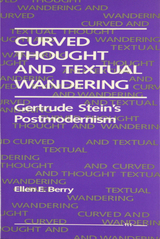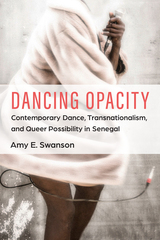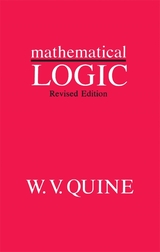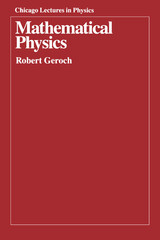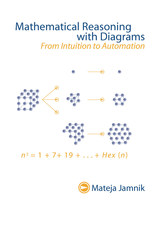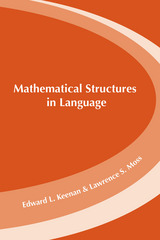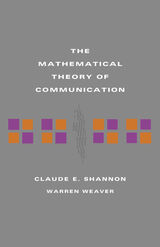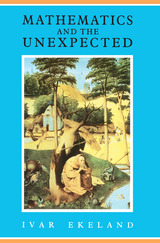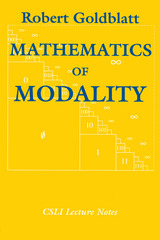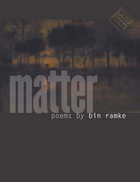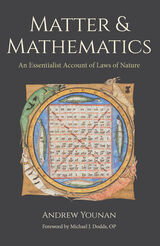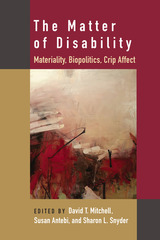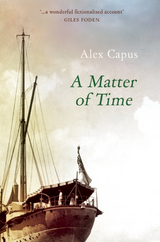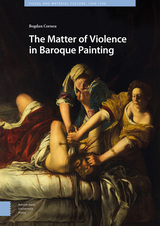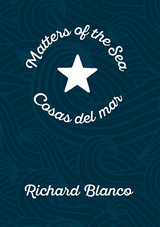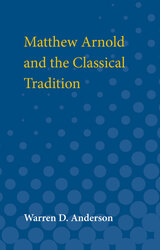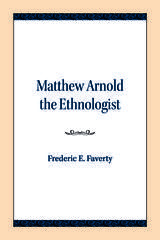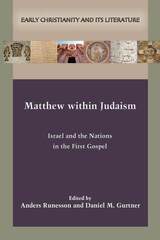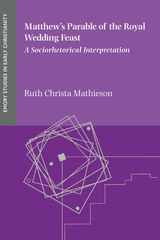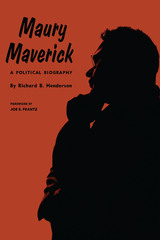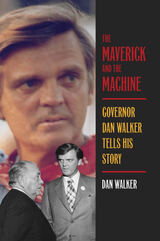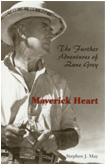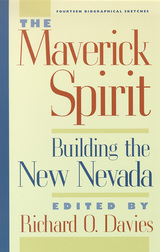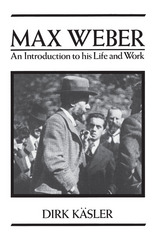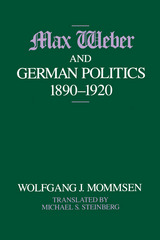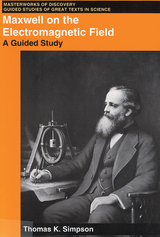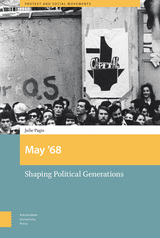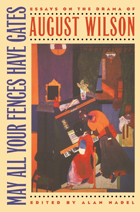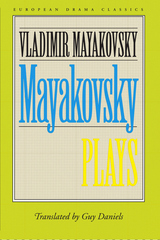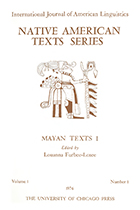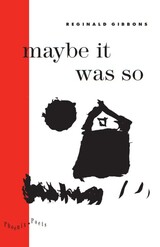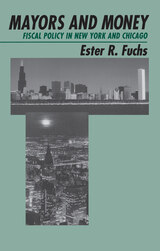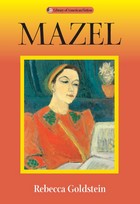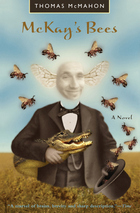 Materials & Techniques in the Decorative Arts: An Illustrated Dictionary
Edited by Lucy Trench
University of Chicago Press, 2000 In our industrialized society, it is often difficult to imagine how the objects around us are made. How, for example, are triple spirals put into the stem of a wine glass or table tops inlaid with whole landscapes of semi-precious stones? This unique dictionary is devoted to the fascinating materials and techniques used in the decorative arts. Materials range from the exotic to the most basic, from rare stones found only in the mountains of Badakshan, unsavory animal products, and the ground bodies of South American insects to ones as common as sand, clay, and lime.
Compiled by a team of experts, each with an intimate knowledge of his or her subject, the entries are written in clear, accessible language and supplemented by numerous photographs and drawings. Each core material (glass, ceramics, textiles, paper, plastics, leather, metal, stone, wood, and paint) is covered from its raw state through any processing or preparation to various craft stages and finally, to any surface finishing.
Traditionally, the kind of information found in these pages has been passed on from craftsman to craftsman or confined to highly specialized books, and even common terms are often misunderstood. This dictionary makes the subject accessible to all—from art and architectural historians, curators, collectors, restoration specialists, artists, and museum staff to decorators, aficionados, and those who enjoy watching Antiques Roadshow. In short, this book is for all those who are intrigued by the materials and techniques used to create the beautiful objects that surround us.
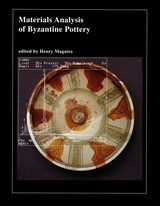 Materials Analysis of Byzantine Pottery
Henry Maguire
Harvard University Press, 1997 This publication brings to a wider audience important new findings in the fields of medieval pottery and archaeometry. After a long period of dormancy, the study of Byzantine pottery has flourished in recent years. At the same time, the discipline of archaeometry has also undergone a rapid expansion. The combining of these two areas of research creates both opportunities and questions.
The new data that materials analysis provides about Byzantine ceramics and their production at times supports, modifies, and even contradicts conclusions derived from traditional archaeological methods. This new ability to determine the technique and provenance of Byzantine pottery has important implications well beyond the study of the material culture itself; it engages with broader historical issues, such as pilgrimage, economic relationships, and the transfer of ceramic technologies from the Islamic world to Byzantium and from Byzantium to Italy.
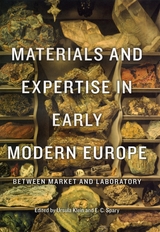 Materials and Expertise in Early Modern Europe: Between Market and Laboratory
Edited by Ursula Klein and E. C. Spary
University of Chicago Press, 2010 It is often assumed that natural philosophy was the forerunner of early modern natural sciences. But where did these sciences’ systematic observation and experimentation get their starts? In Materials and Expertise in Early Modern Europe, the laboratories, workshops, and marketplaces emerge as arenas where hands-on experience united with higher learning. In an age when chemistry, mineralogy, geology, and botany intersected with mining, metallurgy, pharmacy, and gardening, materials were objects that crossed disciplines. Here, the contributors tell the stories of metals, clay, gunpowder, pigments, and foods, and thereby demonstrate the innovative practices of technical experts, the development of the consumer market, and the formation of the observational and experimental sciences in the early modern period. Materials and Expertise in Early Modern Europe showcases a broad variety of forms of knowledge, from ineffable bodily skills and technical competence to articulated know-how and connoisseurship, from methods of measuring, data gathering, and classification to analytical and theoretical knowledge. By exploring the hybrid expertise involved in the making, consumption, and promotion of various materials, and the fluid boundaries they traversed, the book offers an original perspective on important issues in the history of science, medicine, and technology.
 Materials for the Study of Gurung Pe, Volume I
Simon Strickland
Harvard University Press Spoken in the middle hills of Nepal, Gurung is a Tibeto-Burmese language spread along the southern slopes of the Himalayas. The Nepalese Gurung recitations known as pe or pe-da lu-da form a diverse group of oral narratives and invocations, thought to exemplify ritual utterances from the origin of Bon. The pe are performed by a medicine man or shaman, in collaboration with a priest, to promote health and prosperity, and to help with illness and bereavement. They work occasionally with Lamaist practitioners.
This two-volume set includes an analytical introduction, 13,000 lines of annotated transcriptions with interlinear gloss for 92 pe, and a synopsis of a further 49 items representing over 4,000 lines. The material was collected between 1979 and 1992. The introduction outlines the formal properties of pe: structure, metrics, style, figurative language, metaphor, and implicit meanings. This is followed by an overview of patterns of thought in pe, their ontologies, divinities, cosmological order, journeys, use of reported speech, action during discourse, the meanings of the lexical items, and a study of the methods of learning the pe. Appended is a catalog of pe and color plate illustrations. Field recordings of the transcribed pe are included on an accompanying DVD.
 Materials for the Study of Gurung Pe, Volume II
Simon Strickland
Harvard University Press Spoken in the middle hills of Nepal, Gurung is a Tibeto-Burmese language spread along the southern slopes of the Himalayas. The Nepalese Gurung recitations known as pe or pe-da lu-da form a diverse group of oral narratives and invocations, thought to exemplify ritual utterances from the origin of Bon. The pe are performed by a medicine man or shaman, in collaboration with a priest, to promote health and prosperity, and to help with illness and bereavement. They work occasionally with Lamaist practitioners.
This two-volume set includes an analytical introduction, 13,000 lines of annotated transcriptions with interlinear gloss for 92 pe, and a synopsis of a further 49 items representing over 4,000 lines. The material was collected between 1979 and 1992. The introduction outlines the formal properties of pe: structure, metrics, style, figurative language, metaphor, and implicit meanings. This is followed by an overview of patterns of thought in pe, their ontologies, divinities, cosmological order, journeys, use of reported speech, action during discourse, the meanings of the lexical items, and a study of the methods of learning the pe. Appended is a catalog of pe and color plate illustrations. Field recordings of the transcribed pe are included on an accompanying DVD.
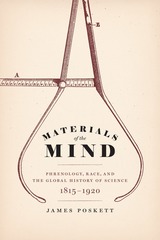 Materials of the Mind: Phrenology, Race, and the Global History of Science, 1815-1920
James Poskett
University of Chicago Press, 2019 This is not only the first global history of nineteenth-century science but the first global history of phrenology.
Phrenology was the most popular mental science of the Victorian age. From American senators to Indian social reformers, this new mental science found supporters around the globe. Materials of the Mind tells the story of how phrenology changed the world—and how the world changed phrenology.
This is a story of skulls from the Arctic, plaster casts from Haiti, books from Bengal, and letters from the Pacific. Drawing on far-flung museum and archival collections, and addressing sources in six different languages, Materials of the Mind is an impressively innovative account of science in the nineteenth century as part of global history. It shows how the circulation of material culture underpinned the emergence of a new materialist philosophy of the mind, while also demonstrating how a global approach to history can help us reassess issues such as race, technology, and politics today.
 Materials Toward the Study of Vasubandhu’s Viṁśikā (I): Sanskrit and Tibetan Critical Editions of the Verses and Autocommentary; An English Translation and Annotations
Jonathan A. Silk
Harvard University Press The “Twenty Verses on Manifestation-Only” of the Indian Buddhist philosopher Vasubandhu (c. 350–430?), his Viṁśíkā, is one of the most important treatises of the Yogācāra school. Accompanied by the author’s own commentary, the text lays out a vision of a “Buddhist Idealism” in which even one’s experience of the sufferings of hell is revealed to be nothing other than the results of working out one’s karma. Later scholars commented on the work a number of times, in its original Sanskrit, in Tibetan translation, and in three Chinese versions.
This book presents an edition and translation of the Sanskrit text of the core verses, alongside the original author’s commentary, based directly on the manuscript evidence. This is accompanied by an edition of the canonical translations of these texts found in the Tibetan Tanjurs, as well as a “draft translation” of the verses in Tibetan, found in a manuscript from Dunhuang. This publication therefore provides the most reliable and comprehensive philological accounting to date for this fundamental work.
 Maternal Body and Voice in Toni Morrison, Bobbie Ann Mason, and Lee Smith
Paula Gallant Eckard
University of Missouri Press, 2002
Throughout human history, motherhood and maternal experience have been largely defined and written by patriarchal culture. Religion, art, medicine, psychoanalysis, and other bastions of male power have objectified the maternal and have disregarded female subjectivity. As a result, maternal perspectives have been ignored and the mother’s voice silenced. In recent literary texts, however, more substantial attention has been given to motherhood and to the physical, psychological, social, and cultural dynamics affecting maternal experience. In Maternal Body and Voice in Toni Morrison, Bobbie Ann Mason, and Lee Smith, Paula Gallant Eckard examines how maternal experience is depicted in selected novels by three American writers, emphasizing how they focus on the body and the voice of the mother. These novels include: The Bluest Eye, Sula, and Beloved by Morrison; In Country, Spence + Lila, and Feather Crowns by Mason; and Oral History, Fair and Tender Ladies, and Saving Grace by Smith.
By employing this focus, these writers lessen the objectification the maternal has received and restore a rich subjectivity that foregrounds the mother’s perspective. Moreover, their fiction reflects a deep concern for history and culture and for a woman’s experience of her world. They challenge the traditional representations of black and white motherhood that have appeared in southern literature and society, rendering complex portrayals of motherhood that defy cultural stereotypes.
Eckard incorporates historical perspectives on African American and southern motherhood, utilizing the works of Elizabeth Fox-Genovese, Sally McMillen, Deborah White, Jacqueline Jones, and others. She draws upon the feminist criticism of Adrienne Rich, Elaine Showalter, Naomi Schor, Tillie Olsen, Karla F. C. Holloway, Barbara Christian, and others, and the linguistic and psychoanalytic theories of Julia Kristeva, Hélène Cixous, and Luce Irigaray. The author also addresses the cross-cultural connections shared by Morrison, Mason, and Smith, showing that, despite their racial and cultural differences, striking similarities can be found in their renderings of maternity.
The three women writers employ related image patterns, metaphors, and symbols involving the maternal body. By centering maternity so strongly in their novels, Morrison, Mason, and Smith establish the primacy of the mother and obviate the neglect to which maternal perspectives have been subjected. They restore the mother’s lost voice and her diminished subjectivity. Together they depict the maternal as a powerful force that shapes human lives and communities.
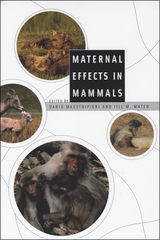 Maternal Effects in Mammals
Edited by Dario Maestripieri and Jill M. Mateo
University of Chicago Press, 2009 Evolutionary maternal effects occur whenever a mother’s phenotypic traits directly affect her offspring’s phenotype, independent of the offspring’s genotype. Some of the phenotypic traits that result in maternal effects have a genetic basis, whereas others are environmentally determined. For example, the size of a litter produced by a mammalian mother—a trait with a strong genetic basis—can affect the growth rate of her offspring, while a mother’s dominance rank—an environmentally determined trait—can affect the dominance rank of her offspring. The first volume published on the subject in more than a decade, Maternal Effects in Mammals reflects advances in genomic, ecological, and behavioral research, as well new understandings of the evolutionary interplay between mothers and their offspring. Dario Maestripieri and Jill M. Mateo bring together a learned group of contributors to synthesize the vast literature on a range of species, highlight evolutionary processes that were previously overlooked, and propose new avenues of research. Maternal Effects in Mammals will serve as the most comprehensive compendium on and stimulus for interdisciplinary treatments of mammalian maternal effects.
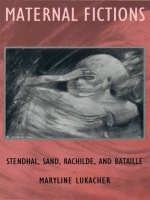 Maternal Fictions: Stendahl, Sand, Rachilde, and Bataille
Maryline Lukacher
Duke University Press, 1994 Stendhal, George Sand, Rachilde, Georges Bataille: Forgoing the patronym, with its weight of meaning, these modern French writers renamed themselves in their work. Their use of pseudonyms, as Maryline Lukacher demonstrates in this provocative study, is part of a process to subvert the name of the father and explore the suppressed relation to the figure of the mother. Combining psychoanalytic criticism, feminist theory, and literary analysis, Maternal Fictions offers a complex psychological portrait of these writers who managed at once to challenge patriarchal authority and at the same time attempt to return to the maternal.
Through readings of Armance, Le Rouge et le noir, La Vie de Henry Brulard, and Les Cenci, Lukacher exposes Stendhal's preoccupation with his dead mother, who is obsessively retrieved throughout his work. George Sand's identity is, in effect, divided between two mothers, her biological mother and her grandmother, and in Histoire de ma vie, Indiana, and Mauprat, we see the writer's efforts to break the impasse created by this divided identity. In the extraordinary but too little known work of Rachilde (Marguerite Eymery), Lukacher finds the maternal figure identified as the secret inner force of patriarchal oppression. This resistance to feminism continues in the pseudonymous work of Georges Bataille. In Ma mère, Le coupable, and L’Expérience intérieure Lukacher traces Bataille’s representation of the mother as a menacing, ever subversive figure who threatens basic social configurations.
Maternal Fictions establishes a new pseudonymous genealogy in modern French writing that will inform and advance our understanding of the act of self-creation that occurs in fiction.
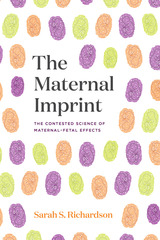 The Maternal Imprint: The Contested Science of Maternal-Fetal Effects
Sarah S. Richardson
University of Chicago Press, 2021 Leading gender and science scholar Sarah S. Richardson charts the untold history of the idea that a woman's health and behavior during pregnancy can have long-term effects on her descendants' health and welfare.
The idea that a woman may leave a biological trace on her gestating offspring has long been a commonplace folk intuition and a matter of scientific intrigue, but the form of that idea has changed dramatically over time. Beginning with the advent of modern genetics at the turn of the twentieth century, biomedical scientists dismissed any notion that a mother—except in cases of extreme deprivation or injury—could alter her offspring’s traits. Consensus asserted that a child’s fate was set by a combination of its genes and post-birth upbringing.
Over the last fifty years, however, this consensus was dismantled, and today, research on the intrauterine environment and its effects on the fetus is emerging as a robust program of study in medicine, public health, psychology, evolutionary biology, and genomics. Collectively, these sciences argue that a woman’s experiences, behaviors, and physiology can have life-altering effects on offspring development.
Tracing a genealogy of ideas about heredity and maternal-fetal effects, this book offers a critical analysis of conceptual and ethical issues—in particular, the staggering implications for maternal well-being and reproductive autonomy—provoked by the striking rise of epigenetics and fetal origins science in postgenomic biology today.
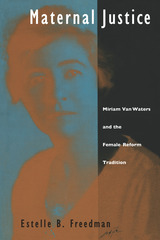 Maternal Justice: Miriam Van Waters and the Female Reform Tradition
Estelle B. Freedman
University of Chicago Press, 1996 Celebrated prison reformer Miriam Van Waters made history for her sensational battle to retain the superintendency of the Massachusetts Reformatory for Women in 1949. Maternal Justice provides a compelling biography of this early lesbian activist by moving beyond the controversy to tell the story of a remarkable woman whose success rested upon the power of her own charismatic leadership.
Estelle B. Freedman draws from Van Waters's diaries, letters, and personal papers to recreate her complex personal life, unveiling the disparity between Van Waters's public persona and her agonized private soul. With the power and elegance of a novel, Maternal Justice illuminates this historical context, casting light on the social welfare tradition, on women's history, on the American feminist movement, and on the history of sexuality.
"Maternal Justice is as much a work of history as it is biography, bringing to life not only a remarkable woman but also the complex political and social milieu within which she worked and lived."—Kelleher Jewett, The Nation
"This sympathetic biography reclaims Van Waters for history."—Publishers Weekly
"The Van Waters legacy, as Freedman gracefully presents, is that she cared about the lives of women behind bars. It is a strikingly unfashionable sentiment today."—Jane Meredith Adams, San Francisco Chronicle Book Review, Editor's Recommended Selection
"This finely crafted biography is both an engrossing read and a richly complicated account of a reformer whose work . . . bridged the eras of voluntarist charitable activism and professional social service."—Sherri Broder, Women's Review of Books
"This is a sympathetic, highly personal biography, revealing of both the author's responses to her subject's life and, in considerable detail, Van Waters's family traumas, illnesses, and love affairs."—Elizabeth Israels Perry, Journal of American History
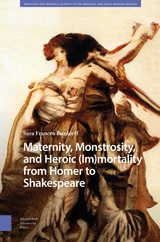 Maternity, Monstrosity, and Heroic (Im)mortality from Homer to Shakespeare
Sara Burdorff
Amsterdam University Press, 2025 This work uses an adaptation of monster theory to rethink the foundations of epic-heroic immortality. Rather than focusing on a specific monster or monsters, the author identifies the “belly-monstrous” as a crucial point of intersection between mothers and warriors in traditional narratives of the Trojan War. Identifying the gestating/digesting belly as the center of the Iliadic world, this groundbreaking approach disrupts androcentric readings of the Iliadic warrior and his ethos, emphasizing the crucial role of female suffering in the generation and preservation of immortal legacy.
The author reconsiders ancient Greek depictions of the Trojan War and its aftermath, including Homeric epic and the tragedies of Aeschylus and Euripides, and illuminates the cohesive patterning of Shakespeare’s “mother-warrior” plays, which place inherited Iliadic-belly-monstrous motifs in conversation with cultural anxieties of late Elizabethan England.
With meticulous scholarship and captivating analysis, Maternity, Monstrosity, and Heroic (Im)mortality from Homer to Shakespeare redefines the relationship between mothers and warriors in the Iliadic-heroic ideal, paving the way for new interpretations of war, grief, and immortal glory in a broad range of literary and cultural contexts.
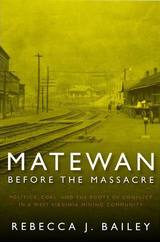 Matewan Before the Massacre: Politics, Coal, and the Roots of Conflict in a West Virginia Mining Community
Rebecca J. Bailey
West Virginia University Press, 2008 On May 19, 1920, gunshots rang through the streets of Matewan, West Virginia, in an event soon known as the “Matewan Massacre.” Most historians of West Virginia and Appalachia see this event as the beginning of a long series of tribulations known as the second Mine Wars. But was it instead the culmination of an even longer series of proceedings that unfolded in Mingo County, dating back at least to the Civil War? Matewan Before the Massacre provides the first comprehensive history of the area, beginning in the late eighteenth century continuing up to the Massacre. It covers the relevant economic history, including the development of the coal mine industry and the struggles over land ownership; labor history, including early efforts of unionization; transportation history, including the role of the N&W Railroad; political history, including the role of political factions in the county’s two major communities—Matewan and Williamson; and the impact of the state’s governors and legislatures on Mingo County.
The Math Mafia: How a Persistent Group of Reformers Standardized American Education
Emily T. Hamilton
University of Alabama Press, 2026 The Math Mafia by Emily T. Hamilton is a historical account of mathematics education reform in twentieth-century America and how that movement played a role in shaping the broader contours of national education policy. Hamilton contends that a cohesive and well-organized community of advocates was instrumental in the rise of standardized testing and curriculum reforms, as well as federal involvement in classrooms, especially during the Cold War. The “mafia” at the center of Hamilton’s story includes mathematicians, educators, and researchers from universities, as well as members of government-funded organizations such as the National Science Foundation and various educational psychology circles. By positioning mathematics as central to national strength and security, these reformers established math education as a key area of federal focus.
Mathematical Logic: Revised Edition
W. V. Quine
Harvard University Press, 1951 W. V. Quine’s systematic development of mathematical logic has been widely praised for the new material presented and for the clarity of its exposition. This revised edition, in which the minor inconsistencies observed since its first publication have been eliminated, will be welcomed by all students and teachers in mathematics and philosophy who are seriously concerned with modern logic.
Max Black, in Mind, has said of this book, “It will serve the purpose of inculcating, by precept and example, standards of clarity and precision which are, even in formal logic, more often pursued than achieved.”
Mathematical Models in the Health Sciences: A Computer-Aided Approach
Eugene Ackerman
University of Minnesota Press, 1979
Mathematical Models in the Health Sciences was first published in 1979.This book, designed especially for use in graduate courses in the health sciences, will be useful also as a reference work for scientists in various disciplines. It provides an introduction to mathematical modeling through the use of selected examples from the health sciences. Where appropriate, computer techniques are discussed and illustrated with examples drawn from studies by the authors and their colleagues. An introductory chapter discusses mathematical models and their roles in biomedical research. The rest of the material is divided in three sections of four chapters each: Deterministic Models, Time Series Analysis, and Information and Simulation. A bibliography accompanies each chapter. In their conclusion the authors place mathematical biology and its techniques in perspective.
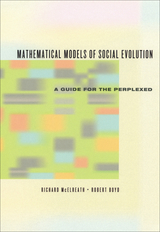 Mathematical Models of Social Evolution: A Guide for the Perplexed
Richard McElreath and Robert Boyd
University of Chicago Press, 2007 Over the last several decades, mathematical models have become central to the study of social evolution, both in biology and the social sciences. But students in these disciplines often seriously lack the tools to understand them. A primer on behavioral modeling that includes both mathematics and evolutionary theory, Mathematical Models of Social Evolution aims to make the student and professional researcher in biology and the social sciences fully conversant in the language of the field.
Teaching biological concepts from which models can be developed, Richard McElreath and Robert Boyd introduce readers to many of the typical mathematical tools that are used to analyze evolutionary models and end each chapter with a set of problems that draw upon these techniques. Mathematical Models of Social Evolution equips behaviorists and evolutionary biologists with the mathematical knowledge to truly understand the models on which their research depends. Ultimately, McElreath and Boyd’s goal is to impart the fundamental concepts that underlie modern biological understandings of the evolution of behavior so that readers will be able to more fully appreciate journal articles and scientific literature, and start building models of their own.
Mathematical Physics
Robert Geroch
University of Chicago Press, 1984 Mathematical Physics is an introduction to such basic mathematical structures as groups, vector spaces, topological spaces, measure spaces, and Hilbert space. Geroch uses category theory to emphasize both the interrelationships among different structures and the unity of mathematics. Perhaps the most valuable feature of the book is the illuminating intuitive discussion of the "whys" of proofs and of axioms and definitions. This book, based on Geroch's University of Chicago course, will be especially helpful to those working in theoretical physics, including such areas as relativity, particle physics, and astrophysics.
Mathematical Quantum Physics for Engineers and Technologists: Fundamentals
Alireza Baghai-Wadji
The Institution of Engineering and Technology, 2023 Continuing size reduction in mesoscopic and nanoscopic electronic, photonic, and plasmonic devices makes the employment of quantum physics (QP) and quantum electrodynamics (QED) inevitable. Engineers at the forefront of these fields increasingly need to have a working knowledge of QP and, more importantly, feel confident to manoeuver through the intricate calculations involved. However, electrical engineers and applied physicists are typically unfamiliar with the sophisticated mathematical apparatus in QP and QED, which is generally perceived to be formidably abstract.
Mathematical Quantum Physics for Engineers and Technologists: Fundamentals, Volume 1
Alireza Baghai-Wadji
The Institution of Engineering and Technology, 2023 Continuing size reduction in mesoscopic and nanoscopic electronic, photonic, and plasmonic devices makes the employment of quantum physics (QP) and quantum electrodynamics (QED) inevitable. Engineers at the forefront of these fields increasingly need to have a working knowledge of QP and, more importantly, feel confident to manoeuver through the intricate calculations involved. However, electrical engineers and applied physicists are typically unfamiliar with the sophisticated mathematical apparatus in QP and QED, which is generally perceived to be formidably abstract.
Mathematical Quantum Physics for Engineers and Technologists: Governing equations, Volume 2
Alireza Baghai-Wadji
The Institution of Engineering and Technology, 2024 Continuing size reduction in mesoscopic and nanoscopic electronic, photonic, and plasmonic devices makes the employment of quantum physics (QP) and quantum electrodynamics (QED) inevitable. Engineers at the forefront of these fields increasingly need to have a working knowledge of QP and, more importantly, feel confident to manoeuver through the intricate calculations involved. However, electrical engineers and applied physicists are typically unfamiliar with the sophisticated mathematical apparatus in QP and QED, which is generally perceived to be formidably abstract.
Mathematical Reasoning with Diagrams
Mateja Jamnik
CSLI, 2001 Mathematicians at every level use diagrams to prove theorems. Mathematical Reasoning with Diagrams investigates the possibilities of mechanizing this sort of diagrammatic reasoning in a formal computer proof system, even offering a semi-automatic formal proof system—called Diamond—which allows users to prove arithmetical theorems using diagrams.
Mathematical Structures in Languages
Edward Keenan and Larry Moss
CSLI, 2015 Mathematical Structures in Languages introduces a number of mathematical concepts that are of interest to the working linguist. The areas covered include basic set theory and logic, formal languages and automata, trees, partial orders, lattices, Boolean structure, generalized quantifier theory, and linguistic invariants, the last drawing on Edward L. Keenan and Edward Stabler’s Bare Grammar: A Study of Language Invariants, also published by CSLI Publications. Ideal for advanced undergraduate and graduate students of linguistics, this book contains numerous exercises and will be a valuable resource for courses on mathematical topics in linguistics. The product of many years of teaching, Mathematic Structures in Languages is very much a book to be read and learned from.
The Mathematical Theory of Communication
Claude E. Shannon and Warren Weaver
University of Illinois Press, 1998 Scientific knowledge grows at a phenomenal pace--but few books have had as lasting an impact or played as important a role in our modern world as The Mathematical Theory of Communication, published originally as a paper on communication theory more than fifty years ago. Republished in book form shortly thereafter, it has since gone through four hardcover and sixteen paperback printings. It is a revolutionary work, astounding in its foresight and contemporaneity. The University of Illinois Press is pleased and honored to issue this commemorative reprinting of a classic.
 Mathematics and Computers in Archaeology
J. E. Doran and F. R. Hodson
Harvard University Press This book is for students and practitioners of archaeology. It offers an introductory survey of all the applications of mathematical and statistical techniques to their work. These applications are increasingly concerned with computerized data classification and quantification, and their effect is to reduce the level of uncertainty in the interpretation of the evidence that time and chance have left. Any archaeologist wanting to find out what these new methods have to offer has hitherto been forced to search for information in the specialist handbooks, conference proceedings, and review articles of his own, and very often of other, disciplines. This book brings the information conveniently together, so far as it pertains to archaeology, and permits an assessment of its relevance and quality.
Those who have been daunted by the specialist knowledge apparently demanded will now be able to acquire a thorough grasp of principles and practices. Only an elementary knowledge of mathematics is presumed throughout. Part 1 provides a brief introduction to basic concepts in archaeology and mathematics. Part 2 relates the standard archaeological techniques and procedures to mathematics; it concentrates on numerical approaches best suited to archaeological practices. Part 3 examines various automatic seriation techniques and discusses further work that is coming to play an essential part in the development of archaeology.
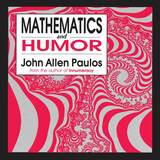 Mathematics and Humor
John Allen Paulos
University of Chicago Press, 1982 John Allen Paulos cleverly scrutinizes the mathematical structures of jokes, puns, paradoxes, spoonerisms, riddles, and other forms of humor, drawing examples from such sources as Rabelais, Shakespeare, James Beattie, René Thom, Lewis Carroll, Arthur Koestler, W. C. Fields, and Woody Allen.
"Jokes, paradoxes, riddles, and the art of non-sequitur are revealed with great perception and insight in this illuminating account of the relationship between humor and mathematics."—Joseph Williams, New York Times
"'Leave your mind alone,' said a Thurber cartoon, and a really complete and convincing analysis of what humour is might spoil all jokes forever. This book avoids that danger. What it does. . .is describe broadly several kinds of mathematical theory and apply them to throw sidelights on how many kinds of jokes work."—New Scientist
"Many scholars nowadays write seriously about the ludicrous. Some merely manage to be dull. A few—like Paulos—are brilliant in an odd endeavor."—Los Angeles Times Book Review
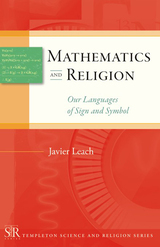 Mathematics and Religion: Our Languages of Sign and Symbol
Javier Leach
Templeton Press, 2010 Mathematics and Religion: Our Languages of Sign and Symbol is the sixth title published in the Templeton Science and Religion Series, in which scientists from a wide range of fields distill their experience and knowledge into brief tours of their respective specialties. In this volume, Javier Leach, a mathematician and Jesuit priest, leads a fascinating study of the historical development of mathematical language and its influence on the evolution of metaphysical and theological languages. Leach traces three historical moments of change in this evolution: the introduction of the deductive method in Greece, the use of mathematics as a language of science in modern times, and the formalization of mathematical languages in the nineteenth and twentieth centuries. As he unfolds this fascinating history, Leach notes the striking differences and interrelations between the two languages of science and religion. Until now there has been little reflection on these similarities and differences, or about how both languages can complement and enrich each other.
Mathematics and the Unexpected
Ivar Ekeland
University of Chicago Press, 1988 "Not the least unexpected thing about Mathematics and the Unexpected is that a real mathematician should write not just a literate work, but a literary one."—Ian Stewart, New Scientist
"In this brief, elegant treatise, assessable to anyone who likes to think, Ivar Ekelund explains some philosophical implications of recent mathematics. He examines randomness, the geometry involved in making predictions, and why general trends are easy to project (it will snow in January) but particulars are practically impossible (it will snow from 2 p.m. to 5 p.m. on the 21st)."—Village Voice
Mathematics of Modality
Robert Goldblatt
CSLI, 1993 Modal logic is the study of modalities—expressions that qualify assertions about the truth of statements—like some ordinary language phrases and mathematically motivated expressions. The study of modalities dates from antiquity, but has been most actively pursued in the last three decades. This volume collects together a number of Golblatt's papers on modal logic, beginning with his work on the duality between algebraic and set-theoretic models, and including two new articles, one on infinitary rules of inference, and the other about recent results on the relationship between modal logic and first-order logic.
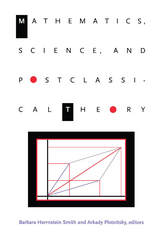 Mathematics, Science, and Postclassical Theory
Barbara Herrnstein Smith and Arkady Plotnitsky, eds.
Duke University Press, 1997 Mathematics, Science, and Postclassical Theory is a unique collection of essays dealing with the intersections between science and mathematics and the radical reconceptions of knowledge, language, proof, truth, and reality currently emerging from poststructuralist literary theory, constructivist history and sociology of science, and related work in contemporary philosophy. Featuring a distinguished group of international contributors, this volume engages themes and issues central to current theoretical debates in virtually all disciplines: agency, causality, determinacy, representation, and the social dynamics of knowledge. In a substantive introductory essay, the editors explain the notion of "postclassical theory" and discuss the significance of ideas such as emergence and undecidability in current work in and on science and mathematics. Other essays include a witty examination of the relations among mathematical thinking, writing, and the technologies of virtual reality; an essay that reconstructs the conceptual practices that led to a crucial mathematical discovery—or construction—in the 19th century; a discussion of the implications of Bohr’s complementarity principle for classical ideas of reality; an examination of scientific laboratories as "hybrid" communities of humans and nonhumans; an analysis of metaphors of control, purpose, and necessity in contemporary biology; an exploration of truth and lies, and the play of words and numbers in Shakespeare, Frege, Wittgenstein, and Beckett; and a final chapter on recent engagements, or nonengagements, between rationalist/realist philosophy of science and contemporary science studies.
Contributors. Malcolm Ashmore, Michel Callon, Owen Flanagan, John Law, Susan Oyama, Andrew Pickering, Arkady Plotnitsky, Brian Rotman, Barbara Herrnstein Smith, John Vignaux Smyth, E. Roy Weintraub
Mathews’ Chinese–English Dictionary (A Chinese–English Dictionary Compiled for the China Inland Mission): Revised American Edition
Robert Henry Mathews
Harvard University Press This volume meets the demand for a small dictionary which is at the same time comprehensive enough for the needs of the ordinary student. It contains 7,773 Chinese characters and 104,000 compounds taken from the classics, general literature, magazines, and newspapers. Published in 1931, it has been thoroughly revised and brought up to date in this new edition. All necessary corrections in regard to pronunciation have been made; the tones of the characters have been checked; and a large number of new terms have been added in order to facilitate the reading of contemporary periodicals and newspapers—whether political, economic, chemical, or military.
 Mathias Spahlinger
Neil Thomas Smith
Intellect Books, 2021 The first book-length study in English of composer Mathias Spahlinger, one of Germany’s leading practitioners of contemporary music.
One of the most stimulating and provocative figures of the new music scene, Mathias Spahlinger has long been a touchstone for leftist, “critical” composition in Germany, yet his work has received very little attention in Anglophone scholarship until now.
Spahlinger’s practice offers a unique negotiation of the modernist legacy as well as passionate political and philosophical engagement. Born in 1944, today his position as one of the most venerable exponents of post-WWII modernism in his homeland is undeniable: his music is regularly performed, he has received commissions from many of the major orchestras and new music groups in Germany, and in 2014 he received the Berliner Kunstpreis, Berlin’s top art prize.
Bringing a critical perspective to Spahlinger’s life and work, this monograph provides an essential reference for scholars of new music and twentieth-century modernism.
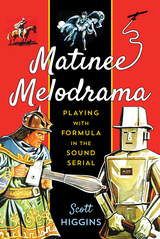 Matinee Melodrama: Playing with Formula in the Sound Serial
Higgins, Scott
Rutgers University Press, 2016 Long before Batman, Flash Gordon, or the Lone Ranger were the stars of their own TV shows, they had dedicated audiences watching their adventures each week. The difference was that this action took place on the big screen, in short adventure serials whose exciting cliffhangers compelled the young audience to return to the theater every seven days.
Matinee Melodrama is the first book about the adventure serial as a distinct artform, one that uniquely encouraged audience participation and imaginative play. Media scholar Scott Higgins proposes that the serial’s incoherent plotting and reliance on formula, far from being faults, should be understood as some of its most appealing attributes, helping to spawn an active fan culture. Further, he suggests these serials laid the groundwork not only for modern-day cinematic blockbusters like Star Wars and Raiders of the Lost Ark, but also for all kinds of interactive media that combine spectacle, storytelling, and play.
As it identifies key elements of the serial form—from stock characters to cliffhangers—Matinee Melodrama delves deeply into questions about the nature of suspense, the aesthetics of action, and the potentials of formulaic narrative. Yet it also provides readers with a loving look at everything from Zorro’s Fighting Legion to Daredevils of the Red Circle, conveying exactly why these films continue to thrill and enthrall their fans.
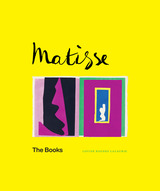 Matisse: The Books
Louise Rogers Lalaurie
University of Chicago Press, 2020 The livre d’artiste, or “artist’s book,” is among the most prized in rare book collections. Henri Matisse (1869–1954) was one of the greatest artists to work in this genre, and he created his most important during a period of intense personal and physical suffering. Brimming with powerful themes and imagery, these works are crucial to understanding Matisse’s oeuvre.
With deftness and sensitivity, Louise Rogers Lalaurie reintroduces us to Matisse by considering how in each volume, Matisse constructed an intriguing dialogue between word and image. Examining this page-by-page interplay, translating key sequences, and discussing the books’ distinct themes and production histories, Lalaurie offers the thoughtful analysis these works deserve. Together Matisse’s artist books reveal his deep engagement with questions of beauty and truth; his faith; his perspectives on aging, loss, and inspiration; and his relationship to his critics, the French art establishment, and the women in his life. In addition, Lalaurie illuminates Matisse’s often misunderstood political affinities—though Matisse was vilified in his time for choosing to live in the collaborationist Vichy zone, his wartime books reveal a body of work that stands as a deeply personal statement of resistance.
Lavishly illustrated, Matisse: The Books showcases a rich group of underappreciated works and brings unprecedented clarity to a controversial period in the artist’s life.
MATLAB® for Electrical and Computer Engineering Students and Professionals: With Simulink®
Roland Priemer
The Institution of Engineering and Technology, 2013 This book combines the teaching of the MATLAB® programming language with the presentation and development of carefully selected electrical and computer engineering (ECE) fundamentals. This is what distinguishes it from other books concerned with MATLAB®: it is directed specifically to ECE concerns. Students will see, quite explicitly, how and why MATLAB® is well suited to solve practical ECE problems.
 Matrices of Genre: Authors, Canons, and Society
Mary Depew
Harvard University Press, 2000 The literary genres given shape by the writers of classical antiquity are central to our own thinking about the various forms literature takes. Examining those genres, the essays collected here focus on the concept and role of the author and the emergence of authorship out of performance in Greece and Rome.
In a fruitful variety of ways the contributors to this volume address the questions: what generic rules were recognized and observed by the Greeks and Romans over the centuries; what competing schemes were there for classifying genres and accounting for literary change; and what role did authors play in maintaining and developing generic contexts? Their essays look at tragedy, epigram, hymns, rhapsodic poetry, history, comedy, bucolic poetry, prophecy, Augustan poetry, commentaries, didactic poetry, and works that "mix genres."
The contributors bring to this analysis a wide range of expertise; they are, in addition to the editors, Glenn W. Most, Joseph Day, Ian Rutherford, Deborah Boedeker, Eric Csapo, Marco Fantuzzi, Stephanie West, Alessandro Barchiesi, Ineke Sluiter, Don Fowler, and Stephen Hinds. The essays are drawn from a colloquium at Harvard's Center for Hellenic Studies.
Matrix Factorization for Multimedia Clustering: Models, techniques, optimization and applications
Hangjun Che
The Institution of Engineering and Technology, 2025 Clustering is a fundamental problem in multimedia information processing. This co-authored book explores clustering principles through advanced data analysis techniques, such as matrix and tensor factorization, which are highly relevant for multimedia information processing. Multimedia data may exhibit various forms of noise represented from multiple perspectives, making traditional clustering approaches less effective. The authors consider complex conditions such as noise sensitivity and discuss methods to address these challenges in the context of multimedia data. They also examine popular regularization techniques, providing theoretical analyses that demonstrate the relationship between regularization and clustering performance.
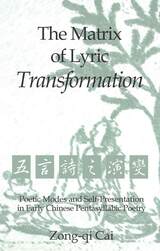 The Matrix of Lyric Transformation: Poetic Modes and Self-Presentation in Early Chinese Pentasyllabic Poetry
Cai Zong-qi
University of Michigan Press, 1997 Pentasyllabic poetry has been a focus of critical study since the appearance of the earliest works of Chinese literary criticism in the Six Dynasties period. Throughout the subsequent dynasties, traditional Chinese critics continued to examine pentasyllabic poetry as a leading poetic type and to compile various comprehensive anthologies of it. The Matrix of Lyric Transformation enriches this tradition, using modern analytical methods to explore issues of self-expression and to trace the early formal, thematic, and generic developments of this poetic form. Beginning with a discussion of the Yüeh-fu and ku-shih genres of the Han period, Cai Zong-qi introdues the analytical framework of modes from Western literary criticism to show how the pentasyllabic poetry changed over time. He argues that changing practices of poetic composition effected a shift from a dramatic mode typical of folk compositions to a narrative mode and finally to lyric and symbolic modes developed in literati circles.
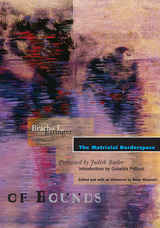 The Matrixial Borderspace
Bracha Ettinger
University of Minnesota Press, 2006 Artist, psychoanalyst, and feminist theorist Bracha Ettinger presents an original theoretical exploration of shared affect and emergent expression, across the thresholds of identity and memory. Ettinger works through Lacan’s late works, the anti-Oedipal perspectives of Deleuze and Guattari, as well as object-relations theory to critique the phallocentrism of mainstream Lacanian theory and to rethink the masculine-feminine opposition. She replaces the phallic structure with a dimension of emergence, where objects, images, and meanings are glimpsed in their incipiency, before they are differentiated. This is the matrixial realm, a shareable, psychic dimension that underlies the individual unconscious and experience.
Concerned with collective trauma and memory, Ettinger’s own experience as an Israeli living with the memory of the Holocaust is a deep source of inspiration for her paintings, several of which are reproduced in the book. The paintings, like the essays, replay the relation between the visible and invisible, the sayable and ineffable; the gaze, the subject, and the other.
Bracha Ettinger is a painter and a senior clinical psychologist. She is professor of psychoanalysis and aesthetics at the University of Leeds, England, and Bezalel Academy, Jerusalem.
Judith Butler is professor of rhetoric and comparative literature at the University of California, Berkeley. Griselda Pollock is professor of fine arts at the University of Leeds. Brian Massumi is professor of communication at the University of Montreal.
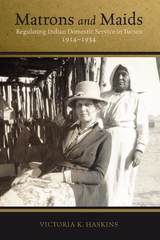 Matrons and Maids: Regulating Indian Domestic Service in Tucson, 1914–1934
Victoria K. Haskins
University of Arizona Press, 2012 From 1914 to 1934 the US government sent Native American girls to work as domestic servants in the homes of white families. Matrons and Maids tells this forgotten history through the eyes of the women who facilitated their placements. During those two decades, “outing matrons” oversaw and managed the employment of young Indian women. In Tucson, Arizona, the matrons acted as intermediaries between the Indian and white communities and between the local Tucson community and the national administration, the Office of Indian Affairs.
Based on federal archival records, Matrons and Maids offers an original and detailed account of government practices and efforts to regulate American Indian women. Haskins demonstrates that the outing system was clearly about regulating cross-cultural interactions, and she highlights the roles played by white women in this history. As she compellingly argues, we cannot fully engage with cross-cultural histories without examining the complex involvement of white women as active, if ambivalent, agents of colonization.
Including stories of the entwined experiences of Indigenous and non-Indigenous women that range from the heart-warming to the heart-breaking, Matrons and Maids presents a unique perspective on the history of Indian policy and the significance of “women’s work.”
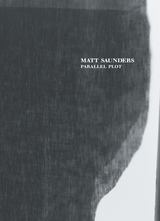 Matt Saunders: Parallel Plot
Matt Saunders
University of Chicago Press, 2013 Berlin-based artist Matt Saunders has in recent years captured the art world’s eye with a striking series of hybrid images and animated films produced using techniques from both photography and painting. Using movie stars such as German actress Hertha Thiele and British actor Patrick McGoohan as subjects, Saunders recasts historical film and television images into new discourses about portraiture, iconography, and spectatorship. Matt Saunders: Parallel Plot is both an artist’s book and a catalog that documents and reflects on a 2010 exhibition held at the Renaissance Society at the University of Chicago. Reproducing the stunning artwork from that show, the book also includes two conversations between Saunders and artist Josiah McElheny and an essay by experimental film scholar Bruce Jenkins that tackles the relationship among painting, photography, and film, as well as the dynamics of Saunders’s iconography. Offering insight into Saunders’s sophisticated working methods, this book is an evocative introduction to the work of this intriguing artist and the intertwined histories of film and photography.
Matter
Bin Ramke
University of Iowa Press, 2004 Bin Ramke’s poetry has always been concerned with separating the real from the wished-for or the feared. In Matter, Ramke investigates not only the physical realities of our world but the qualities that make things important to us, that give them weight. These poems, often in the voice of a child, are full of yearning and anguish but also an appreciation for the enhanced perceptions and small pleasures to be found among the sadness. “All lost things have the same voice,” he says, and this universal voice reminds us of home and family and the simple connections of ordinary life—the things that matter.
“When I was a saint,” begins the first poem, “I did not have visions but I could see and did note the color of the world.” Matter is an examination of and a report on the world’s variable colors and possibilities for, if not sanctity, then a certain sanity, a kindness, and some form of salvation.
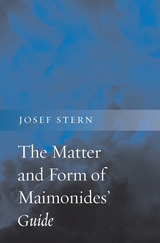 The Matter and Form of Maimonides’ Guide
Josef Stern
Harvard University Press, 2013 Maimonides’ Guide of the Perplexed has traditionally been read as an attempt to harmonize reason and revelation. Another, more recent interpretation takes the contradiction between philosophy and religion to be irreconcilable, and concludes that the Guide prescribes religion for the masses and philosophy for the elite. Moving beyond these familiar debates, Josef Stern argues that the perplexity addressed in this famously enigmatic work is not the conflict between Athens and Jerusalem but the tension between human matter and form, between the body and the intellect.
Maimonides’ philosophical tradition takes the perfect life to be intellectual: pure, undivided contemplation of all possible truths, from physics and cosmology to metaphysics and God. According to the Guide, this ideal cannot be realized by humans. Their embodied minds cannot achieve scientific knowledge of metaphysics, and their bodily impulses interfere with exclusive contemplation. Closely analyzing the arguments in the Guide and its original use of the parable as a medium of philosophical writing, Stern articulates Maimonides’ skepticism about human knowledge of metaphysics and his heterodox interpretations of scriptural and rabbinic parables. Stern shows how, in order to accommodate the conflicting demands of the intellect and the body, Maimonides creates a repertoire of spiritual exercises, reconceiving the Mosaic commandments as training for the life of the embodied mind. By focusing on the philosophical notions of matter and form, and the interplay between its literary form and subject matter, Stern succeeds in developing a unified, novel interpretation of the Guide.
Matter and Mathematics: An Essential Account of Laws of Nature
Andrew Younan
Catholic University of America Press, 2022 To borrow a phrase from Galileo: What does it mean that the story of the creation is “written in the language of mathematics?” This book is an attempt to understand the natural world, its consistency, and the ontology of what we call laws of nature, with a special focus on their mathematical expression. It does this by arguing in favor of the Essentialist interpretation over that of the Humean and Anti-Humean accounts. It re-examines and critiques Descartes’ notion of laws of nature following from God’s activity in the world as mover of extended bodies, as well as Hume’s arguments against causality and induction. It then presents an Aristotelian-Thomistic account of laws of nature based on mathematical abstraction, necessity, and teleology, finally offering a definition for laws of nature within this framework.
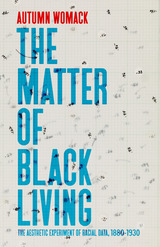 The Matter of Black Living: The Aesthetic Experiment of Racial Data, 1880–1930
Autumn Womack
University of Chicago Press, 2022 Examining how turn-of-the-century Black cultural producers’ experiments with new technologies of racial data produced experimental aesthetics.
As the nineteenth century came to a close and questions concerning the future of African American life reached a fever pitch, many social scientists and reformers approached post-emancipation Black life as an empirical problem that could be systematically solved with the help of new technologies like the social survey, photography, and film. What ensued was nothing other than a “racial data revolution,” one which rendered African American life an inanimate object of inquiry in the name of social order and racial regulation. At the very same time, African American cultural producers and intellectuals such as W. E. B. Du Bois, Kelly Miller, Sutton Griggs, and Zora Neale Hurston staged their own kind of revolution, un-disciplining racial data in ways that captured the dynamism of Black social life.
The Matter of Black Living excavates the dynamic interplay between racial data and Black aesthetic production that shaped late nineteenth-century social, cultural, and literary atmosphere. Through assembling previously overlooked archives and seemingly familiar texts, Womack shows how these artists and writers recalibrated the relationship between data and Black life. The result is a fresh and nuanced take on the history of documenting Blackness. The Matter of Black Living charts a new genealogy from which we can rethink the political and aesthetic work of racial data, a task that has never been more urgent.
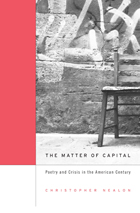 The Matter of Capital: Poetry and Crisis in the American Century
Christopher Nealon
Harvard University Press, 2011 In this highly original reexamination of North American poetry in English from Ezra Pound to the present day, Christopher Nealon demonstrates that the most vital writing of the period is deeply concerned with capitalism. This focus is not exclusive to the work of left-wing poets: the problem of capitalism’s effect on individuals, communities, and cultures is central to a wide variety of poetry, across a range of political and aesthetic orientations. Indeed, Nealon asserts, capitalism is the material out of which poetry in English has been created over the last century.
Much as poets of previous ages continually examined topics such as the deeds of King Arthur or the history of Troy, poets as diverse as Jack Spicer, John Ashbery, and Claudia Rankine have taken as their “matter” the dynamics and impact of capitalism—not least its tendency to generate economic and political turmoil. Nealon argues persuasively that poets’ attention to the matter of capital has created a corresponding notion of poetry as a kind of textual matter, capable of dispersal, retrieval, and disguise in times of crisis. Offering fresh readings of canonical poets from W. H. Auden to Adrienne Rich, as well as interpretations of younger writers like Kevin Davies, The Matter of Capital reorients our understanding of the central poetic project of the last century.
 A Matter of Choices: Memoirs of a Female Physicist
Fay Ajzenberg-Selove
Rutgers University Press, 1994 When Fay Ajzenberg-Selove became a nuclear physicist, the number of women in the field could be counted on one hand. In this engaging memoir, Fay Ajzenberg-Selove writes candidly about her difficult journey to international recognition in physics. She is frank about the ways being a woman has made a difference in her opportunities and choices as a scientist--and how, by being a woman, she has made a difference in the world of physics.
Ajzenberg-Selove came to America at the age of 15 after narrowly escaping the Nazi takeover of France. She had planned to become an engineer like her father, but switched to physics after she was told the only engineering jobs open to women were in drafting: Marie Curie's example proved to her that women could do physics. Her first attempt at graduate work at Columbia University was a disaster, but she was sturck with the intellectual beauty of the field. After taking a Ph.D. in physics at University of Wisconsin, she did post-doctoral work with Thomas Lauritsen at the California Institute of Technology, where she began writing the first of a series of major review papers on the nuclear spectroscopy of the light nuclei, a subject of fundamental importance to nuclear physics, astrophysics, and applied physics. She continued this work and experimental research for thirty-eight years while teaching at Boston University, Haverford College, and the University of Pennsylvania.
During her early career, Ajzenberg-Selove was shielded by her male mentors from experiencing much of the discrimination directed against women in science. Her simultaneous battles to become a tenured professor and to overcome breast cancer opened her eyes and confirmed her as a feminist.
The lay reader and the scientist alike will be fascinated by Ajzenberg-Selove's clear portrayal of her interlinked lives as physicist, teacher, wife of particle physicist, Walter Selove, and a woman who relishes both competition and friendship in a male-dominated field. An invaluable book for anyone contemplating a career in science.
The Matter of Disability: Materiality, Biopolitics, Crip Affect
David T. Mitchell, Susan Antebi, and Sharon L. Snyder, Editors
University of Michigan Press, 2019 The Matter of Disability returns disability to its proper place as an ongoing historical process of corporeal, cognitive, and sensory mutation operating in a world of dynamic, even cataclysmic, change. The book’s contributors offer new theorizations of human and nonhuman embodiments and their complex evolutions in our global present, in essays that explore how disability might be imagined as participant in the “complex elaboration of difference,” rather than something gone awry in an otherwise stable process. This alternative approach to materiality sheds new light on the capacities that exist within the depictions of disability that the book examines, including Spider-Man, Of Mice and Men, and Bloodchild.
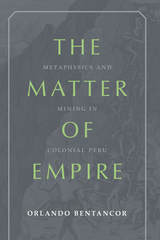 The Matter of Empire: Metaphysics and Mining in Colonial Peru
Orlando Bentancor
University of Pittsburgh Press, 2016 The Matter of Empire examines the philosophical principles invoked by apologists of the Spanish empire that laid the foundations for the material exploitation of the Andean region between 1520 and 1640. Centered on Potosi, Bolivia, Orlando Bentancor’s original study ties the colonizers’ attempts to justify the abuses wrought upon the environment and the indigenous population to their larger ideology concerning mining, science, and the empire's rightful place in the global sphere. Bentancor points to the underlying principles of scholasticism, particularly in the work of Thomas Aquinas, as the basis of the instrumentalist conception of matter and enslavement, despite the inherent contradictions to moral principles. Bentancor grounds this metaphysical framework in a close reading of sixteenth-century debates on Spanish sovereignty in the Americas and treatises on natural history and mining by theologians, humanists, missionaries, mine owners, jurists, and colonial officials. To Bentancor, their presuppositions were a major turning point for colonial expansion and paved the way to global mercantilism.
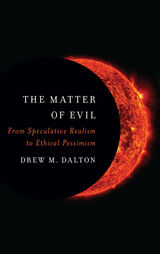 The Matter of Evil: From Speculative Realism to Ethical Pessimism
Drew M. Dalton
Northwestern University Press, 2024 A provocative and entirely new account of ethical reasoning that reconceives the traditional understanding of ethical action negatively
In this radical reconsideration of ethical reasoning in contemporary European philosophy, Drew M. Dalton makes the case for an absolutely grounded account of ethical normativity developed from a scientifically informed and purely materialistic metaphysics. Expanding on speculative realist arguments, Dalton argues that the limits placed on the nature of ethical judgments by Kant’s critique can be overcome through a moral evaluation of the laws of nature—specifically, the entropic principle that undergirds the laws of physics, chemistry, and biology. In order to extract a moral meaning from this simple material fact, Dalton scrutinizes the presumptions of classical accounts and traditional understandings of good and evil within the history of Western philosophy and ultimately asserts that ethical normativity can be reestablished absolutely without reverting to dogmatism.
By overturning our assumptions about the nature and value of reality, The Matter of Evil: From Speculative Realism to Ethical Pessimism presents a provocative new model of ethical responsibility that is both logically justifiable and scientifically sound. Dalton argues for “ethical pessimism,” a position previously marginalized in the West, as a means to cultivate an account of ethical responsibility and political activism that takes seriously the unbecoming of being and the moral horror of existence.
 A Matter of Facts: The Value of Evidence in an Information Age
Laura A. Millar
American Library Association, 2019 “Like Orwell and Bradbury, like Stanley and Siskind, Laura Millar has written a book that people in the future will look back on and say, ‘This is one of the books that helped us to survive until a new era.’” — from the Foreword by Lee McIntyre The safeguarding of authentic facts is essential, especially in this disruptive Orwellian age, where digital technologies have opened the door to a post-truth world in which “alternative facts” can be so easily accepted as valid. And because facts matter, evidence matters. In this urgent manifesto, archives luminary Millar makes the case that authentic and accurate records, archives, data, and other sources of documentary proof are crucial in supporting and fostering a society that is respectful, democratic, and self-aware. An eye-opening treatise for the general public, an invaluable resource for archives students, and a provocative call-to-arms for information and records professionals, Millar’s book - explains the concept of evidence and discusses the ways in which records, archives, and data are not just useful tools for our daily existence but also essential sources of evidence both today and in the future;
- includes plentiful examples that illustrate the critical role evidence plays in upholding rights, enforcing responsibilities, tracing family or community stories, and capturing and sharing memories; and
- examines the impact of digital technologies on how records and information are created and used.
With documentary examples ranging from Mesopotamian clay tablets to World War II photographs to today’s Twitter messages and Facebook posts, Millar’s stirring book will encourage readers to understand more fully the importance of their own records and archives, for themselves and for future generations.
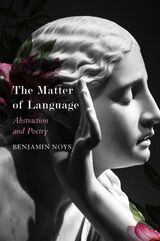 The Matter of Language: Abstraction and Poetry
Benjamin Noys
Seagull Books, 2023 A critical intervention on the relationship between language and matter.
If the twentieth century was the century in which language was at the center of thought, the twenty-first century has, so far, been the century of matter. The Matter of Language is a critical intervention that aims to return to the relationship between language and matter to think of our present moment as one dominated by abstractions that rule our lives. In a series of dated chapters, that form punctual moments of intervention, this book both rehabilitates key thinkers, like Marx, Freud, and Saussure, and engages with poetic thinking on matter in David Jones, Diane di Prima, William Blake, Leslie Kaplan, and others. It is a matter of understanding language as a site of struggle, which is intimately bound to the material but also crucial in formulating and expressing the material and the abstractions that shape language and matter. Working between theory and poetry, The Matter of Language reconceives notions of alienation and class struggle as essential modes of reading and analysis for our fractured present.
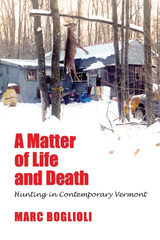 A Matter of Life and Death: Hunting in Contemporary Vermont
Marc Boglioli
University of Massachusetts Press, 2009 American hunters occupy a remarkably complex place in this country's cultural and political landscape. On the one hand, they are cast as perpetrators of an anachronistic and unnecessary assault on innocent wildlife. On the other hand, they are lauded as exemplars of no-nonsense American rugged individualism. Yet despite the passion that surrounds the subject, we rarely hear the unfiltered voices of actual hunters in discussions of hunting.
In A Matter of Life and Death, anthropologist Marc Boglioli puts a human face on a group widely regarded as morally suspect, one that currently stands in the crossfire of America's so-called culture wars. Drawing on extensive ethnographic fieldwork in Addison County, Vermont, which took him from hunting camps and sporting goods stores to local bars and kitchen tables, Boglioli focuses on how contemporary hunters, women as well as men, understand their relationship to their prey. He shows how hunters' attitudes toward animals flow directly from the rural lifeways they have continued to maintain in the face of encroaching urban sensibilities. The result is a rare glimpse into a culture that experiences wild animals in a way that is at once violent, consumptive, and respectful, and that regards hunting as an enduring link to a vanishing past. It is a book that will challenge readers—hunters, non-hunters, and anti-hunters alike—to reconsider what constitutes a morally appropriate relationship with the non-human residents of this planet.
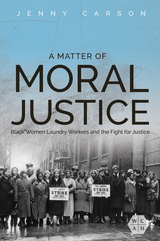 A Matter of Moral Justice: Black Women Laundry Workers and the Fight for Justice
Jenny Carson
University of Illinois Press, 2021 A long-overlooked group of workers and their battle for rights and dignity Like thousands of African American women, Charlotte Adelmond and Dollie Robinson worked in New York’s power laundry industry in the 1930s. Jenny Carson tells the story of how substandard working conditions, racial and gender discrimination, and poor pay drove them to help unionize the city’s laundry workers. Laundry work opened a door for African American women to enter industry, and their numbers allowed women like Adelmond and Robinson to join the vanguard of a successful unionization effort. But an affiliation with the powerful Congress of Industrial Organizations (CIO) transformed the union from a radical, community-based institution into a bureaucratic organization led by men. It also launched a difficult battle to secure economic and social justice for the mostly women and people of color in the plants. As Carson shows, this local struggle highlighted how race and gender shaped worker conditions, labor organizing, and union politics across the country in the twentieth century. Meticulous and engaging, A Matter of Moral Justice examines the role of African American and radical women activists and their collisions with labor organizing and union politics.
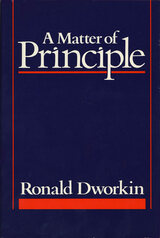 A Matter of Principle
Ronald Dworkin
Harvard University Press, 1986 This is a book about the interplay of urgent political issues and hotly debated questions of moral philosophy. The controversies it joins are old; but history has given them fresh shape. For example, whether judges should and do make law is now of more practical importance than ever before, as recent presidents have appointed enough justices to the Supreme Court to set its character for a generation.
With forceful style, Ronald Dworkin addresses questions about the Anglo-American legal system as protector of individual rights and as machinery for furthering the common good. He discusses whether judges should make political decisions in hard cases; the balancing of individual rights versus the good of the community; whether a person has the right to do what society views as wrong; and the meaning of equality in any framework of social justice. Dworkin strongly opposes the idea that judges should aim at maximizing social wealth. It is his conviction that the area of discretion for judges is severely limited, that in a mature legal system one can always find in existing law a “right answer” for hard cases.
Dworkin helps us thread our way through many timely issues such as the rights and privileges of the press under the First Amendment. He reviews the Bakke case, which tested affirmative action programs. These essays also examine civil disobedience, especially in nuclear protests, and bring new perspective to the debate over support of the arts.
Above all, this is a book about the interplay between two levels of our political consciousness: practical problems and philosophical theory, matters of urgency and matters of principle. The concluding essay on press freedom expands the discussion of conflict between principle and policy into a warning. Though some defenders of the press blend the two in order to expand freedom of speech, the confusion they create does disservice to their aim and jeopardizes the genuine and fragile right of free speech. We stand in greater danger of compromising that right than of losing the most obvious policy benefits of powerful investigative reporting and should therefore beware the danger to liberty of confusing the two. The caution is general. If we care so little for principle that we dress policy in its colors when this suits our purpose, we cheapen principle and diminish its authority.
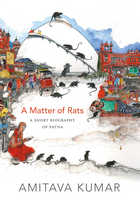 A Matter of Rats: A Short Biography of Patna
Amitava Kumar
Duke University Press, 2014 It is not only the past that lies in ruins in Patna, it is also the present. But that is not the only truth about the city that Amitava Kumar explores in this vivid, entertaining account of his hometown. We accompany him through many Patnas, the myriad cities locked within the city—the shabby reality of the present-day capital of Bihar; Pataliputra, the storied city of emperors; the dreamlike embodiment of the city in the minds and hearts of those who have escaped contemporary Patna's confines. Full of fascinating observations and impressions, A Matter of Rats reveals a challenging and enduring city that exerts a lasting pull on all those who drift into its orbit.
Kumar's ruminations on one of the world's oldest cities, the capital of India's poorest province, are also a meditation on how to write about place. His memory is partial. All he has going for him is his attentiveness. He carefully observes everything that surrounds him in Patna: rats and poets, artists and politicians, a girl's picture in a historian's study, and a sheet of paper on his mother's desk. The result is this unique book, as cutting as it is honest.
 The Matter of the Page: Essays in Search of Ancient and Medieval Authors
Shane Butler
University of Wisconsin Press, 2010 Ancient and medieval literary texts often call attention to their existence as physical objects. Shane Butler helps us to understand why. Arguing that writing has always been as much a material struggle as an intellectual one, The Matter of the Page offers timely lessons for the digital age about how creativity works and why literature moves us.
Butler begins with some considerations about the materiality of the literary text, both as a process (the draft) and a product (the book), and he traces the curious history of “the page” from scroll to manuscript codex to printed book and beyond. He then offers a series of unforgettable portraits of authors at work: Thucydides struggling to describe his own diseased body; Vergil ready to burn an epic poem he could not finish; Lucretius wrestling with words even as he fights the madness that will drive him to suicide; Cicero mesmerized by the thought of erasing his entire career; Seneca plumbing the depths of the soul in the wax of his tablets; and Dhuoda, who sees the book she writes as a door, a tunnel, a womb. Butler reveals how the work of writing transformed each of these authors into his or her own first reader, and he explains what this metamorphosis teaches us about how we too should read.
All Greek and Latin quotations are translated into English and technical matters are carefully explained for general readers, with scholarly details in the notes.
A Matter of Time
Alex Capus
Haus Publishing, 2009 A little known backwater of the history of the Great War is vividly rendered by a great story-teller - the central characters and events of this book are based on fact, but their surroundings and experiences are richly drawn from the author's imagination and detailed research.
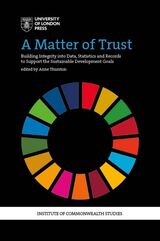 A Matter of Trust: Building Integrity into Data, Statistics and Records to Support the Sustainable Development Goals
Edited by Anne Thurston
University of London Press, 2020 The United Nations Sustainable Development Goals initiative has the potential to set the direction for a future world that works for everyone. Approved by 193 United Nations member countries in September 2016 to help guide global and national development policies through the year 2030, the seventeen goals build on the successes of the Millennium Development Goals, but also include new priority areas, such as climate change, economic inequality, innovation, sustainable consumption, peace, and justice. Assessed against commonly agreed targets and indicators, the goals should facilitate inter-governmental cooperation and the development of regional and even global development strategies. This book explores, through a series of case studies, the substantial challenges for assembling reliable data and statistics to address pressing development challenges, particularly in Africa. By highlighting the enormous potential value of creating and using high quality data, statistics, and records as an interconnected resource and describing how this can be achieved, the book will contribute to defining meaningful and realistic global and national development policies in the critical period to 2030.
The Matter of Violence in Baroque Painting
Bogdan Cornea
Amsterdam University Press, 2023 Baroque depictions of violence are often dismissed as ‘over the top’ and ‘excessive’. Their material richness and exciting visual complexity, together with the visceral engagement they demand from beholders, are usually explained in literature as reflecting the presumed violence of early modern society. This book explores the intersection between materiality, excess, and violence in seventeenth-century paintings through a close analysis of some of the most iconic works of the period. Baroque paintings expose or reference their materiality by insisting on various physical changes wrought through violence. This study approaches violence as the work of materiality, which has the potential to analogously stage pictorial surfaces as corporeal surfaces, where paint becomes flayed flesh, canvas threads ruptured skin, and red paint spilt blood.
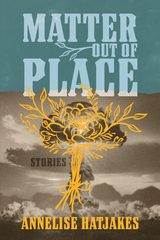 Matter Out of Place: Stories
AnnElise Hatjakes
University of Nevada Press, 2026 A grieving mother ghost-hunts in Virginia City. A college student’s field trip to the Moonlite Bunny Ranch brothel spurs a sexual awakening. A boy starts a wildfire on Peavine while trying to impress his crush. A schoolteacher is dismissed, and the aftermath unfolds in a schoolwide email chain. A woman tries on new identities at Burning Man. All must contend with their complicated histories and answer the question: is being from a place the same as being of it?
Experimental in its approach and unflinching in its execution, Matter Out of Place is an exploration of bright spots of humanity in dark underbellies, a feminist reckoning with “sin,” and a love letter to the strange mirage that is northern Nevada. It inhabits physical and digital spaces with equal wariness, and its characters—filled with grit—navigate the fraught divide between appearances and reality, approval and judgment, gambling everything despite knowing that the house always wins.
 Matterphorics: On the Laws of Theory
Daniela Gandorfer
Duke University Press, 2026 In Matterphorics, Daniela Gandorfer challenges modernist legal theory’s separation of concepts from matter, developing a mode of theory attuned to indeterminacy, relationality, and material entanglement. Gandorfer offers a method for generating legal concepts that respond to ontological complexity rather than reducing the world to fixed categories or representational entities. Through a range of recent case studies ranging from outer space exploration and Red Bull’s high-altitude freefalls to seabed mining, cryonics, and the copyrighting of DNA, she shows how law is unsettled when confronted with technological frontiers and planetary transformations. Instead of treating law as an abstract system, she proposes it as a creative and situated practice—one that must continually reimagine its concepts in response to shifting relations between matter, technology, and thought. In so doing, Gandorfer formulates legal theory as a creative and situated response to planetary and technological transformation.
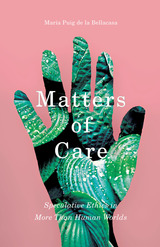 Matters of Care: Speculative Ethics in More than Human Worlds
María Puig de la Bellacasa
University of Minnesota Press, 2017 To care can feel good, or it can feel bad. It can do good, it can oppress. But what is care? A moral obligation? A burden? A joy? Is it only human? In Matters of Care, María Puig de la Bellacasa presents a powerful challenge to conventional notions of care, exploring its significance as an ethical and political obligation for thinking in the more than human worlds of technoscience and naturecultures. Matters of Care contests the view that care is something only humans do, and argues for extending to non-humans the consideration of agencies and communities that make the living web of care by considering how care circulates in the natural world. The first of the book’s two parts, “Knowledge Politics,” defines the motivations for expanding the ethico-political meanings of care, focusing on discussions in science and technology that engage with sociotechnical assemblages and objects as lively, politically charged “things.” The second part, “Speculative Ethics in Antiecological Times,” considers everyday ecologies of sustaining and perpetuating life for their potential to transform our entrenched relations to natural worlds as “resources.” From the ethics and politics of care to experiential research on care to feminist science and technology studies, Matters of Care is a singular contribution to an emerging interdisciplinary debate that expands agency beyond the human to ask how our understandings of care must shift if we broaden the world.
 Matters of Choice: Puerto Rican Women's Struggle for Reproductive Freedom
Lopez, Iris
Rutgers University Press, 2008 Sterilization remains one of the most popular forms of fertility control in the world, but it has received little acknowledgment for decreasing birthrates on account of its dubious use as a means of population control, especially in developing countries. In Matters of Choice, Iris Lopez presents a comprehensive analysis of the dichotomous views that have portrayed sterilization either as part of a coercive program of population control or as a means of voluntary, even liberating, fertility control by individual women. Drawing upon her twenty-five years of research on sterilized Puerto Rican women from five different families in Brooklyn, Lopez untangles the interplay between how women make fertility decisions and their social, economic, cultural, and historical constraints. Weaving together the voices of these women, she covers the history of sterilization and eugenics, societal pressures to have fewer children, a lack of adequate health care, patterns of gender inequality, and misinformation provided by doctors and family members. Lopez makes a stirring case for a model of reproductive freedom, taking readers beyond victim/agent debates to consider a broader definition of reproductive rights within a feminist anthropological context.
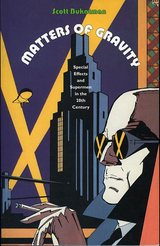 Matters of Gravity: Special Effects and Supermen in the 20th Century
Scott Bukatman
Duke University Press, 2003 The headlong rush, the rapid montage, the soaring superhero, the plunging roller coaster— Matters of Gravity focuses on the experience of technological spectacle in American popular culture over the past century. In these essays, leading media and cultural theorist Scott Bukatman reveals how popular culture tames the threats posed by technology and urban modernity by immersing people in delirious kinetic environments like those traversed by Plastic Man, Superman, and the careening astronauts of 2001: A Space Odyssey and The Right Stuff. He argues that as advanced technologies have proliferated, popular culture has turned the attendant fear of instability into the thrill of topsy-turvydom, often by presenting images and experiences of weightless escape from controlled space. Considering theme parks, cyberspace, cinematic special effects, superhero comics, and musical films, Matters of Gravity highlights phenomena that make technology spectacular, permit unfettered flights of fantasy, and free us momentarily from the weight of gravity and history, of past and present. Bukatman delves into the dynamic ways pop culture imagines that apotheosis of modernity: the urban metropolis. He points to two genres, musical films and superhero comics, that turn the city into a unique site of transformative power. Leaping in single bounds from lively descriptions to sharp theoretical insights, Matters of Gravity is a deft, exhilarating celebration of the liberatory effects of popular culture.
 Matters of Significance: Replication, Translation and Academic Freedom in developmental science
Marinus H. van IJzendoorn and Marian J. Bakermans-Kranenburg
University College London, 2024 A thorough examination of field-shaping research on attachment that serves as a valuable resource for understanding child developmental science and ethically applying its insights in practice.
Application of scientific findings to effective practice and informed policymaking is an aspiration for much research in the biomedical, behavioral, and developmental sciences. But too often translations of science to practice are conceptually narrow and developed quickly as salves to an urgent problem. For developmental science, widely implemented parenting interventions are prime examples of technical translations from knowledge about the causes of children’s mental distress. Aiming to support family relationships and facilitate adaptive child development, these programs are rushed through when the scientific findings on which they are based remain contested and without enough evidence of success from randomized controlled trials.
In Matters of Significance, the authors draw on forty years of experience with theoretical, empirical, meta-analytic, and translational work in child development research to highlight the complex relations between replication, translation, and academic freedom. They argue that challenging fake facts promulgated by under-replicated and underpowered studies is also a method of translation. Such a challenge can, in the highlighted field of attachment and emotion regulation research, bust popular myths about the decisive role of genes, hormones, or the brain on parenting and child development, with a balancing impact on practice and policy making. The authors argue that academic freedom from interference by pressure groups, stakeholders, funders, or university administrators in the core stages of research is a necessary but besieged condition for adversarial research and myth-busting.
Matters of the Sea / Cosas del mar: A Poem Commemorating a New Era in US-Cuba Relations
Richard Blanco
University of Pittsburgh Press, 2015 Matters of the Sea / Cosas del mar is a commemorative bilingual chapbook that beautifully reproduces Richard Blanco’s stirring poem presented during the historic reopening ceremony of the United States Embassy in Havana, Cuba, on August 14, 2015.
“Matters of the Sea is one of the most emotionally complex and personal poems I’ve ever written, invested with all my love for the people of two countries that are part of my very being. As with the presidential inauguration in 2013, I am once again humbled and honored to participate as a poet in another historic moment of such significance. I’m elated by the power of poetry to mark such important, communal moments and to be a catalyst for change and understanding by reaching deep into our emotional selves and connecting us to our shared humanity.”—Richard Blanco
Matthew Arnold and the Classical Tradition
Warren D. Anderson
University of Michigan Press, 1988 To be born into the middle or upper classes of Matthew Arnold's England was in a sense to be born into the classical tradition. The precise contour and uses of the tradition, in Arnold's thought and writing, are the subject of this unique study by Warren D. Anderson. In Matthew Arnold and the Classical Tradition, Anderson shows how the young poet first experimented with his classical heritage, how he moved toward deep involvement and then withdrew to a more objective position. The author examines Arnold's school and university background, his poetry and later prose, his relationship to Stoicism and Epicureanism. The resulting study is absolutely central to an appreciation of Arnold and to an understanding of the classical foundations of Western literature. It shows clearly and accurately the ways in which the nineteenth century interpreted the fifth century B.C.
Matthew Arnold the Ethnologist
Frederic E. Faverty
Northwestern University Press, 1951 Matthew Arnold the Ethnologist, originally published in 1951, makes the original argument that the renowned English critic Matthew Arnold contributed to the climate of “racialism” current during his lifetime. Frederic E. Faverty shows that in his essays on national character, Arnold used anthropological concepts of race and language, albeit inconsistently. Faverty’s critique of Arnold draws particular attention to the lack of a specifically cultural (rather than racial) analysis of the type pioneered by his contemporary Edward Burnett Tylor.
Matthew within Judaism: Israel and the Nations in the First Gospel
Anders Runesson
SBL Press, 2020 In this collection of essays, leading New Testament scholars reassess the reciprocal relationship between Matthew and Second Temple Judaism. Some contributions focus on the relationship of the Matthean Jesus to torah, temple, and synagogue, while others explore theological issues of Jewish and gentile ethnicity and universalism within and behind the text.
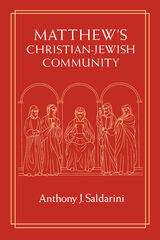 Matthew's Christian-Jewish Community
Anthony J. Saldarini
University of Chicago Press, 1994 The most Jewish of gospels in its contents and yet the most anti-Jewish in its polemics, the Gospel of Matthew has been said to mark the emergence of Christianity from Judaism. Anthony J. Saldarini overturns this interpretation by showing us how Matthew, far from proclaiming the replacement of Israel by the Christian church, wrote from within Jewish tradition to a distinctly Jewish audience.
Recent research reveals that among both Jews and Christians of the first century many groups believed in Jesus while remaining close to Judaism. Saldarini argues that the author of the Gospel of Matthew belonged to such a group, supporting his claim with an informed reading of Matthew's text and historical context. Matthew emerges as a Jewish teacher competing for the commitment of his people after the catastrophic loss of the Temple in 70 C.E., his polemics aimed not at all Jews but at those who oppose him. Saldarini shows that Matthew's teaching about Jesus fits into first-century Jewish thought, with its tradition of God-sent leaders and heavenly mediators.
In Saldarini's account, Matthew's Christian-Jewish community is a Jewish group, albeit one that deviated from the larger Jewish community. Contributing to both New Testament and Judaic studies, this book advances our understanding of how religious groups are formed.
Matthew’s Parable of the Royal Wedding Feast: A Sociorhetorical Interpretation
Ruth Christa Mathieson
SBL Press, 2023 Ruth Christa Mathieson’s unique reading of Matthew’s parable of the royal wedding feast (Matt 22:1–14), which concludes with the king’s demand that one of the guests be bound and cast out into the outer darkness, focuses on the means of the underdressed guest’s expulsion. Using sociorhetorical interpretation, Mathieson draws the parable into conversation with early Jewish narratives of the angel Raphael binding hands and feet (1 Enoch; Tobit) and the protocol for expelling individuals from the community in Matt 18. She asserts that readers are invited to consider if the person who is bound and cast out is a danger to the little ones of the community of faith unless removed and restrained.
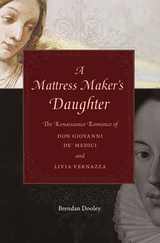 A Mattress Maker’s Daughter: The Renaissance Romance of Don Giovanni de’ Medici and Livia Vernazza
Brendan Dooley
Harvard University Press, 2014 A Mattress Maker’s Daughter richly illuminates the narrative of two people whose mutual affection shaped their own lives and in some ways their times. According to the Renaissance legend, told and retold across the centuries, a woman of questionable reputation bamboozles a middle-aged warrior-prince into marrying her, and the family takes revenge. He is don Giovanni de’ Medici, son of the Florentine grand duke; she is Livia Vernazza, daughter of a Genoese artisan. They live in luxury for a while, far from Florence, and have a child. Then, Giovanni dies, the family pounces upon the inheritance, and Livia is forced to return from riches to rags. Documents, including long-lost love letters, reveal another story behind the legend, suppressed by the family and forgotten. Brendan Dooley investigates this largely untold story, among the various settings where episodes occurred, between Florence, Genoa, Venice.
In the course of explaining their improbable liaison and its consequences, A Mattress Maker’s Daughter explores early modern emotions, material culture, heredity, absolutism, and religious tensions at the crux of one of the great transformations in European culture, society, and statecraft. Giovanni and Livia exemplify changing concepts of love and romance, new standards of public and private conduct, and emerging attitudes toward property and legitimacy just as the age of Renaissance humanism gave way to the culture of Counter Reformation and Early Modern Europe.
 Mature Audiences: Television in the Lives of Elders
Karen E. Riggs
Rutgers University Press, 1998 A medium in which Dawson's Creek is displacing the "aging" Beverly Hills 90210 and Melrose Place has little room for older Americans. Mass communications professor Riggs studies the other side of the television screen: "creative ways in which older Americans are using television today." Her book gathers several ethnographic studies: on older women's reaction to Murder, She Wrote; on the vital place of C-SPAN, PBS, and other nontraditional fiction and nonfiction TV among the upper-class residents of a midwestern retirement community; on involvement in public-access television by older Milwaukee African Americans; and on ways minority and immigrant elders interacted with TV. Americans, Riggs notes, "have linked television viewing among the aged with deadly passivity, hinting that elders who spend hours each day with the tube have ceded over their lives." In fact, she argues, elders from different classes, genders, races, and social circumstances choose the shows they watch deliberately and thoughtfully and as a key element in their interaction with the world around them.
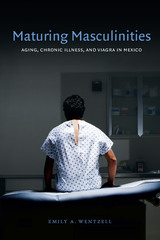 Maturing Masculinities: Aging, Chronic Illness, and Viagra in Mexico
Emily A. Wentzell
Duke University Press, 2013 Maturing Masculinities is a nuanced exploration of how older men in urban Mexico incorporate aging, chronic illness, changing social relationships, and decreasing erectile function into their conceptions of themselves as men. It is based on interviews that Emily A. Wentzell conducted with more than 250 male patients in the urology clinic of a government-run hospital in Cuernavaca. Drawing on science studies, medical anthropology, and gender theory, Wentzell suggests the idea of "composite masculinities" as a paradigm for understanding how men incorporate physical and social change into gendered selfhoods. Erectile dysfunction treatments like Viagra are popular in Mexico, where stereotypes of men as sex-obsessed "machos" persist. However, most of the men Wentzell interviewed saw erectile difficulty as a chance to demonstrate difference from this stereotype. Rather than using drugs to continue youthful sex lives, many collaborated with wives and physicians to frame erectile difficulty as a prompt to embody age-appropriate, mature masculinities.
 The Maturing of Multinational Enterprise: American Business Abroad from 1914 to 1970
Mira Wilkins
Harvard University Press, 1974 With this magisterial study of American multinational enterprises, Mira Wilkins becomes the preeminent scholar in the all-important field of business history. A comprehensive work of prodigious research and erudition, her book gives us the history of American corporations abroad from 1914 to 1970. American multinational enterprise is not new. Over time, giant U.S. multinational corporations have crossed political boundaries, so much so that their activities now command worldwide attention.
Harvard Studies in Business History series Editor Alfred D. Chandler, Jr. comments in his introduction: “All scholars analyzing the experience of the multinational enterprise will have to rely heavily on the record Ms. Wilkins presents here. Her history must long remain a basic source for historians, economists, and political scientists who wish to explain the rise and continuing domination of large-scale business enterprises in modern market economies, to understand the growth and changes in international and national economies since World War I, and to study the interrelationships between national economic policies and priorities and a changing international economic order.”
This work is wholly self-contained and can be read without reference to its predecessor, The Emergence of Multinational Enterprise: American Business Abroad from the Colonial Era to 1914. Yet the volumes, together, form the first overall history of American business abroad from our earliest times to the late twentieth century.
Maturing with Moxie: A Woman’s Guide to Life after 60
Jan Cannon
University Press of New England, 2018 Whether widowed, divorced, married, or single, more and more women of retirement age are taking control of their lives. Maturing with Moxie takes a close look at personal and professional circumstances affecting women over sixty by surveying the best and latest thinking on issues from housing to health care, finances to family, and combines them all in one practical, go-to volume. The veteran consultant Jan Cannon takes a comprehensive approach to a range of decisions facing women as they age, and offers sensible, helpful advice on everyday questions about employment, Medicare, changing family dynamics, and dating. Drawing on her extensive client case files, Cannon poses provocative questions, designs useful exercises, and offers clear, upbeat examples of women moving forward with purpose. Maturing with Moxie gives women a wealth of resources for finding the answers they need.
Mau Mau and Nationhood: Arms, Authority, and Narration
E. S. Atieno Odhiambo
Ohio University Press, 2003 Fifty years after the declaration of the state of emergency, Mau Mau still excites argument and controversy, not least in Kenya itself. Mau Mau and Nationhood is a collection of essays providing the most recent thinking on the uprising and its aftermath.
The work of well-established scholars as well as of young researchers with fresh perspectives, Mau Mau and Nationhood achieves a multilayered analysis of a subject of enduring interest. According to Terence Ranger, Emeritus Rhodes Professor, Oxford, “In some ways the historiography of Mau Mau is a supreme example not only of ambiguity and complexity, but also of redemption of a topic once thought incapable of rational analysis.”
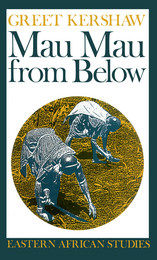 Mau Mau From Below: Eastern African Studies
Greet Kershaw
Ohio University Press, 1996 John Lonsdale says in his introduction: “This is the oral evidence of the Kikuyu villagers with whom Greet Kershaw lived as an aid worker during the Mau Mau ‘Emergency’ in the 1950s, and which is now totally irrecoverable in any form save in her own field notes. Professor Kershaw has uncovered long local histories of social tension which could have been revealed by no other means than patient enquiry, of both her neighbour’s memory and government archives… Nobody, whether Kikuyu participant, Kenyan or European scholar, has provided such startlingly authoritative ethnographic insights into the values, fears and expectations of Kikuyu society and thus of the motivation of Kikuyu action… Her data suggests, as other scholars have also accepted, that there never was a single such movement and that none of its members, even those who supposed themselves to be its leaders, ever saw it whole, not because they did not have a political aim, but because that agenda was contested within different political circles over which they had no control and of which they may scarcely have had any knowledge. And why is this finding important? It is because others, including almost all the movement’s enemies, did see Mau Mau whole in order to try to comprehend it, a first step towards defeating it.”
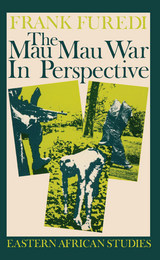 The Mau Mau War in Perspective: Eastern African Studies
Frank Furedi
Ohio University Press, 1989 The book breaks new ground in following the story of the participants of the rural movement during the decade after the defeat of the Mau Mau. New archival sources and interviews provide exciting material on the mechanics of the sociology of decolonization and on the containment of rural radicalism in Kenya. For the first time an account of decolonization in Kenya based on primary sources is offered to the reader. The Mau Mau was militarily crushed in the mid-fifties, but the struggle for land rights was only contained in the post independence era of Kenya. Kikuyu squatters on European estates who formed the backbone of this movement are the main subject of this book. Furedi’s account considers how the radicalization of rural protest in the so-called White Highlands led to the Mau Mau explosion and how it was sustained during the subsequent fifteen years. The book establishes a focus for discussion of these critical events through exploring the relationship between rural resistance and decolonization. The author argues that the main issue facing post-colonial policies in Kenya was to resolve the problems raised by the Mau Mau revolt. Written from an interdisciplinary perspective, with a special emphasis on historical and political sociology, this book is aimed at students of African politics and political sociologists interested in rural revolution and revolt.
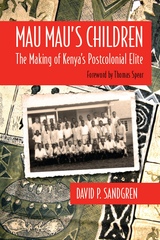 Mau Mau’s Children: The Making of Kenya’s Postcolonial Elite
David P. Sandgren; Foreword by Thomas Spear
University of Wisconsin Press, 2012 In 1963 David P. Sandgren went to Kenya to teach in a small, rural school for boys, where he remained for the next four years. These were heady times for Kenyans, as the nation gained its independence, approved a new constitution, and held its first elections. In the school where Sandgren taught, the sons of Gikuyu farmers rose to the challenges of this post colonial era and, in time, entered Kenyan society as adults, joining Kenya’s first generation of post colonial elites.
In Mau Mau’s Children, Sandgren has reconnects with these former students. Drawing on more than one hundred interviews, he provides readers with a collective biography of the lives of Kenya’s first postcolonial elite, stretching from their 1940s childhood to the peak of their careers in the 1990s. Through these interviews, Mau Mau’s Children shows the trauma of growing up during the Mau Mau Rebellion, the nature of nationalism in Kenya, the new generational conflicts arising, and the significance of education and Gikuyu ethnicity on his students' path to success.
 The Maudlin Impression: English Literary Images of Mary Magdalene, 1550-1700
Patricia Badir
University of Notre Dame Press, 2009
Patricia Badir's The Maudlin Impressioninvestigates the figure of Mary Magdalene in post-medieval English religious writings and visual representations. Badir argues that the medieval Magdalene story was not discarded as part of Reformation iconoclasm, but was enthusiastically embraced by English writers and artists and retold in a wide array of genres. This rich study bridges the historical division between medieval and early modern culture by showing the ways in which Protestant writers, as well as Catholics, used the medieval stories, art, and symbolism related to the biblical Magdalene as resources for thinking about the role of the affective and erotic in Christian devotion. Their literary and artistic glosses protected a range of religious devotional practices and lent embodied, tangible form to the God of the Reformation. They employed the Magdalene figure to articulate religious experience by means of a poetics that could avoid controversial questions of religious art while exploring the potency and appeal of the beautiful.
The Maudlin Impression is a literary history of imitation and invention. It participates in the "religious turn" in early modern studies by demonstrating the resilience of a single topos across time and across changing Christian beliefs.
"In this historically rich and theoretically informed study, Patricia Badir argues that the medieval figure of Mary Magdalene serves as a 'site of memory' for early modern writers, enabling them both to reflect on what has been lost in the aftermath of the Reformation and to fashion their own Protestant and Counter-Reformation models of piety, repentance, mourning, and holiness. Drawing from poems, plays, sermons, homilies, biographies, and paintings, Badir convincingly demonstrates the remarkable resiliency and flexibility of the Magdalene trope in the sixteenth and seventeenth centuries. Her fascinating narrative traces the evolution of the Magdalene from the Reformation to the Restoration and raises provocative questions about the mnemonic function of religious art, the power of beautiful images in an iconoclastic culture, and the place of affect, longing, and embodiment in a Protestant poetics." --Huston Diehl, University of Iowa
"In the aftermath of the Reformation, the English wrote about Mary Magdalene. Sometimes she belongs to a specifically Protestant poetics: the gaudy Catholic whore turned Reformed penitent. Yet most post-Reformation Magdalenes resist Catholic-or-Protestant pigeonholing; instead, all unexpectedly, Badir's quick-eyed scholarship discloses continuities, convergences, recuperations. . . . [Her] book luminously teaches the all-important lesson that the Reformation fought in polemics was not necessarily the Reformation found in poetry." --Debora Shuger, University of California, Los Angeles
"A marvelously textured account from an early modern perspective of an alluring sacred figure about whom there has recently been a Renaissance of cultural interest--popular as well as scholarly. Badir subtly explicates how the theological and artistic issues concerning the devotional depiction of the Magdalene go to the core of Christian representational practice, provoking, all along the way, questions about gender, desire, and sacred eroticism." --Richard Rambuss, Emory University
Maurice, or The Fisher's Cot: A Tale
Mary Wollstonecraft Shelley
University of Chicago Press, 2000 In November 1997, a slight book sewn together with string was discovered in a palazzo in Italy. This was Maurice, the only children's story ever penned by Mary Shelley. Written two years after Frankenstein, Maurice is often read as a gloss of Shelley's personal family tragedies, bearing the same melancholy that distinguishes all of her works. As Claire Tomalin shows in her compelling introduction, it contributes greatly to the literary and biographical scholarship on this fascinating woman who was a significant writer in her own right as well as the wife of one of the world's greatest romantic poets.
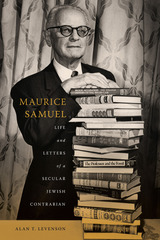 Maurice Samuel: Life and Letters of a Secular Jewish Contrarian
Alan T. Levenson
University of Alabama Press, 2022 An intellectual biography that reassesses one of the premier Jewish humanists of the mid-twentieth century
In Maurice Samuel: Life and Letters of a Secular Jewish Contrarian, Alan T. Levenson captures the life, works, and milieu of the Romanian-born, English-educated, American belletrist Maurice Samuel. A diaspora intellectual—or a rooted cosmopolitan, as Levenson describes him—Samuel made an indelible mark on many features of contemporary Jewish thought and culture. A generalist in an age of experts, an independent scholar in an age of rabbis and professors, Samuel was one of the most productive and visible members of the group dubbed the “other” New York Jewish intellectuals.
His fame as a public intellectual and popular speaker were well warranted: no mere popularizer, Samuel contributed significantly to four seemingly unrelated but critical areas of modern Jewish thought. Samuel is characterized by some as principally a Zionist, by others as an accomplished translator and many Americans’ first entrée into the world of Yiddish literature, by still others as a polemicist and campaigner against anti-Semitism, and finally as a media-savvy Biblical critic, essayist, and radio personality. But he was all of these things, since Samuel succeeded in an era when it was possible to be a public intellectual without being an expert.
Drawing on Samuel’s vast literary opus, as well as previously unexplored archival material from three continents, this study writes Samuel back into the history of mid-twentieth-century American letters. Levenson argues that Samuel’s varied and substantive contributions demand reconsideration of our assumptions about the means and ends of cultural transmission, and merit him a place as one of twentieth-century American Jewry’s most significant cultural and intellectual voices.
Maury Maverick: A Political Biography
By Richard B. Henderson
University of Texas Press, 1970 Maury Maverick was possibly the first liberal United States Congressman from Texas to achieve national and even international stature. A dedicated Democrat, he was ready to attack Franklin D. Roosevelt whenever he felt that Roosevelt was flagging in his enthusiasm for reform. He was honest to the point of rudeness, and he belonged to the "damn the torpedoes" class that pulled ahead regardless of political consequences. He was at home with the literate—he was a prodigious writer and speaker—but always ready to puncture their pretensions. And he could cuss with sailors, pecan shellers, and any breed of saloon keeper. Put all that together with a short, stocky, bulldog frame, a fierce face and a voice to match, and you have one of the nation's more colorful political figures.
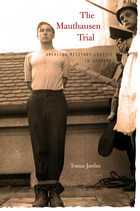 The Mauthausen Trial: American Military Justice in Germany
Tomaz Jardim
Harvard University Press, 2012 Shortly after 9:00 a.m. on May 27, 1947, the first of forty-nine men condemned to death for war crimes at Mauthausen concentration camp mounted the gallows at Landsberg prison near Munich. The mass execution that followed resulted from an American military trial conducted at Dachau in the spring of 1946—a trial that lasted only thirty-six days and yet produced more death sentences than any other in American history.
The Mauthausen trial was part of a massive series of proceedings designed to judge and punish Nazi war criminals in the most expedient manner the law would allow. There was no doubt that the crimes had been monstrous. Yet despite meting out punishment to a group of incontestably guilty men, the Mauthausen trial reveals a troubling and seldom-recognized face of American postwar justice—one characterized by rapid proceedings, lax rules of evidence, and questionable interrogations.
Although the better-known Nuremberg trials are often regarded as epitomizing American judicial ideals, these trials were in fact the exception to the rule. Instead, as Tomaz Jardim convincingly demonstrates, the rough justice of the Mauthausen trial remains indicative of the most common—and yet least understood—American approach to war crimes prosecution. The Mauthausen Trial forces reflection on the implications of compromising legal standards in order to guarantee that guilty people do not walk free.
The Maverick and the Machine: Governor Dan Walker Tells His Story
Dan Walker
Southern Illinois University Press, 2007 A reformer who was always colorful, provocative, and controversial, Dan Walker became a political maverick, taking on Mayor Richard J. Daley’s vaunted Chicago machine and the powerful incumbent Richard Ogilvie to become the governor of Illinois. The Maverick and the Machine tells the dramatic story of Walker’s rise from dirt-poor beginnings to the pinnacle of power in Illinois and his conviction on charges of bank fraud that landed him in federal prison. This frank volume also probes the inner sanctum of the governorship and reviews the investigations of Governor Blagojevich’s administration and the criminal trial of former governor George Ryan.
Best Memoir of 2008, San Diego Book Awards
Illinois State Historical Society Certificate of Excellence, 2008
Maverick Heart: The Further Adventures Of Zane Grey
Stephen J. May
Ohio University Press, 2000 In 1927, at the peak of his career, Zane Grey bought a three-masted schooner, which he sailed to the Galapagos Islands, later journeying to Tahiti, New Zealand, Australia, and Fiji. As colorful as his characters were, so too was their creator. A consummate explorer, Zane Grey toured the world, was an acclaimed expert on salt- and freshwater fishing, and incorporated the sights and sounds he witnessed into his writings. As a companion to his biographical work of Grey’s literary life, Zane Grey: Romancing the West, author Stephen J. May now gives as a remarkable look into another aspect of Grey’s existence, the side little known but central to the measure of the man. Maverick Heart makes use of Grey’s own memoirs and letters to give an enlightening portrait of this larger-than-life American character and a telling insight into one of the key shapers of the cultural heritage of our country.
The Maverick Spirit: Building The New Nevada
Richard O. Davies
University of Nevada Press, 1998 A collection of biographical essays on fourteen contemporary Nevadans. The subjects of the essays are Maude Frazier; Moe Dalitz; James B. McMillan; William F. Harrah; Hank Greenspun; Alan Bible; Robert Laxalt; Grant Sawyer; Molly Flagg Knudtsen; Paul Laxalt; Steve Wynn; William Raggio; Sue Wagner; and Jerry Tarkanian.
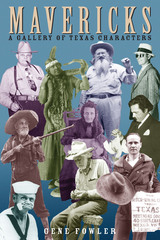 Mavericks: A Gallery of Texas Characters
By Gene Fowler
University of Texas Press, 2008 Texas has been home to so many colorful characters, out-of-staters might wonder if any normal people live here. And it's true that the "Texian" desire to act out sometimes overcomes even the most sober citizens—which makes it a real challenge for the genuine eccentrics to distinguish themselves from the rest of us. Fortunately, though, many maverick Texans have risen to the test, and in this book, Gene Fowler introduces us to a gallery of Texas eccentrics from the worlds of oil, ranching, real estate, politics, rodeo, metaphysics, showbiz, art, and folklore. Mavericks rounds up dozens of Fowler's favorite Texas characters, folks like the Trinity River prophet Commodore Basil Muse Hatfield; the colorful poet-politician Cyclone Davis Jr.; Big Bend tourist attraction Bobcat Carter; and the dynamic chief executive of the East Texas Oil Field Governor Willie. Fowler persuasively argues that many of these characters should be viewed as folk performance artists who created "happenings" long before the modern art world took up that practice in the 1960s. Other featured mavericks run the demographic gamut from inspirational connoisseurs of the region's native quirkiness to creative con artists and carnival oddities. But, artist or poser, all of the eccentrics in Mavericks completely embody the style and spirit that makes Texas so interesting, entertaining, and culturally unique.
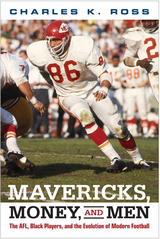 Mavericks, Money, and Men: The AFL, Black Players, and the Evolution of Modern Football
Charles Ross
Temple University Press, 2016 The American Football League, established in 1960, was innovative both in its commitment to finding talented, overlooked players—particularly those who played for historically black colleges and universities—and in the decision by team owners to share television revenues. In Mavericks, Money and Men, football historian Charles Ross chronicles the AFL’s key events, including Buck Buchanan becoming the first overall draft pick in 1963, and the 1965 boycott led by black players who refused to play in the AFL-All Star game after experiencing blatant racism. He also recounts how the success of the AFL forced a merger with the NFL in 1969, which arguably facilitated the evolution of modern professional football. Ross shows how the league, originally created as a challenge to the dominance of the NFL, pressured for and ultimately accelerated the racial integration of pro football and also allowed the sport to adapt to how African Americans were themselves changing the game.
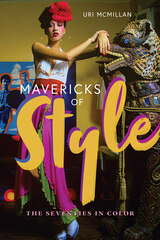 Mavericks of Style: The Seventies in Color
Uri McMillan
Duke University Press, 2025 In Mavericks of Style, Uri McMillan tells the story of New York City’s downtown art and fashion scene of the 1970s through the lives and careers of experimental Black and Brown artists. McMillan focuses on model and musician Grace Jones, fashion illustrator Antonio Lopez, fashion designer Stephen Burrows, and their orbit of friends, showing how they restlessly moved across genres and disciplines, transgressing boundaries between the commercial and the avant-garde. Bypassing the exclusive art world and cultivating uniquely personal styles, these artists thrived on friendship and collaboration in their experimental use of bold color, gold lamé, and Instamatic photography. McMillan transports readers to the spaces Jones, Lopez, and Burrows frequented and worked in, from hair salons, nondescript artist studios, and buzzy boutiques to funky discos and high fashion runways. By foregrounding their impact on the decade’s aesthetics, McMillan complicates and expands the understanding of these artists, offering a new vision of New York’s art world in sultry, bombastic color.
Max Brand: Western Giant: The Life and Times of Frederick Schiller Faust
William F. Nolan
University of Wisconsin Press, 1985 Called the King of the Pulps, Frederick Schiller Faust, aka Max Brand, wrote nearly 400 Westerns from The Untamed to Destry Rides Again—a total of more than 220 books in this genre. Yet Max Brand also created Dr. Kildare (of books, films, and television) and wrote under twenty-one pseudonyms, in another dozen genres. This book removes the mask, with deeply personal memoirs from family, friends and fellow writers, taking us through his orphaned boyhood on the brutal ranches of California, his frustrating decades in Italy, as both a classical poet and a fast-action pulpist, to his heroic death as a war correspondent on the World War II battlefields. Faust’s life story is augmented by a complete bibliography of his work—over a thousand books, stories, and films—plus the first listing of works about Faust.
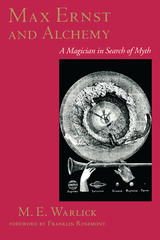 Max Ernst and Alchemy: A Magician in Search of Myth
By M. E. Warlick
University of Texas Press, 2001 Surrealist artist Max Ernst defined collage as the "alchemy of the visual image." Students of his work have often dismissed this comment as simply a metaphor for the transformative power of using found images in a new context. Taking a wholly different perspective on Ernst and alchemy, however, M. E. Warlick persuasively demonstrates that the artist had a profound and abiding interest in alchemical philosophy and often used alchemical symbolism in works created throughout his career. A revival of interest in alchemy swept the artistic, psychoanalytic, historical, and scientific circles of the late nineteenth and early twentieth centuries, and Warlick sets Ernst's work squarely within this movement. Looking at both his art (many of the works she discusses are reproduced in the book) and his writings, she reveals how thoroughly alchemical philosophy and symbolism pervade his early Dadaist experiments, his foundational work in surrealism, and his many collages and paintings of women and landscapes, whose images exemplify the alchemical fusing of opposites. This pioneering research adds an essential key to understanding the multilayered complexity of Ernst's works, as it affirms his standing as one of Germany's most significant artists of the twentieth century.
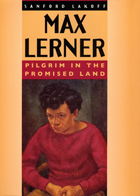 Max Lerner: Pilgrim in the Promised Land
Sanford Lakoff
University of Chicago Press, 1998 Max Lerner was a gifted writer and educator whose passion for life made him anything but an ivory tower recluse. In public a prominent commentator and college professor, in his private life he was a romantic adventurer, pursuing erotic relationships with unflagging zeal. He had two marriages (and six children) and became a close friend and frequent guest of Hugh Hefner at the Playboy Mansion West. One of his liaisons was with Elizabeth Taylor—who fondly referred to him as "my little professor." Max Lerner recounts the life and times of this fascinating figure of "the American century."
Politically, Lerner went through a series of metamorphoses. During the 1930s, he was an anti-fascist "popular front progressive" writing for the Nation and the New Republic. From the 1940s through the 1970s, he became the country's leading liberal columnist—first with the lively but short-lived PM, then for the New York Post. In the 1980s, however, he was repelled by the New Left and the counterculture and joined the ranks of the neoconservatives, scandalizing some readers but insisting he owed it to them to tell the truth as he saw it.
This riveting biography begins with Lerner's own gripping account of the hardships his family endured in emigrating from Russia and his own boyhood triumphs and frustrations. Sanford Lakoff traces Lerner's American pilgrimage from his education at Yale, where he felt the bitter sting of anti-Semitism, through his years as a radical inspired by Thorstein Veblen, into mellower maturity as a widely read columnist, an inspiring teacher, the author of America as a Civilization, a much-loved father, and—to the end—an unapologetic romantic, who liked to say that he never learned anything worth knowing except from women.
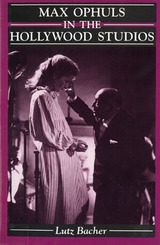 Max Ophuls in the Hollywood Studios
Bacher, Lutz
Rutgers University Press, 1996 Max Ophuls, who is considered one of the greatest film directors of all time, has long been seen as an “auteur”––the artist in complete control of his work. Lutz Bacher’s examination of his American career gives us a unique perspective on the workings of the Hollywood system and the struggle of a visionary to function within it. He thus establishes clear connections between the production contexts of Ophuls' American films and their idiosyncratic style.
Drawing on documents in many archives and on interviews with more than sixty of Ophuls' contemporaries, Bacher traces the European director's struggle to find a niche in the U.S. film industry. He describes how Ophuls ran the gamut from ghost writing to substitute directing, to a debilitating association with Preston Sturges and Howard Hughes, to making four films––Letter from an Unknown Woman and Caught among them––in thirty months, and then returning to Europe with a runaway production that was to have starred Greta Garbo. Throughout, Bacher demonstrates that Ophuls' bending of conventional Hollywood methods to his own will through compromise and subversion allowed him to achieve a style that was both uniquely American and a point of departure for his later work. A rare synthesis of production history, stylistic analysis, and biography, this book is essential reading for serious film scholars and fans of the director’s work.
 Max Reinhardt: From Bourgeois Theater to Metropolitan Culture
Peter W. Marx, translated from the German by Robert E. Goodwin
Northwestern University Press, 2024 Max Reinhardt was one of the formative directors of modern theater. Starting as an actor, it soon became clear that he wanted more. His vision of a theater "that returns joy to the people" was vast and expansive: It included intimate theatrical arrangement as well as mass production in the circus arena. Reinhardt's aesthetics were not restricted to a single program but indulged in a playful eclecticism. Thus, his career as a director that lasted for almost 40 years comprises a broad variety of artists of various genres as well as many different styles.
At the same time, Reinhardt soon longed for an international range: guest performances throughout Europe and to the US soon made him into a global star – and even a brand. He represents a metropolitan culture that roots in the late nineteenth century but comes to an end when Fasicsm in Europe ended any hopes for an international culture. As a Jew, Reinhardt himself had to flee the Nazis but when he eventually arrived in the US, he could not follow up with his earlier successes. Marx provides a broad panorama of Reinhardt's work, portraying not only his work method and some of his best known productions, but also the cultural conditions of his visionary enterprise.
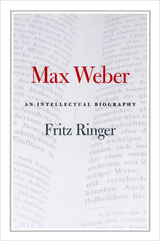 Max Weber: An Intellectual Biography
Fritz Ringer
University of Chicago Press, 2004 Max Weber was one of the most influential and creative intellectual forces of the twentieth century. In his methodology of the social sciences, he both exposed the flaws and solidified the foundations of the German historical tradition. Throughout his life, he saw bureaucracy as a serious obstacle to cultural vitality but as an inescapable part of organizational rationality. And in his most famous essay, on the Protestant ethic, he uncovered the psychological underpinnings of capitalism and modern occupational life.
This searching work offers the first comprehensive introduction to Weber's thought for students and newcomers. Fritz Ringer locates Weber in his historical context, relating his ideas to the controversies and politics of his day. Ringer also considers the importance of Weber to contemporary life, discussing his insights into the limits of scholarly research and the future of Western capitalist societies. Weber, Ringer reminds us, believed in democracy, liberalism, and fundamental human rights; his ethic of responsibility remains as vital to our historical moment as it was to his own.
A concise and incisive look at the man and personality behind the thought, Max Weber is a masterful outing in intellectual biography and social theory.
Max Weber: An Introduction to His Life and Work
Dirk Käsler
University of Chicago Press, 1988 Max Weber: An Introduction to His Life and Work has established itself as the standard short introduction in German to the work of Max Weber, and appears here for the first time in English translation. Sociologist Dirk Käsler has a profound sense of Weber's writings, yet manages to make Weber's ideas accessible to the beginner.
Käsler offers a comprehensive account of Weber's views, giving attention both to the context in which Weber produced his most significant contributions to social science, and to the changes involved in his work over the course of his career. This volume also serves as an introduction to the controversies that Weber's writings have stimulated, from the time of their first appearance to the present day.
This book will be of vital interest to anyone concerned with Max Weber and will undoubtedly become the leading student text on Weber in the English-speaking world.
Max Weber and German Politics, 1890-1920
Wolfgang J. Mommsen
University of Chicago Press, 1990 A major work of German historiography, this comprehensive account of Weber's political views and activities reveals that, paradoxically, Weber was at once an ardent liberal and a determined German nationalist and imperialist. Wolfgang J. Mommsen shows the important links between these seemingly conflicting positions and provides a critique of Weber's sociology of power and his concept of democratic rule.
First published in German in 1959, Max Weber and German Politics appeared in a revised edition in 1974 and became available in an English translation only in 1984. In writing this work, Mommsen drew extensively on Weber's published and unpublished essays, newspaper articles, memoranda, and correspondence.
 Max Weber on Law in Economy and Society
Max Weber
Harvard University Press Ever since it was made known to English-speaking readers by R. H. Tawney and Tolcott Parsons, the thought of Max Weber has attracted increasing attention among students of sociology, history, economics, jurisprudence, political science, and political philosophy. His far-flung ideas were systematically brought together in his last book, Economy and Society, the major part of which was not published until after his death in 1921. Of this most comprehensive and significant of all of Weber’s writings, only the Introductory Part has so far been available in English.
The present book contains an English translation of those parts of Economy and Society in which Weber investigates the relationship between the social phenomenon “law” and the other spheres of social life, especially the economic and the political. The translation, by Edward A. Shils and Max Rheinstein, is accompanied by an extensive introduction and explanatory and bibliographical notes by Max Rheinstein. The Introduction will acquaint the reader with the problems of sociology of law in general and with Weber’s approach and methods in particular. The notes are meant to help the reader understand Weber’s wide-ranging references to institutions of Western and Oriental systems of law of both past and present; they also contain references to the sources used by Weber and to later literature which will help the reader evaluate Weber’s statements and conclusions.
Max Weber’s main problem was to discover the causes of the rise of modern capitalism. In his discussions of the law he is primarily concerned with finding what features of Western law, if any, were favorable to the development of the capitalistic economy and in what ways this economy has reacted upon methods of legal thought. Is logical rationality, peculiar to certain parts of the Western world, connected with that rational method of economic thought which is characteristic of Western capitalism? His concern with methods of legal thought renders Weber’s ideas specially significant for present American and English jurisprudence.
Among the other problems he discusses are those of freedom of contract, its origins, its rise and its place among the institutions of capitalist and non-capitalist societies; the development of rational processes of law making; the connections between kinds of legal thought and the types of social functionaries by whom law is shaped in a given society; the social factors favoring or counteracting codification; and the economic and political significance of ideas of natural law.
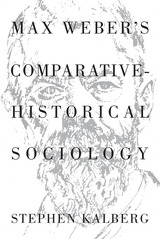 Max Weber's Comparative-Historical Sociology
Stephen Kalberg
University of Chicago Press, 1994 The revival of historical sociology in recent decades has largely neglected the contributions of Max Weber. Yet Weber's writings offer a fundamental resource for analyzing problems of comparative historical development. Stephen Kalberg rejects the view that Weber's historical writings consist of an ambiguous mixture of fragmented ideal types on the one hand and the charting of vast processes of rationalization and bureaucracy on the other. On the contrary, Weber's substantive work offers a coherent and distinctive model for comparative analysis. A reconstruction of Weber's comparative historical method, Kalberg argues, uncovers a sophisticated outlook that addresses problems of agency and structure, multiple causation, and institutional interpretation. Kalberg shows how such a representation of Weber's work casts a direct light upon issues of pressing importance in comparative historical studies today. Weber addresses in a forceful way the whole range of issues confronted by the comparative historical enterprise. Once the full analytical and empirical power of Weber's historical writings becomes clear, Weber's work can be seen to generate procedures and strategies appropriate to the study of present day as well as past social processes. Written in an accessible and engaging fashion, this book will appeal to students and professionals in the areas of sociology, anthropology, and comparative history.
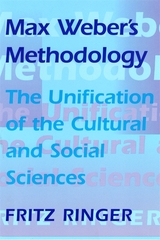 Max Weber’s Methodology: The Unification of the Cultural and Social Sciences
Fritz Ringer
Harvard University Press, 1997 At a time when historical and cultural analyses are being subjected to all manner of ideological and disciplinary prodding and poking, the work of Max Weber, the brilliant social theorist and one of the most creative intellectual forces in the twentieth century, is especially relevant. In this significant study, Fritz Ringer offers a new approach to the work of Weber, interpreting his methodological writings in the context of the lively German intellectual debates of his day. According to Ringer, Weber was able to bridge the intellectual divide between humanistic interpretation and causal explanation in historical and cultural studies in a way that speaks directly to our own time, when methodological differences continue to impede fruitful cooperation between humanists and social scientists. In the place of the humanists' subjectivism and the social scientists' naturalism, Weber developed the flexible and realistic concepts of objective probability and adequate causation.
Grounding technical theories in specific examples, Ringer has written an essential text for all students of Weber and of social theory in the humanities and social sciences. Fully reconstructed, Max Weber's methodological position in fact anticipated the most fruitful directions in our own contemporary philosophies of the cultural and social sciences. Ringer's conceptualization of Weber's approach and achievement elucidates Weber's reconciliation of interpretive understanding and causal explanation and shows its relevance to intellectual life and culture in Weber's own time and in ours as well.
 Maxime Weygand and Civil-Military Relations in Modern France
Philip Charles Farwell Bankwitz
Harvard University Press Between the two World Wars, particularly in the 1930s, the relations between the French civilian government and the Army went through a series of devastating changes. These turbulent developments culminated in the refusal of the Army’s leaders to obey their civilian superiors during the catastrophe of June 1940, the first such insubordination in modern French republican history. The author examines every aspect of this disastrous process, pursuing his analysis largely through the activities and thought of General Maxime Weygand, who, although deeply affected by the loss of civil–military trust, contributed importantly to it and eventually led the Army in its disobedience.
Philip Bankwitz finds the seeds of the disaffection between the French civilian authorities and the military in a variety of interconnected elements. During the early 1930s, for example, the soldiers became convinced that the Government’s policies concerning service time, military appropriations, and disarmament were pushing the Army to the brink of ruin. The Third Republic was highly unstable politically, as was shockingly demonstrated in February 1934 when the Government leaders resigned in the face of violent disorders in Paris attendant on the Stavisky Affair which climaxed two years of internal strife. Among soldiers, aware of the Government’s weakness, suspicious of its alleged antimilitarism, and fearful of the approaching conflict with Nazi Germany, there was a growing and almost unconscious tendency to think in terms of the possible need to extend the protection of the Army to the nation in its difficulties. In this way, important elements in the officer corps began, psychologically and emotionally, “to prepare for eventual intervention in national political affairs.”
General Weygand, whom the author interviewed on numerous occasions, held the personal conviction that the distrust between the civilian and military establishments was the root cause of French defeat. Mr. Bankwitz is convinced that this opinion of Weygand’s is possibly the single most important clue to the puzzling connection between the civil–military relationship and the collapse of June 1940. Granting all the other factors contributing to the defeat, it would be impossible to exaggerate the historical importance of Weygand’s disobedience—an act which also opened the way for later military saviors and for the ascendant role of the Army in French politics.
This is the first scholarly study in depth of the crucial prewar phase of the French army’s development into a disruptive force in national life. A chapter from the portentous twentieth-century story of the soldier in politics, it has relevance now to situations already formed or forming in other western societies. The value of the book is greatly enhanced by an encyclopedic bibliography of writing on French political history in this century.
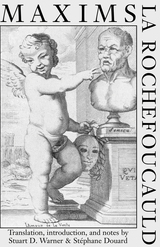 Maxims
La Rochefoucauld
St. Augustine's Press, 2009 This is the first-ever French-English edition of La Rochefoucauld’s Réflexions, ou sentences et maximes morales, long known in English simply as the Maxims. The translation, the first to appear in forty years, is completely new and aims – unlike all previous versions – at being as literal as possible. This involves, among other things, rendering the same word – for example, amour-propre as “self-love” – as consistently throughout as good sense allows. This also means that the translators have made every effort to maintain La Rochefoucauld’s word order. This allows the reader the best vantage point for viewing La Rochefoucauld’s dramatic and paradoxical juxtapositions of words and ideas, juxtapositions of the utmost importance to understanding his thought. Despite the translation’s concern with literalness, careful attention has been paid to the nuances of the literary character of the Maxims. In addition, this work contains a series of detailed indices that will greatly aid the reader in finding just the right maxim, and an updated version, in English, of the original French index of the work. At the heart of La Rochefoucauld’s Maxims lies the attempt to disclose the great disparity between the exaggerated self-estimation of men and women and their actual condition. As La Rochefoucauld (1613–1680) unremittingly unmasks various pretenses, heelaborately exposes the complexity of motives which underlie and inform human conduct: whereas many endeavor to reveal a unity in plurality, La Rochefoucauld endeavors to reveal a plurality in unity. Playful, yet serious, humorous, ironic yet direct, poetic yet philosophical, the Maxims penetrate to themes at the center of reflection and judgment about the human situation. Worthy of study at any time, the Maxims are especially relevant in the strange times in which we live. This edition includes the 504 maxims of the definitive, fifth edition of 1678, along with 137 other maxims which were either withdrawn from earlier editions or published posthumously. In addition to the maxims, La Rochefoucauld’s self-portrait and Cardinal de Retz’s portrait of La Rochefoucauld are also included.
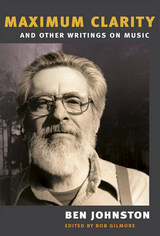 "Maximum Clarity" and Other Writings on Music
Ben Johnston. Edited by Bob Gilmore
University of Illinois Press, 2022 Described by New York Times critic John Rockwell as "one of the best non-famous composers this country has to offer," Ben Johnston reconceives familiar idioms--ranging from neoclassicism and serialism to jazz and southern hymnody--using just intonation. Johnston studied with Darius Milhaud, Harry Partch, and John Cage, and is best known for his String Quartet No. 4, a complex series of variations on Amazing Grace. This collection spans forty years and brings together forty-one of Johnston's most important writings, including many rare and several previously unpublished selections. They include position papers, theoretical treatises, program notes, historical reflections, lectures, excerpts from interviews, and letters, and they cover a broad spectrum of concerns--from the technical exegesis of microtonality to the personal and the broadly humanistic. A discography of commercially available recordings of Johnston's music closes out the collection.
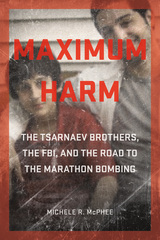 Maximum Harm: The Tsarnaev Brothers, the FBI, and the Road to the Marathon Bombing
Michele R. McPhee
University Press of New England, 2017 In Maximum Harm, veteran investigative journalist Michele R. McPhee unravels the complex story behind the public facts of the Boston Marathon bombing. She examines the bombers’ roots in Dagestan and Chechnya, their struggle to assimilate in America, and their growing hatred of the United States—a deepening antagonism that would prompt federal prosecutors to dub Dzhokhar Tsarnaev “America's worst nightmare.” The difficulties faced by the Tsarnaev family of Cambridge, Massachusetts, are part of the public record. Circumstances less widely known are the FBI’s recruitment of the older brother, Tamerlan Tsarnaev, as a “mosque crawler” to inform on radical separatists here and in Chechnya; the tracking down and killing of radical Islamic separatists during the six months he spent in Russia—travel that raised eyebrows, since he was on several terrorist watchlists; the FBI’s botched deals and broken promises with regard to his immigration; and the disenchantment, rage, and growing radicalization of Tamerlan and Dzhokhar, along with their mother, sisters, and Tamerlan’s wife, Katherine. Maximum Harm is also a compelling examination of the Tsarnaev brothers’ movements in the days leading up to the Boston Marathon bombing on April 15, 2013, the subsequent investigation, the Tsarnaevs’ murder of MIT police officer Sean Collier, the high-speed chase and shootout that killed Tamerlan, and the manhunt in which the authorities finally captured Dzhokhar, hiding in a Watertown backyard. McPhee untangles the many threads of circumstance, coincidence, collusion, motive, and opportunity that resulted in the deadliest attack on the city of Boston to date.
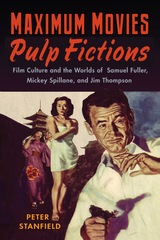 Maximum Movies—Pulp Fictions: Film Culture and the Worlds of Samuel Fuller, Mickey Spillane, and Jim Thompson
Stanfield, Peter
Rutgers University Press, 2011 In the words of Richard Maltby . . . "Maximum Movies--Pulp Fictions describes two improbably imbricated worlds and the piece of cultural history their intersections provoked." One of these worlds comprises a clutch of noisy, garish pulp movies--Kiss Me Deadly, Shock Corridor, Fixed Bayonets!, I Walked with a Zombie, The Lineup, Terror in a Texas Town, Ride Lonesome--pumped out for the grind houses at the end of the urban exhibition chain by the studios' B-divisions and fly-by-night independents. The other is occupied by critics, intellectuals, cinephiles, and filmmakers such as Jean-Luc Godard, Manny Farber, and Lawrence Alloway, who championed the cause of these movies and incited the cultural guardians of the day by attacking a rigorously policed canon of tasteful, rarified, and ossified art objects. Against the legitimate, and in defense of the illegitimate, in an insolent and unruly manner, they agitated for the recognition of lurid sensational crime stories, war pictures, fast-paced Westerns, thrillers, and gangster melodramas were claimed as examples of the true, the real, and the authentic in contemporary culture--the foundation upon which modern film studies sits.
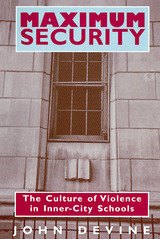 Maximum Security: The Culture of Violence in Inner-City Schools
John Devine
University of Chicago Press, 1996 Escalations in student violence continue throughout the nation, but inner-city schools are the hardest hit, with classrooms and corridors infected by the anger, aggression, and criminality endemic to street life. Technological surveillance, security personnel, and paramilitary control tactics to maintain order and safety are the common administrative response. Essential educational programs are routinely slashed from school budgets, even as the number of guards, cameras, and metal detectors continues to multiply.
Based on years of frontline experience in New York's inner-city schools, Maximum Security demonstrates that such policing strategies are not only ineffectual, they divorce students and teachers from their ethical and behavioral responsibilities. Exploring the culture of violence from within, John Devine argues that the security system, with its uniformed officers and invasive high-tech surveillance, has assumed presumptive authority over students' bodies and behavior, negating the traditional roles of teachers as guardians and agents of moral instruction. The teacher is reduced to an information bureaucrat, a purveyor of technical knowledge, while the student's physical well-being and ethical actions are left to the suspect scrutiny of electronic devices and security specialists with no pedagogical mission, training, or interest. The result is not a security system at all, but an insidious institutional disengagement from the caring supervision of the student body.
With uncompromising honesty, Devine provides a powerful portrayal of an educational system in crisis and bold new insight into the malignant culture of school violence.
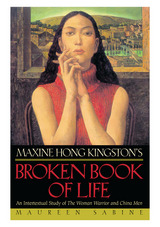 Maxine Hong Kingston's Broken Book of Life: An Intertextual Study of "The Woman Warrior" and "China Men"
Maureen Sabine
University of Hawaii Press, 2004 The numerous studies of Maxine Hong Kingston's touchstone work The Woman Warrior fail to take into account the stories in China Men, which were largely written together with those in The Woman Warrior but later published separately. Although Hong Kingston's decision to separate the male and female narratives enabled readers to see the strength of the resulting feminist point of view in The Woman Warrior, the author has steadily maintained that to understand the book fully it was necessary to read its male companion text.
Maureen Sabine's ambitious study of The Woman Warrior and China Men aims to bring these divided texts back together with a close reading that looks for the textual traces of the father in The Woman Warrior and shows how the daughter narrator tracks down his history in China Men. She considers theories of intertextuality that open up the possibility of a dynamic interplay between the two books and suggests that the Hong family women and men may be struggling for dialogue with each other even when they appear textually silent or apart.
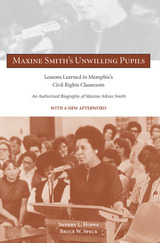 Maxine Smith's Unwilling Pupils: Lessons Learned in Memphis's Civil Rights Classroom
Sherry L. Hoppe and Bruce W. Speck
University of Tennessee Press, 2007
Maxine Smith's Unwilling Pupils is the authorized biography of Maxine Atkins Smith. As such it tells the story of the civil rights movement in Memphis from Smith's viewpoint. Primarily based on newspaper accounts from the 1960s and 1970s and on Smith's papers housed at the Memphis Public Library, the book also draws from a rich source of interviews conducted by the coauthors and others.
This book presents a well-balanced historical background of the civil rights era even while serving as a tribute to Maxine Smith and her work. A panoramic view of Maxine's life, Maxine Smith's Unwilling Pupils, presents one woman's struggle as a prism for understanding the human dimensions of the fight for equality.
The biography portrays Smith's lifelong focus on education as she tried to enlighten both blacks and whites about equality and the inalienable rights of all races. Along the way she became the face of the civil rights movement in Memphis during a critical time in the movement's history. Maxine's unwilling pupils often hated her for her outspoken and tenacious advocacy for those rights; her followers loved her for her unwavering commitment to ensure the rights of African Americans.
Smith's selfless struggles as chronicled in this biography will leave no doubt that her influence on the progress of civil rights in Memphis was profound. Moreover, her example of tireless commitment should inspire the efforts of new generations of equal rights activists to come.
Sherry L. Hoppe is president of Austin Peay State University. She has coedited a number of volumes with Bruce W. Speck in the New Directions for Teaching and Learning series. She is coeditor, with Dr. Speck, of Service-Learning: History, Theory, and Issues.
Bruce W. Speck is provost and vice president for academic and student affairs at Austin Peay State University. He is the co-author, with Jordy Rocheleau, of Rights and Wrongs in the College Classroom: Ethical Issues in Postsecondary Teaching. He has written numerous articles and contributed to edited volumes.
Maxwell on the Electromagnetic Field: A Guided Study
Thomas K. Simpson
Rutgers University Press, 1997 In this volume in the Masterworks of Discovery series, Thomas K. Simpson offers readers a chance to watch one of the greatest minds in physics hard at work. In three papers in mathematical physics written between 1855 and 1864, James Clerk Maxwell grappled with his formulation of the theory of the electromagnetic field.
This volume reproduces major portions of the text of Maxwell's classic papers on concepts that are key to both modern physics and the modern world. Through Simpson's engaginbg commentaries and notes and Anne Farrell's illustrations, readers with limited knowledge of math or physics as well as scientists and historians of science will be able to follow the emergence of Maxwell's ideas and to appreciate the magnitude of his achievement. This book includes a long biographical introduction that explores the personal, historical, and scientific context of Maxwell's book.
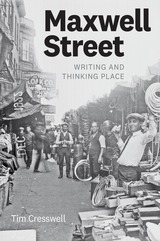 Maxwell Street: Writing and Thinking Place
Tim Cresswell
University of Chicago Press, 2019 What is the nature of place, and how does one undertake to write about it? To answer these questions, geographer and poet Tim Cresswell looks to Chicago’s iconic Maxwell Street Market area. Maxwell Street was for decades a place where people from all corners of the city mingled to buy and sell goods, play and listen to the blues, and encounter new foods and cultures. Now, redeveloped and renamed University Village, it could hardly be more different.
In Maxwell Street, Cresswell advocates approaching the study of place as an “assemblage” of things, meanings, and practices. He models this innovative approach through a montage format that exposes the different types of texts—primary, secondary, and photographic sources—that have attempted to capture the essence of the area. Cresswell studies his historical sources just as he explores the different elements of Maxwell Street—exposing them layer by layer. Brilliantly interweaving words and images, Maxwell Street sheds light on a historic Chicago neighborhood and offers a new model for how to write about place that will interest anyone in the fields of geography, urban studies, or cultural history.
 Maxwell's Handbook for RDA: Explaining and Illustrating RDA
Robert L. Maxwell
American Library Association, 2013 Winner of several prestigious honors, including the 2014 ABC-CLIO Greenwood Award for the Best Book in Library Literature, the first edition of this clear and comprehensive handbook has become an essential resource for catalogers, LIS students, and cataloging instructors. Now, in this second edition, Maxwell explains the changes to RDA: Resource Description and Access brought about by 3R, and brings his handbook fully in line with all the new developments. Designed to interpret and explain RDA, this resource illustrates the cataloging standard for every type of information format. From books to electronic materials to music and beyond, Maxwell - explains the alignment of the new RDA with the IFLA’s Library Reference Model (LRM), offering value to library and cultural heritage communities;
- incorporates the changes made to the RDA Toolkit after the completion of the 3R Project that allow for greater personalization and accessibility;
- addresses the new structural changes to RDA that allow for greater flexibility and reuse;
- explores the new emphasis on relationships between entities and what it means for RDA users; and
- provides abundant sample records to illustrate RDA principles.
 May '68
Donald M. Reid and Daniel J. Sherman, special issue editors
Duke University Press, 2018 This issue presents new directions in the study of the civil unrest in France during May 1968 on its fiftieth anniversary. Authors from France and the United States emphasize the nature and experience of the political upheaval in May 1968, the long-term cultural impacts of events in Paris, and the ways in which these events figures into a global context. Contributors offer new ways of understanding and interpreting the discord by focusing on the emotional and cultural resonance of the events of May 1968 in activism and popular culture. Other essays explore the relation of student activism in former French colonies to events in France, place the events of May 1968 in a global context by considering diplomatic and radical networks between Europe and the United States, and examine the cultural relationship between France and Germany.
Contributors: Ludivine Bantigny, Françoise Blum, Tony Côme, Boris Gobille, Bethany Keenan, Salar Mohandesi, Donald Reid, Sandrine Sanos, Daniel Sherman
 May '68 and Its Afterlives
Kristin Ross
University of Chicago Press, 2002 During May 1968, students and workers in France united in the biggest strike and the largest mass movement in French history. Protesting capitalism, American imperialism, and Gaullism, 9 million people from all walks of life, from shipbuilders to department store clerks, stopped working. The nation was paralyzed—no sector of the workplace was untouched. Yet, just thirty years later, the mainstream image of May '68 in France has become that of a mellow youth revolt, a cultural transformation stripped of its violence and profound sociopolitical implications.
Kristin Ross shows how the current official memory of May '68 came to serve a political agenda antithetical to the movement's aspirations. She examines the roles played by sociologists, repentant ex-student leaders, and the mainstream media in giving what was a political event a predominantly cultural and ethical meaning. Recovering the political language of May '68 through the tracts, pamphlets, and documentary film footage of the era, Ross reveals how the original movement, concerned above all with the question of equality, gained a new and counterfeit history, one that erased police violence and the deaths of participants, removed workers from the picture, and eliminated all traces of anti-Americanism, anti-imperialism, and the influences of Algeria and Vietnam. May '68 and Its Afterlives is especially timely given the rise of a new mass political movement opposing global capitalism, from labor strikes and anti-McDonald's protests in France to the demonstrations against the World Trade Organization in Seattle.
May '68: Shaping Political Generations
Julie Pagis
Amsterdam University Press, 2018 Much as in other locations around the world, civil uprising, particularly rooted in the activism of young people and students, plagued France during May of 1968. Massive strikes and occupations succeeded in paralysing France’s economy and bringing the country to the verge of a leftist revolution. This book studies the life trajectories of many ordinary protesters during the period, using statistics and personal narratives to analyse how this activism arose, its impact on people’s personal and professional lives, and its transmission through familial generations.
May All Your Fences Have Gates: Essyas on the Drama of August Wilson
Alan Nadel
University of Iowa Press, 1993 This stimulating collection of essays, the first comprehensive critical examination of the work of two-time Pulitzer Prize-winning playwright August Wilson, deals individually with his five major plays and also addresses issues crucial to Wilson's canon: the role of history, the relationship of African ritual to African American drama, gender relations in the African American community, music and cultural identity, the influence of Romare Bearden's collages, and the politics of drama. The collection includes essays by virtually all the scholars who have currently published on Wilson along with many established and newer scholars of drama and/or African American literature.
 May Days
Samuel F., Jr. Pickering
University of Iowa Press, 1995 In this collection of eleven wry essays, Samuel Pickering illuminates the ordinary, making what is common in life stand out with gemlike brilliance. An amateur naturalist and devoted father, Pickering offers his reflections on family lore, curious artifacts, the endearing absurdities of everyday life, and his attempts to understand and appreciate the rich world of nature. With a self-ironic, unpretentious voice, Pickering takes us to the bucolic settings of rural Nova Scotia and small-town Tennessee, as well as a New England academic environment. There we witness his balancing act between suburban and rural life, between the pressures of the workaday world and the temptation of nature, the call to explore what is so often ignored, the need to remember the roots of our past. Whether writing about Miss Kitty and Miss Jo Sewall, E. W. Childers and the fish he caught in Difficult Creek, or the naming and renaming of flowers—Purple Orchis, Skullcap, Riverwater Pink—Pickering reveals an inquiring, gentle regard for nature and humanity. His anecdotes present the history and folklore of his own family as well as Everyman's history and lore as he uncovers some of the subtle truths that lie unnoticed in the common events and realities of life.
 The May Fourth Movement: Intellectual Revolution in Modern China
Tse-tsung Chow
Harvard University Press All observers agree that the movement named for the students’ mass demonstration of May 4, 1919, is a turning point in China’s history; yet its precise significance is disputed. The Chinese Communists see it as the beginning of a popular movement that brought them to power thirty years later. The heart of the movement, as carefully described in Tse-tsung Chow’s volume, involved, in the first instance, the criticism by China’s young intelligentsia of traditional thought and institutions. It involved a search for new solutions in terms of Western democracy and science. The movement, which roughly covers the years 1917–1921, was intensified to new heights by the student strikes of 1919 against the decisions on China reached at Versailles and against the Chinese government’s policy toward Japan. The ideas and tendencies that arose out of the movement have determined the subsequent course of Chinese history. Without an understanding of this movement, recent Chinese history remains a closed book.
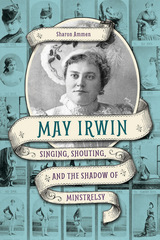 May Irwin: Singing, Shouting, and the Shadow of Minstrelsy
Sharon Ammen
University of Illinois Press, 2017 May Irwin reigned as America's queen of comedy and song from the 1880s through the 1920s. A genuine pop culture phenomenon, Irwin conquered the legitimate stage, composed song lyrics, and parlayed her celebrity into success as a cookbook author, suffragette, and real estate mogul.
Sharon Ammen's in-depth study traces Irwin's hurly-burly life. Irwin gained fame when, layering aspects of minstrelsy over ragtime, she popularized a racist "Negro song" genre. Ammen examines this forgotten music, the society it both reflected and entertained, and the ways white and black audiences received Irwin's performances. She also delves into Irwin's hands-on management of her image and career, revealing how Irwin carefully built a public persona as a nurturing housewife whose maternal skills and performing acumen reinforced one another. Irwin's act, soaked in racist song and humor, built a fortune she never relinquished. Yet her career's legacy led to a posthumous obscurity as the nation that once adored her evolved and changed.
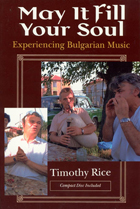 May It Fill Your Soul: Experiencing Bulgarian Music
Timothy Rice
University of Chicago Press, 1994 In this vivid musical ethnography, Timothy Rice documents and interprets the history of folk music, song, and dance in Bulgaria over a seventy-year period of dramatic change. From 1920 to 1989, Bulgaria changed from a nearly medieval village society to a Stalinist planned industrial economy to a chaotic mix of capitalist and socialist markets and cultures.
In the context of this history, Rice brings Bulgarian folk music to life by focusing on the biography of the Varimezov family, including the musician Kostadin and his wife Todora, a singer. Combining interviews with his own experiences of learning how to play, sing and dance Bulgarian folk music, Rice presents one of the most detailed accounts of traditional, aural learning processes in the ethnomusicological literature.
Using a combination of traditionally dichotomous musicological and ethnographic approaches, Rice tells the story of how individual musicians learned their tradition, how they lived it during the pre-Communist era of family farming, how the tradition changed with industrialization brought under Communism, and finally, how it flourished and evolved in the recent, unstable political climate.
This work—complete with a compact disc and numerous illustrations and musical examples—contributes not only to ethnomusicological theory and method, but also to our understanding of Slavic folklore, Eastern European anthropology, and cultural processes in Socialist states.
 May You Live In Interesting Times
Tereze Gluck
University of Iowa Press, 1995
Obsession, adultery, infidelity, unrequited love, suicide, betrayal, death—Tereze Glück's clear-sighted characters coolly assess their actions and reactions. When a man's wife dies suddenly, he feels liberated, and learning this stuns him. Taking a leap into personhood, a child watching her mother in the garden experiences empathy. A woman addicted to a lover realizes how she has squandered herself. A kiss in a taxicab sets two people on the road to inevitability. Scars, even small ones, reflect the power and mystery of the roads people take from one life into another. In the intense title story, suicide, long-distance love, and a cat's nine lives overshadow a woman's subterranean life.
Glück's wry and rueful stories chronicle her characters' struggles to tell the truth regardless of where that might lead them. Insistent, stubbornly spirited voices inform these tales; Glück's characters dig in their heels and announce, for good or ill, “This is who I am.” In the end their moral integrity forces them to come face to face with themselves. At the intersection where these insightful stories take place, what is in one's heart and what one reveals to the world converge. Each story is a resonant act of self-discovery for both writer and reader.
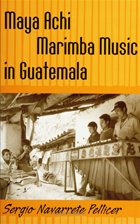 Maya Achi Marimba Music In Guatemala
Sergio Navarrete Pellicer
Temple University Press, 2005 For the Achi, one of the several Mayan ethnic groups indigenous to Guatemala, the music of the marimba serves not only as a form of entertainment but also as a form of communication, a vehicle for memory, and an articulation of cultural identity. Sergio Navarrete Pellicer examines the marimba tradition—the confluence of African musical influences, Spanish colonial power, and Indian ethnic assimilation—as a driving force in the dynamics of cultural continuity and change in Rabinal, the heart of Achi culture and society. By examining the performance and consumption of marimba music as essential parts of a system of social interaction, religious practice, and ethnic identification, Navarrete Pellicer reveals how the strains of the marimba resonate with the spiritual yearnings and cultural negotiations of the Achi as they try to come to terms with the violence and economic hardship wrought by their colonial past.
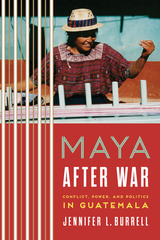 Maya after War: Conflict, Power, and Politics in Guatemala
By Jennifer L. Burrell
University of Texas Press, 2013 Guatemala’s thirty-six-year civil war culminated in peace accords in 1996, but the postwar transition has been marked by continued violence, including lynchings and the rise of gangs, as well as massive wage-labor exodus to the United States. For the Mam Maya municipality of Todos Santos Cuchumatán, inhabited by a predominantly indigenous peasant population, the aftermath of war and genocide resonates with a long-standing tension between state techniques of governance and ancient community-level power structures that incorporated concepts of kinship, gender, and generation. Showing the ways in which these complex histories are interlinked with wartime and enduring family/class conflicts, Maya after War provides a nuanced account of a unique transitional postwar situation, including the complex influence of neoliberal intervention. Drawing on ethnographic field research over a twenty-year period, Jennifer L. Burrell explores the after-war period in a locale where community struggles span culture, identity, and history. Investigating a range of tensions from the local to the international, Burrell employs unique methodologies, including mapmaking, history workshops, and an informal translation of a historic ethnography, to analyze the role of conflict in animating what matters to Todosanteros in their everyday lives and how the residents negotiate power. Examining the community-based divisions alongside national postwar contexts, Maya after War considers the aura of hope that surrounded the signing of the peace accords, and the subsequent doubt and waiting that have fueled unrest, encompassing generational conflicts. This study is a rich analysis of the multifaceted forces at work in the quest for peace, in Guatemala and beyond.
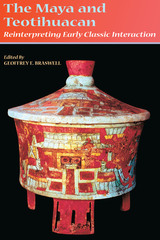 The Maya and Teotihuacan: Reinterpreting Early Classic Interaction
Edited by Geoffrey E. Braswell
University of Texas Press, 2003 The contributors to this volume present extensive new evidence from archaeology, iconography, and epigraphy to offer a more nuanced understanding of the interaction between the Early Classic Maya and Teotihuacan.
Winner, Choice Outstanding Academic Book, 2005 Since the 1930s, archaeologists have uncovered startling evidence of interaction between the Early Classic Maya and the great empire of Teotihuacan in Central Mexico. Yet the exact nature of the relationship between these two ancient Mesoamerican civilizations remains to be fully deciphered. Many scholars have assumed that Teotihuacan colonized the Maya region and dominated the political or economic systems of certain key centers—perhaps even giving rise to state-level political organizations. Others argue that Early Classic rulers merely traded with Teotihuacan and skillfully manipulated its imported exotic goods and symbol sets to increase their prestige. Moving beyond these traditional assumptions, the contributors to this volume present extensive new evidence from archaeology, iconography, and epigraphy to offer a more nuanced understanding of the interaction between the Early Classic Maya and Teotihuacan. Investigating a range of Maya sites, including Kaminaljuyu, Copán, Tikal, Altun Ha, and Oxkintok, they demonstrate that the influence of Teotihuacan on the Maya varied in nature and duration from site to site, requiring a range of models to explain the patterns of interaction. Moreover, they show that the interaction was bidirectional and discuss how the Maya in turn influenced Teotihuacan.
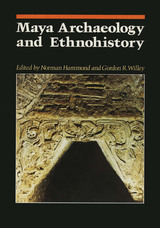 Maya Archaeology and Ethnohistory
Edited by Norman Hammond and Gordon R. Willey
University of Texas Press, 1979 Embracing a wide range of research, this book offers various views on the intellectual history of Maya archaeology and ethnohistory and the processes operating in the rise and fall of Maya civilization. The fourteen studies were selected from those presented at the Second Cambridge Symposium on Recent Research in Mesoamerican Archaeology and are presented in three major sections. The first of these deals with the application of theory, both anthropological and historical, to the great civilization of the Classic Maya, which flourished in the Yucatan, Guatemala, and Belize during the first millennium A.D. The structural remains of the Classic Period have impressed travelers and archaeologists for over a century, and aspects of the development and decline of this strange and brilliant tropical forest culture are examined here in the light of archaeological research. The second section presents the results of field research ranging from the Highlands of Mexico east to Honduras and north into the Lowland heart of Maya civilization, and iconographic study of excavated material. The third section covers the ethnohistoric approach to archaeology, the conjunction of material and documentary evidence. Early European documents are used to illuminate historic Maya culture. This section includes transcriptions of previously unpublished archival material. Although not formally linked beyond their common field of inquiry, the essays here offer a conspectus of late-twentieth century Maya research and a series of case histories of the work of some of the leading scholars in the field.
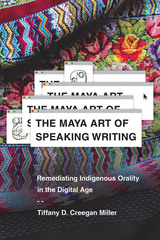 The Maya Art of Speaking Writing: Remediating Indigenous Orality in the Digital Age
Tiffany D. Creegan Miller
University of Arizona Press, 2022 Challenging the distinctions between “old” and “new” media and narratives about the deprecation of orality in favor of inscribed forms, The Maya Art of Speaking Writing draws from Maya concepts of tz’ib’ (recorded knowledge) and tzij, choloj, and ch’owen (orality) to look at expressive work across media and languages.
Based on nearly a decade of fieldwork in the Guatemalan highlands, Tiffany D. Creegan Miller discusses images that are sonic, pictorial, gestural, and alphabetic. She reveals various forms of creativity and agency that are woven through a rich media landscape in Indigenous Guatemala, as well as Maya diasporas in Mexico and the United States. Miller discusses how technologies of inscription and their mediations are shaped by human editors, translators, communities, and audiences, as well as by voices from the natural world.
These texts push back not just on linear and compartmentalized Western notions of media but also on the idea of the singular author, creator, scholar, or artist removed from their environment. The persistence of orality and the interweaving of media forms combine to offer a challenge to audiences to participate in decolonial actions through language preservation.
The Maya Art of Speaking Writing calls for centering Indigenous epistemologies by doing research in and through Indigenous languages as we engage in debates surrounding Indigenous literatures, anthropology, decoloniality, media studies, orality, and the digital humanities.
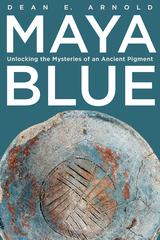 Maya Blue: Unlocking the Mysteries of an Ancient Pigment
Dean E. Arnold
University Press of Colorado, 2025 One of the great technological achievements of the ancient Maya, Maya Blue is one the world’s most unusual ancient pigments. In Maya Blue, Dean E. Arnold offers a comprehensive history of its study for almost a century, filled with personal anecdotes drawn from his decades of work uncovering the Maya knowledge of its constituents, its ancient sources, and how it was made—including previously unknown methods. The book presents a fresh holistic perspective that documents these discoveries and the scientific process that led to them and provides testable hypotheses about how the pigment and the technology used to make it moved throughout Mesoamerica.
Combining the organic dye indigo and the inorganic clay mineral palygorskite in a highly stable chemical hybrid that, unlike indigo, resists attacks by acids, alkalines, and organic solvents and endures without fading, Maya Blue has a rich blue color that has survived for centuries in one of the world’s harshest climates. First used at the site of Calakmul in the tropical forest of southern Mexico during the Late Preclassic period, the Maya’s abiding hue diffused across Mesoamerica over a period of 1,700 years. It appears on Maya pottery, sculpture, murals, and codices and carries multiple meanings, standing as a symbol for cultural cornerstones such as sacrifice and the rain god Chaak. It was discovered in 1931 at Chichén Itzá, and its composition was a mystery for more than three decades, then questions about its source, how and why it achieved such stability, and how and why the Maya made the pigment persisted even longer.
In Maya Blue, Arnold summarizes ethnographic, archaeological, chemical, and material science research over the last century from an anthropological perspective. This thorough, engaging, and accessible book chronicles the history of this pigment as no work has done before.
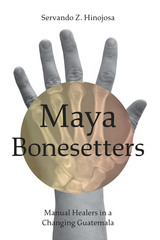 Maya Bonesetters: Manual Healers in a Changing Guatemala
By Servando Z. Hinojosa; Illustrations by Servando G. Hinojosa
University of Texas Press, 2020 Scholarship on Maya healing traditions has focused primarily on the roles of midwives, shamans, herbalists, and diviners. Bonesetters, on the other hand, have been largely excluded from conversations about traditional health practitioners and community health resources. Maya Bonesetters is the first book-length study of bonesetting in Guatemala and situates the manual healing tradition within the current cultural context—one in which a changing medical landscape potentially threatens bonesetters’ work yet presents an opportunity to strengthen its relevance. Drawing on extensive field research in highland Guatemala, Servando Z. Hinojosa introduces readers to a seldom documented, though nonetheless widespread, variety of healer. This book examines the work of Kaqchikel and Tz’utujiil Maya bonesetters, analyzes how they diagnose and treat injuries, and contrasts the empirical and sacred approaches of various healers. Hinojosa shows how bonesetters are carefully adapting certain biomedical technologies to meet local expectations for care and concludes that, despite pressures and criticisms from the biomedical community, bonesetting remains culturally meaningful and vital to Maya people, even if its future remains uncertain.
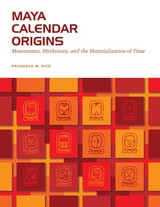 Maya Calendar Origins: Monuments, Mythistory, and the Materialization of Time
By Prudence M. Rice
University of Texas Press, 2007 In Maya Political Science: Time, Astronomy, and the Cosmos, Prudence M. Rice proposed a new model of Maya political organization in which geopolitical seats of power rotated according to a 256-year calendar cycle known as the May. This fundamental connection between timekeeping and Maya political organization sparked Rice's interest in the origins of the two major calendars used by the ancient lowland Maya, one 260 days long, and the other having 365 days. In Maya Calendar Origins, she presents a provocative new thesis about the origins and development of the calendrical system. Integrating data from anthropology, archaeology, art history, astronomy, ethnohistory, myth, and linguistics, Rice argues that the Maya calendars developed about a millennium earlier than commonly thought, around 1200 BC, as an outgrowth of observations of the natural phenomena that scheduled the movements of late Archaic hunter-gatherer-collectors throughout what became Mesoamerica. She asserts that an understanding of the cycles of weather and celestial movements became the basis of power for early rulers, who could thereby claim "control" over supernatural cosmic forces. Rice shows how time became materialized—transformed into status objects such as monuments that encoded calendrical or temporal concerns—as well as politicized, becoming the foundation for societal order, political legitimization, and wealth. Rice's research also sheds new light on the origins of the Popol Vuh, which, Rice believes, encodes the history of the development of the Mesoamerican calendars. She also explores the connections between the Maya and early Olmec and Izapan cultures in the Isthmian region, who shared with the Maya the cosmovision and ideology incorporated into the calendrical systems.
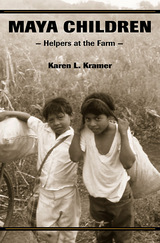 Maya Children: Helpers at the Farm
Karen L. Kramer
Harvard University Press, 2005 Among the Maya of Xculoc, an isolated farming village in the lowland forests of the Yucatán peninsula, children contribute to household production in considerable ways. Thus this village, the subject of anthropologist Karen Kramer's study, affords a remarkable opportunity for understanding the economics of childhood in a pre-modern agricultural setting.
Drawing on a range of theoretical perspectives and extensive data gathered over many years, Kramer interprets the form, value, and consequences of children's labor in this maize-based culture. She looks directly at family size and birth spacing as they figure in the economics of families; and she considers the timing of children's economic contributions and their role in underwriting the cost of large families. Kramer's findings--in particular, that the children of Xculoc begin to produce more than they consume long before they marry and leave home--have a number of interesting implications for the study of family reproductive decisions and parent-offspring conflict, and for debates within anthropology over children's contributions in hunter/gatherer versus agricultural societies.
With its theoretical breadth, and its detail on crop yields, reproductive histories, diet, work scheduling, and agricultural production, this book sets a new standard for measuring and interpreting child productivity in a subsistence farming community.
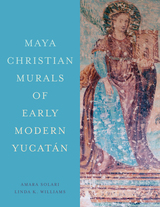 Maya Christian Murals of Early Modern Yucatán
Amara SolariLinda K. Williams
University of Texas Press, 2024 The first study of Christian murals created by indigenous artists in sixteenth and seventeenth century Yucatán. In the sixteenth and seventeenth centuries, Maya artists painted murals in churches and conventos of Yucatán using traditional techniques to depict iconography brought from Europe by Franciscan friars. The fragmentary visual remains and their placement within religious structures embed Maya conceptions of sacredness beyond the didactic imagery. Mobilizing both cutting-edge technology and tried-and-true analytical methods, art historians Amara Solari and Linda K. Williams reexamine the Maya Christian murals, centering the agency of the people who created them. The first volume to comprehensively document the paintings, Maya Christian Murals of Early Modern Yucatán collects new research on the material composition of the works, made possible by cutting-edge imaging methods. Solari and Williams investigate pigments and other material resources, as well as the artists and historical contexts of the murals. The authors uncover numerous local innovations in form and content, including images celebrating New World saints, celestial timekeeping, and ritual processions. Solari and Williams argue that these murals were not simply vehicles of coercion, but of cultural “grafting,” that allowed Maya artists to shape a distinctive and polyvocal legacy in their communities.
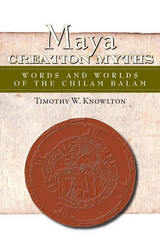 Maya Creation Myths: Words and Worlds of the Chilam Balam
Timothy Knowlton
University Press of Colorado, 2010 There is no Classical Yucatecan Maya word for "myth." But around the close of the seventeenth century, an anonymous Maya scribe penned what he called u kahlay cab tu kinil, "the world history of the era," before Christianity came to the Peten. He collected numerous accounts of the cyclical destruction and reestablishment of the cosmos; the origins of gods, human beings, and the rituals and activities upon which their relationship depends; and finally the dawn of the sun and the sacred calendar Maya diviners still use today to make sense of humanity's place in the otherwise inscrutable march of time. These creation myths eventually became part of the documents known today as the Books of Chilam Balam. Maya Creation Myths provides not only new and outstanding translations of these myths but also an interpretive journey through these often misunderstood texts, providing insight into Maya cosmology and how Maya intellectuals met the challenge of the European clergy's attempts to eradicate their worldviews. Unlike many scholars who focus primarily on traces of pre-Hispanic culture or Christian influence within the Books of Chilam Balam, Knowlton emphasizes the diversity of Maya mythic traditions and the uniquely Maya discursive strategies that emerged in the Colonial period. This book will be of significant interest to Maya scholars, folklorists, and historians, as well as students and scholars of religion, cosmology, and anthropology.
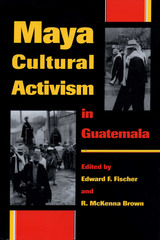 Maya Cultural Activism in Guatemala
Edited by Edward F. Fischer and R. McKenna Brown
University of Texas Press, 1996 Maya Cultural Activism in Guatemala marks a new era in Guatemalan studies by offering an up-to-the-minute look at the pan-Maya movement and the future of the Maya people as they struggle to regain control over their cultural destiny. The successful emergence of what is in some senses a nationalism grounded in ethnicity and language has challenged scholars to reconsider their concepts of nationalism, community, and identity. Editors Edward F. Fischer and R. McKenna Brown have brought together essays by virtually all the leading U.S. experts on contemporary Maya communities and the top Maya scholars working in Guatemala today. Supplementing scholarly analysis of Mayan cultural activism is a position statement originating within the movement and more wide-ranging and personal reflections by anthropologists and linguists who have worked with the Maya over the years. Among the broader issues that come in for examination are the complex relations between U.S. Mayanists and the Mayan cultural movement, efforts to promote literacy in Mayan languages, the significance of woven textiles and native dress, the relations between language and national identity, and the cultural meanings that the present-day Maya have encountered in ancient Mayan texts and hieroglyphic writing.
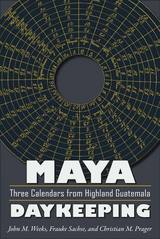 Maya Daykeeping: Three Calendars from Highland Guatemala
John M. Weeks
University Press of Colorado, 2009 In Maya Daykeeping, three divinatory calendars from highland Guatemala - examples of a Mayan literary tradition that includes the Popul Vuh, Annals of the Cakchiquels, and the Titles of the Lords of Totonicapan - dating to 1685, 1722, and 1855, are transcribed in K'iche or Kaqchikel side-by-side with English translations. Calendars such as these continue to be the basis for prognostication, determining everything from the time for planting and harvest to foreshadowing illness and death. Good, bad, and mixed fates can all be found in these examples of the solar calendar and the 260-day divinatory calendar. The use of such calendars is mentioned in historical and ethnographic works, but very few examples are known to exist. Each of the three calendars transcribed and translated by John M. Weeks, Frauke Sachse, and Christian M. Prager - and housed at the University of Pennsylvania Museum of Archaeology and Anthropology - is unique in structure and content. Moreover, except for an unpublished study of the 1722 calendar by Rudolf Schuller and Oliver La Farge (1934), these little-known works appear to have escaped the attention of most scholars. Introductory essays contextualize each document in time and space, and a series of appendixes present previously unpublished calendrical notes assembled in the early twentieth century. Providing considerable information on the divinatory use of calendars in colonial highland Maya society previously unavailable without a visit to the University of Pennsylvania's archives, Maya Daykeeping is an invaluable primary resource for Maya scholars. Mesoamerican Worlds Series
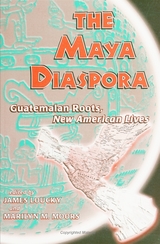 Maya Diaspora: Guatemalan Roots, New American Lives
edited by James Loucky and Marilyn M. Moors
Temple University Press, 2000 Maya people have lived for thousands of years in the mountains and forests of Guatemala, but they lost control of their land, becoming serfs and refugees, when the Spanish invaded in the sixteenth century. Under the Spanish and the Guatemalan non-Indian elites, they suffered enforced poverty as a resident source of cheap labor for non-Maya projects, particularly agriculture production. Following the CIA-induced coup that toppled Guatemala's elected government in 1954, their misery was exacerbated by government accommodation to United States "interests," which promoted crops for export and reinforced the need for cheap and passive labor.
This widespread poverty was endemic throughout northwestern Guatemala, where 80 percent of Maya children were chronically malnourished, and forced wide-scale migration to the Pacific coast. The self-help aid that flowed into the area in the 1960s and 1970s raised hopes for justice and equity that were brutally suppressed by Guatemala's military government. This military reprisal led to a massive diaspora of Maya throughout Canada, the United States, Mexico, and Central America.
This collection describes that process and the results. The chapters show the dangers and problems of the migratory/refugee process and the range of creative cultural adaptations that the Maya have developed. It provides the first comparative view of the formation and transformation of this new and expanding transnational population, presented from the standpoint of the migrants themselves as well as from a societal and international perspective. Together, the chapters furnish ethnographically grounded perspectives on the dynamic implications of uprooting and resettlement, social and psychological adjustment, long-term prospects for continued links to migration history from Guatemala, and the development of a sense of co-ethnicity with other indigenous people of Maya descent. As the Maya struggle to find their place in a more global society, their stories of quiet courage epitomize those of many other ethnic groups, migrants, and refugees today.
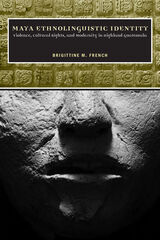 Maya Ethnolinguistic Identity: Violence, Cultural Rights, and Modernity in Highland Guatemala
Brigittine M. French
University of Arizona Press, 2010 In this valuable book, ethnographer and anthropologist Brigittine French mobilizes new critical-theoretical perspectives in linguistic anthropology, applying them to the politically charged context of contemporary Guatemala. Beginning with an examination of the “nationalist project” that has been ongoing since the end of the colonial period, French interrogates the “Guatemalan/indigenous binary.” In Guatemala, “Ladino” refers to the Spanish-speaking minority of the population, who are of mixed European, usually Spanish, and indigenous ancestry; “Indian” is understood to mean the majority of Guatemala’s population, who speak one of the twenty-one languages in the Maya linguistic groups of the country, although levels of bilingualism are very high among most Maya communities. As French shows, the Guatemalan state has actively promoted a racialized, essentialized notion of “Indians” as an undifferentiated, inherently inferior group that has stood stubbornly in the way of national progress, unity, and development—which are, implicitly, the goals of “true Guatemalans” (that is, Ladinos).
French shows, with useful examples, how constructions of language and collective identity are in fact strategies undertaken to serve the goals of institutions (including the government, the military, the educational system, and the church) and social actors (including linguists, scholars, and activists). But by incorporating in-depth fieldwork with groups that speak Kaqchikel and K’iche’ along with analyses of Spanish-language discourses, Maya Ethnolinguistic Identity also shows how some individuals in urban, bilingual Indian communities have disrupted the essentializing projects of multiculturalism. And by focusing on ideologies of language, the author is able to explicitly link linguistic forms and functions with larger issues of consciousness, gender politics, social positions, and the forging of hegemonic power relations.
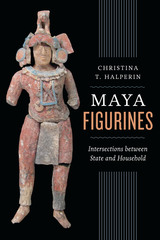 Maya Figurines: Intersections between State and Household
By Christina T. Halperin
University of Texas Press, 2014 Rather than view the contours of Late Classic Maya social life solely from towering temple pyramids or elite sculptural forms, this book considers a suite of small anthropomorphic, zoomorphic, and supernatural figurative remains excavated from household refuse deposits. Maya Figurines examines these often neglected objects and uses them to draw out relationships between the Maya state and its subjects. These figurines provide a unique perspective for understanding Maya social and political relations; Christina T. Halperin argues that state politics work on the microscale of everyday routines, localized rituals, and small-scale representations. Her comprehensive study brings together archeology, anthropology, and art history with theories of material culture, performance, political economy, ritual humor, and mimesis to make a fascinating case for the role politics plays in daily life. What she finds is that, by comparing small-scale figurines with state-sponsored, often large-scale iconography and elite material culture, one can understand how different social realms relate to and represent one another. In Maya Figurines, Halperin compares objects from diverse households, archeological sites, and regions, focusing especially on figurines from Petén, Guatemala, and comparing them to material culture from Belize, the northern highlands of Guatemala, the Usumacinta River, the Campeche coastal area, and Mesoamerican sites outside the Maya zone. Ultimately, she argues, ordinary objects are not simply passive backdrops for important social and political phenomena. Instead, they function as significant mechanisms through which power and social life are intertwined.
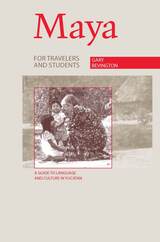 Maya for Travelers and Students: A Guide to Language and Culture in Yucatan
By Gary Bevington
University of Texas Press, 1995 The Yucatan Peninsula draws many North American and European travelers each year to view the ruins of the pre-Columbian Classical Maya civilization and the abundant native flora and fauna. For these travelers, as well as armchair travelers and students, Gary Bevington has prepared the first general English-language introduction to Yucatec Maya, the native language of the people indigenous to the region. Written in nontechnical terms for learners who have a basic knowledge of simple Mexican Spanish, the book presents easily understood, practical information for anyone who would like to communicate with the Maya in their native language. In addition to covering the pronunciation and grammar of Maya, Bevington includes invaluable tips on learning indigenous languages "in the field." Most helpful are his discussions of the cultural and material worlds of the Maya, accompanied by essential words and expressions for common objects and experiences. A Maya-English-Spanish glossary with extensive usage examples and an English-Maya glossary conclude the book. Note: The supplemental audiocasette, Spoken Maya for Travelers and Students, is now available as a free download through the book's page on the University of Texas Press's website.
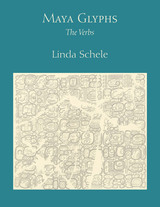 Maya Glyphs: The Verbs
By Linda Schele
University of Texas Press, 1982 The key to the study of the language and history of the Classic Maya (A.D. 293–900) is the verb. Maya Glyphs: The Verbs is a comprehensive study of the verb morphology and syntax of the Maya writing system. Linda Schele's summary of methodology makes available in a single place many important discoveries and approaches to the Maya language. Hers is the first sourcebook to include so broad a range of dates and to identify for the first time so many Maya rulers and events. The admirably lucid text provides an excellent introduction to Maya hieroglyphics for the beginner, and, for the experienced Mayanist, it offers a fascinating explanation of methodology, including paraphrasing, and important information about syntactical structures, special verbal constructions, and literary conventions. Schele's extensive catalog of known verbal phrases is useful for a variety of purposes. Because it is organized according to verbal affix patterns, it provides the only available source for the distribution of such patterns in the writing system. At the same time it registers the date of each event, its agent and patient (if recorded), the dedication date of the monument on which the glyphs occur, and a pictorial illustration, rather than a T-number transcription, of each example. Extensive notes treating problems of dating, interpretation, and dynastic information contain theories about the meaning and function of the events recorded in the Maya inscriptions.
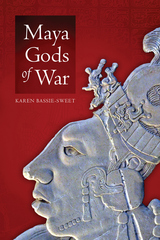 Maya Gods of War
Karen Bassie-Sweet
University Press of Colorado, 2021 Numerous archaeological projects have found substantial evidence of the military nature of Maya society, and warfare is a frequent theme of Maya art. Maya Gods of War investigates the Classic period Maya gods who were associated with weapons of war and the flint and obsidian from which those weapons were made.
Author Karen Bassie-Sweet traces the semantic markers used to distinguish flint from other types of stone, surveys various types of Chahk thunderbolt deities and their relationship to flint weapons, and explores the connection between lightning and the ruling elite. Additional chapters review these fire and solar deities and their roles in Maya warfare and examine the nature and manifestations of the Central Mexican thunderbolt god Tlaloc, his incorporation into the Maya pantheon, and his identification with meteors and obsidian weapons. Finally, Bassie-Sweet addresses the characteristics of the deity God L, his role as an obsidian merchant god, and his close association with the ancient land route between the highland Guatemalan obsidian sources and the lowlands.
Through analysis of the nature of the Teotihuacán deities and exploration of the ways in which these gods were introduced into the Maya region and incorporated into the Maya worldview, Maya Gods of War offers new insights into the relationship between warfare and religious beliefs in Mesoamerica. This significant work will be of interest to scholars of Maya religion and iconography.
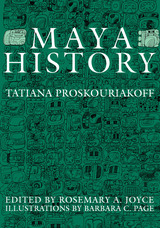 Maya History
By Tatiana Proskouriakoff
University of Texas Press, 1993 Tatiana Proskouriakoff, a preeminent student of the Maya, made many breakthroughs in deciphering Maya writing, particularly in demonstrating that the glyphs record the deeds of actual human beings, not gods or priests. This discovery opened the way for a history of the Maya, a monumental task that Proskouriakoff was engaged in before her death in 1985. Her work, Maya History, has been made ready for press by the able editorship of Rosemary Joyce. Maya History reconstructs the Classic Maya period (roughly A.D. 250-900) from the glyphic record on stelae at numerous sites, including Altar de Sacrificios, Copan, Dos Pilas, Naranjo, Piedras Negras, Quirigua, Tikal, and Yaxchilan. Proskouriakoff traces the spread of governmental institutions from the central Peten, especially from Tikal, to other city-states by conquest and intermarriage. Thirteen line drawings of monuments and over three hundred original drawings of glyphs amplify the text.
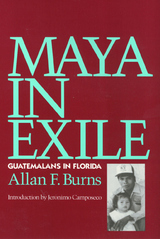 Maya In Exile: Guatemalans in Florida
Allan F. Burns, introduction by Jerónimo Camposeco
Temple University Press, 1993 The Maya are the single largest group of indigenous people living in North and Central America. Beginning in the early 1980s, hundreds of thousands of Maya fled the terror of Guatemalan civil strife to safety in Mexico and the U.S. This ethnography of Mayan immigrants who settled in Indiatown, a small agricultural community in south central Florida, presents the experiences of these traditional people, their adaptations to life in the U.S., and the ways they preserve their ancestral culture. For more than a decade, Allan F. Burns has been researching and doing advocacy work for these immigrant Maya, who speak Kanjobal, Quiche, Mamanâ, and several other of the more than thirty distinct languages in southern Mexico and Guatemala. In this fist book on the Guatemalan Maya in the U.S, he uses their many voices to communicate the experience of the Maya in Florida and describes the advantages and results of applied anthropology in refugee studies and cultural adaptation. Burns describes the political and social background of the Guatemalan immigrants to the U.S. and includes personal accounts of individual strategies for leaving Guatemala and traveling to Florida. Examining how they interact with the community and recreate a Maya society in the U.S., he considers how low-wage labor influences the social structure of Maya immigrant society and discusses the effects of U.S. immigration policy on these refugees.
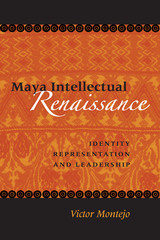 Maya Intellectual Renaissance: Identity, Representation, and Leadership
By Victor D. Montejo
University of Texas Press, 2005 When Mayan leaders protested the celebration of the Quincentenary of the "discovery" of America and joined with other indigenous groups in the Americas to proclaim an alternate celebration of 500 years of resistance, they rose to national prominence in Guatemala. This was possible in part because of the cultural, political, economic, and religious revitalization that occurred in Mayan communities in the later half of the twentieth century. Another result of the revitalization was Mayan students' enrollment in graduate programs in order to reclaim the intellectual history of the brilliant Mayan past. Victor Montejo was one of those students. This is the first book to be published outside of Guatemala where a Mayan writer other than Rigoberta Menchu discusses the history and problems of the country. It collects essays Montejo has written over the past ten years that address three critical issues facing Mayan peoples today: identity, representation, and Mayan leadership. Montejo is deeply invested in furthering the discussion of the effectiveness of Mayan leadership because he believes that self-evaluation is necessary for the movement to advance. He also criticizes the racist treatment that Mayans experience, and advocates for the construction of a more pluralistic Guatemala that recognizes cultural diversity and abandons assimilation. This volume maps a new political alternative for the future of the movement that promotes inter-ethnic collaboration alongside a reverence for Mayan culture.
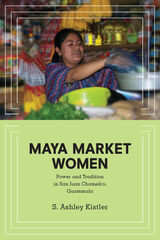 Maya Market Women: Power and Tradition in San Juan Chamelco, Guatemala
S. Ashley Kistler
University of Illinois Press, 2014 As cultural mediators, Chamelco's market women offer a model of contemporary Q'eqchi' identity grounded in the strength of the Maya historical legacy. Guatemala's Maya communities have faced nearly five hundred years of constant challenges to their culture, from colonial oppression to the instability of violent military dictatorships and the advent of new global technologies. In spite of this history, the people of San Juan Chamelco, Guatemala, have effectively resisted significant changes to their cultural identities. Chamelco residents embrace new technologies, ideas, and resources to strengthen their indigenous identities and maintain Maya practice in the 21st century, a resilience that sets Chamelco apart from other Maya towns. Unlike the region's other indigenous women, Chamelco's Q'eqchi' market women achieve both prominence and visibility as vendors, dominating social domains from religion to local politics. These women honor their families' legacies through continuation of the inherited, high-status marketing trade. In Maya Market Women, S. Ashley Kistler describes how market women gain social standing as mediators of sometimes conflicting realities, harnessing the forces of global capitalism to revitalize Chamelco's indigenous identity. Working at the intersections of globalization, kinship, gender, and memory, Kistler presents a firsthand look at Maya markets as a domain in which the values of capitalism and indigenous communities meet.
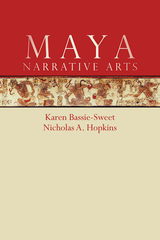 Maya Narrative Arts
Karen Bassie-Sweet
University Press of Colorado, 2018 In Maya Narrative Arts, authors Karen Bassie-Sweet and Nicholas A. Hopkins present a comprehensive and innovative analysis of the principles of Classic Maya narrative arts and apply those principles to some of the major monuments of the site of Palenque. They demonstrate a recent methodological shift in the examination of art and inscriptions away from minute technical issues and toward the poetics and narratives of texts and the relationship between texts and images.
Bassie-Sweet and Hopkins show that both visual and verbal media present carefully planned narratives, and that the two are intimately related in the composition of Classic Maya monuments. Text and image interaction is discussed through examples of stelae, wall panels, lintels, benches, and miscellaneous artifacts including ceramic vessels and codices. Bassie-Sweet and Hopkins consider the principles of contrast and complementarity that underlie narrative structures and place this study in the context of earlier work, proposing a new paradigm for Maya epigraphy. They also address the narrative organization of texts and images as manifested in selected hieroglyphic inscriptions and the accompanying illustrations, stressing the interplay between the two.
Arguing for a more holistic approach to Classic Maya art and literature, Maya Narrative Arts reveals how close observation and reading can be equally if not more productive than theoretical discussions, which too often stray from the very data that they attempt to elucidate. The book will be significant for Mesoamerican art historians, epigraphers, linguists, and archaeologists.
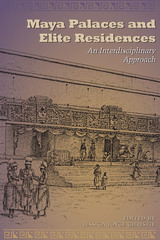 Maya Palaces and Elite Residences: An Interdisciplinary Approach
Edited by Jessica Joyce Christie
University of Texas Press, 2003 Maya "palaces" have intrigued students of this ancient Mesoamerican culture since the early twentieth century, when scholars first applied the term "palace" to multi-room, gallery-like buildings set on low platforms in the centers of Maya cities. Who lived in these palaces? What types of ceremonial and residential activities took place there? How do the physical forms and spatial arrangement of the buildings embody Maya concepts of social organization and cosmology? This book brings together state-of-the-art data and analysis regarding the occupants, ritual and residential uses, and social and cosmological meanings of Maya palaces and elite residences. A multidisciplinary team of senior researchers reports on sites in Belize (Blue Creek), Western Honduras (Copan), the Peten (Tikal, Dos Pilas, Aguateca), and the Yucatan (Uxmal, Chichen-Itza, Dzibilchaltun, Yaxuna). Archaeologist contributors discuss the form of palace buildings and associated artifacts, their location within the city, and how some palaces related to landscape features. Their approach is complemented by art historical analyses of architectural sculpture, epigraphy, and ethnography. Jessica Joyce Christie concludes the volume by identifying patterns and commonalties that apply not only to the cited examples, but also to Maya architecture in general.
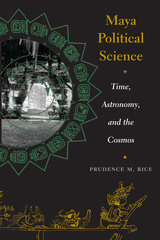 Maya Political Science: Time, Astronomy, and the Cosmos
By Prudence M. Rice
University of Texas Press, 2004 How did the ancient Maya rule their world? Despite more than a century of archaeological investigation and glyphic decipherment, the nature of Maya political organization and political geography has remained an open question. Many debates have raged over models of centralization versus decentralization, superordinate and subordinate status—with far-flung analogies to emerging states in Europe, Asia, and Africa. But Prudence Rice asserts that neither the model of two giant "superpowers" nor that which postulates scores of small, weakly independent polities fits the accumulating body of material and cultural evidence. In this groundbreaking book, Rice builds a new model of Classic lowland Maya (AD 179-948) political organization and political geography. Using the method of direct historical analogy, she integrates ethnohistoric and ethnographic knowledge of the Colonial-period and modern Maya with archaeological, epigraphic, and iconographic data from the ancient Maya. On this basis of cultural continuity, she constructs a convincing case that the fundamental ordering principles of Classic Maya geopolitical organization were the calendar (specifically a 256-year cycle of time known as the may) and the concept of quadripartition, or the division of the cosmos into four cardinal directions. Rice also examines this new model of geopolitical organization in the Preclassic and Postclassic periods and demonstrates that it offers fresh insights into the nature of rulership, ballgame ritual, and warfare among the Classic lowland Maya.
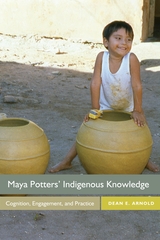 Maya Potters' Indigenous Knowledge: Cognition, Engagement, and Practice
Dean E. Arnold
University Press of Colorado, 2017 Based on fieldwork and reflection over a period of almost fifty years, Maya Potters’ Indigenous Knowledge utilizes engagement theory to describe the indigenous knowledge of traditional Maya potters in Ticul, Yucatán, Mexico. In this heavily illustrated narrative account, Dean E. Arnold examines craftspeople’s knowledge and skills, their engagement with their natural and social environments, the raw materials they use for their craft, and their process for making pottery. Following Lambros Malafouris, Tim Ingold, and Colin Renfrew, Arnold argues that potters’ indigenous knowledge is not just in their minds but extends to their engagement with the environment, raw materials, and the pottery-making process itself and is recursively affected by visual and tactile feedback. Pottery is not just an expression of a mental template but also involves the interaction of cognitive categories, embodied muscular patterns, and the engagement of those categories and skills with the production process. Indigenous knowledge is thus a product of the interaction of mind and material, of mental categories and action, and of cognition and sensory engagement—the interaction of both human and material agency. Engagement theory has become an important theoretical approach and “indigenous knowledge” (as cultural heritage) is the focus of much current research in anthropology, archaeology, and cultural resource management. While Dean Arnold’s previous work has been significant in ceramic ethnoarchaeology, Maya Potters' Indigenous Knowledge goes further, providing new evidence and opening up different concepts and approaches to understanding practical processes. It will be of interest to a wide variety of researchers in Maya studies, material culture, material sciences, ceramic ecology, and ethnoarchaeology.
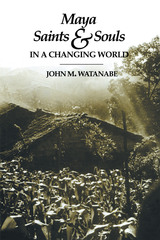 Maya Saints and Souls in a Changing World
By John M. Watanabe
University of Texas Press, 1992 The Maya of Santiago Chimaltenango have experienced increasingly rapid, even violent, integration into Guatemalan society in the last fifty years, yet they still distinguish themselves ethnically from Spanish-speaking Guatemalans and other Maya. Why this sense of ethnic identity persists—and also changes—over time is the focus of Maya Saints and Souls in a Changing World, a beautifully written ethnography of a Mam-speaking Maya town in the western highlands of Guatemala. John Watanabe uniquely explores how Chimaltecos themselves define their local distinctiveness. This approach uncovers significant continuities in lifeways and world view that might otherwise remain imperceptible to an outsider. Another important feature of the study is that it updates Charles Wagley's pioneering research in the community during the 1930s. Watanabe identifies both the external, historical factors that have prompted change in the community since Wagley's time and the people's responses to these changes.
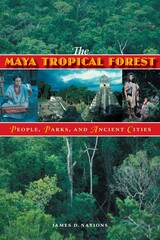 The Maya Tropical Forest: People, Parks, and Ancient Cities
By James D. Nations
University of Texas Press, 2006 The Maya Tropical Forest, which occupies the lowlands of southern Mexico, Guatemala, and Belize, is the closest rainforest to the United States and one of the most popular tourist destinations in the Western Hemisphere. It has been home to the Maya peoples for nearly four millennia, starting around 1800 BC. Ancient cities in the rainforest such as Palenque, Yaxchilan, Tikal, and Caracol draw thousands of tourists and scholars seeking to learn more about the prehistoric Maya. Their contemporary descendants, the modern Maya, utilize the forest's natural resources in village life and international trade, while striving to protect their homeland from deforestation and environmental degradation. Writing for both visitors and conservationists, James Nations tells the fascinating story of how ancient and modern Maya peoples have used and guarded the rich natural resources of the Maya Tropical Forest. He opens with a natural history that profiles the forest's significant animals and plants. Nations then describes the Maya peoples, biological preserves, and major archaeological sites in Mexico, Guatemala, and Belize. Drawing on more than twenty-five years of conservation work in the Maya Tropical Forest, Nations tells first-hand stories of the creation of national parks and other protected areas to safeguard the region's natural resources and archaeological heritage. He concludes with an expert assessment of the forest's future in which he calls for expanded archaeological tourism to create an ecologically sustainable economic base for the region.
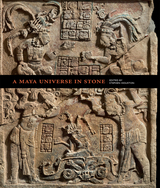 A Maya Universe in Stone
Stephen Houston
J. Paul Getty Trust, The, 2021 The first study devoted to a single sculptor in ancient America, as understood through four unprovenanced masterworks traced to a small sector of Guatemala.
In 1950, Dana Lamb, an explorer of some notoriety, stumbled on a Maya ruin in the tropical forests of northern Guatemala. Lamb failed to record the location of the site he called Laxtunich, turning his find into the mystery at the center of this book. The lintels he discovered there, long since looted, are probably of a set with two others that are among the masterworks of Maya sculpture from the Classic period. Using fieldwork, physical evidence, and Lamb’s expedition notes, the authors identify a small area with archaeological sites where the carvings were likely produced.
Remarkably, the vividly colored lintels, replete with dynastic and cosmic information, can be assigned to a carver, Mayuy, who sculpted his name on two of them. To an extent nearly unique in ancient America, Mayuy can be studied over time as his style developed and his artistic ambition grew. An in-depth analysis of Laxtunich Lintel 1 examines how Mayuy grafted celestial, seasonal, and divine identities onto a local magnate and his overlord from the kingdom of Yaxchilan, Mexico. This volume contextualizes the lintels and points the way to their reprovenancing and, as an ultimate aim, repatriation to Guatemala.
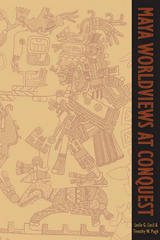 Maya Worldviews at Conquest
Leslie G. Cecil
University Press of Colorado, 2009 Maya Worldviews at Conquest examines Maya culture and social life just prior to contact and the effect the subsequent Spanish conquest, as well as contact with other Mesoamerican cultures, had on the Maya worldview. Focusing on the Postclassic and Colonial periods, Maya Worldviews at Conquest provides a regional investigation of archaeological and epigraphic evidence of Maya ideology, landscape, historical consciousness, ritual practices, and religious symbolism before and during the Spanish conquest. Through careful investigation, the volume focuses on the impact of conversion, hybridization, resistance, and revitalization on the Mayans’ understanding of their world and their place in it. The volume also addresses the issue of anthropologists unconsciously projecting their modern worldviews on the culture under investigation. Thus, the book critically defines and strengthens the use of worldviews in the scholarly literature regardless of the culture studied, making it of value not only to Maya scholars but also to those interested in the anthropologist’s projection of worldview on other cultures in general.
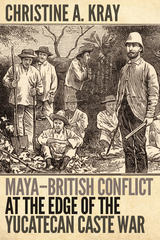 Maya-British Conflict at the Edge of the Yucatecan Caste War
Christine A. Kray
University Press of Colorado, 2023 Maya-British Conflict at the Edge of the Yucatecan Caste War interrogates the 1862 alliance forged between the San Pedro Maya and the British during the Caste War of Yucatán (1847–1901). Illuminating the complex interactions among Maya groups, Yucatecans of Spanish descent, and British settlers in what is now Belize, Christine A. Kray uses storytelling techniques, suspense, and humor, via historical documents and oral history interviews to tell a new story about the dynamics at the heart of the Social War.
Official British declarations of neutrality in the Caste War were confounded by a variety of political and economic factors, including competing land claims befuddled by a tangled set of treaties, mahogany extraction by British companies in contested territories, Maya rent demands, British trade in munitions to different groups of Maya combatants, and a labor system reliant on debt servitude. All these factors contributed to uneasy alliances and opportunistic crossings of imagined geopolitical borders in both directions, ultimately leading to a new military conflict in the western and northern regions of the territory claimed by Britain. What frequently began as hyper-local disputes spun out into international affairs as actors called upon more powerful groups for assistance. Evading reductionism, this work traces the decisions and actions of key figures as they maneuvered through the miasma of violence, abuse, deception, fear, flight, and glimpses of freedom.
Positioning the historiographic and ethnographic gaze on the English side without adopting the colonialist narratives and objectives found in English repositories, Maya-British Conflict at the Edge of the Yucatecan Caste War is an important and original contribution to a neglected area of study. It will appeal to students, scholars, and general readers interested in anthropology, Latin American cultures and history, Central American history, British imperialism, Indigenous rights, political anthropology, and colonialism and culture.
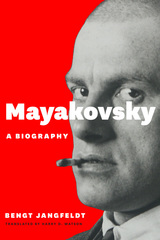 Mayakovsky: A Biography
Bengt Jangfeldt
University of Chicago Press, 2014 Few poets have led lives as tempestuous as that of Vladimir Mayakovsky. Born in 1893 and dead by his own hand in 1930, Mayakovsky packed his thirty-six years with drama, politics, passion, and—most important—poetry. An enthusiastic supporter of the Russian Revolution and the emerging Soviet State, Mayakovsky was championed by Stalin after his death and enshrined as a quasi-official Soviet poet, a position that led to undeserved neglect among Western literary scholars even as his influence on other poets has remained powerful.
With Mayakovsky, Bengt Jangfeldt offers the first comprehensive biography of Mayakovsky, revealing a troubled man who was more dreamer than revolutionary, more political romantic than hardened Communist. Jangfeldt sets Mayakovsky’s life and works against the dramatic turbulence of his times, from the aesthetic innovations of the pre-revolutionary avant-garde to the rigidity of Socialist Realism and the destruction of World War I to the violence—and hope—of the Russian Revolution, through the tightening grip of Stalinist terror and the growing disillusion with Russian communism that eventually led the poet to take his life.
Through it all is threaded Mayakovsky’s celebrated love affair with Lili Brik and the moving relationship with Lili’s husband, Osip, along with a brilliant depiction of the larger circle of writers and artists around Mayakovsky, including Maxim Gorky, Viktor Shklovsky, Alexander Rodchenko, and Roman Jakobson. The result is a literary life viewed in the round, enabling us to understand the personal and historical furies that drove Mayakovsky and generated his still-startling poetry.
Illustrated throughout with rare images of key characters and locations, Mayakovsky is a major step in the revitalization of a crucial figure of the twentieth-century avant-garde.
Mayakovsky: Plays
Vladimir Mayakovsky
Northwestern University Press, 1995 One of Russia's greatest poets, Vladimir Mayakovsky (1893–1930) was a Futurist, early Bolshevik, and champion of the avant-garde. Despite his revolutionary youth, he became increasingly disillusioned with Soviet society, and three of his plays—all banned until after Stalin's death—reflect his changing assessments of the Revolution.
Mayakovsky: Plays includes Mystery Bouffe, a mock medieval mystery written in 1918 to celebrate the first anniversary of the Revolution; The Bathhouse, a sharp attack on Soviet bureaucracy subtitled "a drama of circus and fireworks"; and The Bedbug, in which a worker with bourgeois pretensions is frozen and resurrected fifty years later, when the world has become a material paradise. The collection also includes Mayakovsky's more personal first play, Vladimir Mayakovsky: A Tragedy.
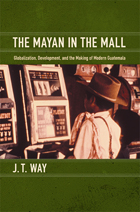 The Mayan in the Mall: Globalization, Development, and the Making of Modern Guatemala
J. T. Way
Duke University Press, 2012 In The Mayan in the Mall, J. T. Way traces the creation of modern Guatemala from the 1920s to the present through a series of national and international development projects. Way shows that, far from being chronically underdeveloped, this nation of stark contrasts—where shopping malls and multinational corporate headquarters coexist with some of the Western Hemisphere's poorest and most violent slums—is the embodiment of globalized capitalism. Using a wide array of historical and contemporary sources, Way explores the multiple intersections of development and individual life, focusing on the construction of social space through successive waves of land reform, urban planning, and economic policy. His explorations move from Guatemala City's poorest neighborhoods and informal economies (run predominantly by women) to a countryside still recovering from civil war and anti-Mayan genocide, and they encompass such artifacts of development as the modernist Pan-American Highway and the postmodern Grand Tikal Futura, a Mayan-themed shopping mall ringed by gated communities and shantytowns. Capitalist development, Way concludes, has dramatically reshaped the country's physical and social landscapes—engendering poverty, ethnic regionalism, and genocidal violence—and positioned Guatemala as a harbinger of globalization's future.
Mayan Texts: Volumes I, II, and III
Edited by Louanna Furbee-Losee
University of Chicago Press Journals, 1976 These volumes include oral texts in a variety of genres from 16 Mayan languages. Each of the stories in this collection is presented with analytical glosses, making explicit the structure of the language and illustrating the richness of Mayan grammar as it is used in context. These volumes will be of interest to linguists specializing in Mayan, typologists, and aficionados of oral narrative, as well as to speakers and learners of Mayan languages.
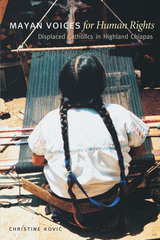 Mayan Voices for Human Rights: Displaced Catholics in Highland Chiapas
By Christine Kovic
University of Texas Press, 2005 In the last decades of the twentieth century, thousands of Mayas were expelled, often violently, from their homes in San Juan Chamula and other highland communities in Chiapas, Mexico, by fellow Mayas allied with the ruling Institutional Revolutionary Party (PRI). State and federal authorities generally turned a blind eye to these human rights abuses, downplaying them as local conflicts over religious conversion and defense of cultural traditions. The expelled have organized themselves to fight not only for religious rights, but also for political and economic justice based on a broad understanding of human rights. This pioneering ethnography tells the intertwined stories of the new communities formed by the Mayan exiles and their ongoing efforts to define and defend their human rights. Focusing on a community of Mayan Catholics, the book describes the process by which the progressive Diocese of San Cristóbal and Bishop Samuel Ruiz García became powerful allies for indigenous people in the promotion and defense of human rights. Drawing on the words and insights of displaced Mayas she interviewed throughout the 1990s, Christine Kovic reveals how the exiles have created new communities and lifeways based on a shared sense of faith (even between Catholics and Protestants) and their own concept of human rights and dignity. She also uncovers the underlying political and economic factors that drove the expulsions and shows how the Mayas who were expelled for not being "traditional" enough are in fact basing their new communities on traditional values of duty and reciprocity.
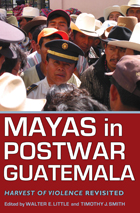 Mayas in Postwar Guatemala: Harvest of Violence Revisited
Edited by Walter E. Little and Timothy J. Smith
University of Alabama Press, 2009 Like the original Harvest of Violence, published in 1988, this volume reveals how the contemporary Mayas contend with crime, political violence, internal community power struggles, and the broader impact of transnational economic and political policies in Guatemala. However, this work, informed by long-term ethnographic fieldwork in Mayan communities and commitment to conducting research in Mayan languages, places current anthropological analyses in relation to Mayan political activism and key Mayan intellectuals’ research and criticism. Illustrating specifically how Mayas in this post-war period conceive of their social and political place in Guatemala, Mayas working in factories, fields, and markets, and participating in local, community-level politics provide critiques of the government, the Maya movement, and the general state of insecurity and social and political violence that they continue to face on a daily basis. Their critical assessments and efforts to improve political, social, and economic conditions illustrate their resiliency and positive, nonviolent solutions to Guatemala’s ongoing problems that deserve serious consideration by Guatemalan and US policy makers, international non-government organizations, peace activists, and even academics studying politics, social agency, and the survival of indigenous people. CONTRIBUTORS Abigail E. Adams / José Oscar Barrera Nuñez / Peter Benson / Barbara Bocek / Jennifer L. Burrell / Robert M. Carmack / Monica DeHart / Edward F. Fischer / Liliana Goldín / Walter E. Little / Judith M. Maxwell / J. Jailey Philpot-Munson / Brenda Rosenbaum / Timothy J. Smith / David Stoll
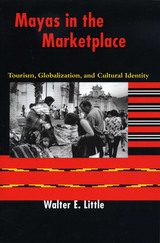 Mayas in the Marketplace: Tourism, Globalization, and Cultural Identity
By Walter E. Little
University of Texas Press, 2004 2005 — Best Book Award – New England Council of Latin American Studies Selling handicrafts to tourists has brought the Maya peoples of Guatemala into the world market. Vendors from rural communities now offer their wares to more than 500,000 international tourists annually in the marketplaces of larger cities such as Antigua, Guatemala City, Panajachel, and Chichicastenango. Like businesspeople anywhere, Maya artisans analyze the desires and needs of their customers and shape their products to meet the demands of the market. But how has adapting to the global marketplace reciprocally shaped the identity and cultural practices of the Maya peoples? Drawing on over a decade of fieldwork, Walter Little presents the first ethnographic study of Maya handicraft vendors in the international marketplace. Focusing on Kaqchikel Mayas who commute to Antigua to sell their goods, he explores three significant issues: - how the tourist marketplace conflates global and local distinctions.
- how the marketplace becomes a border zone where national and international, developed and underdeveloped, and indigenous and non-indigenous come together.
- how marketing to tourists changes social roles, gender relationships, and ethnic identity in the vendors' home communities.
Little's wide-ranging research challenges our current understanding of tourism's negative impact on indigenous communities. He demonstrates that the Maya are maintaining a specific, community-based sense of Maya identity, even as they commodify their culture for tourist consumption in the world market.
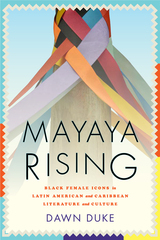 Mayaya Rising: Black Female Icons in Latin American and Caribbean Literature and Culture
Dawn Duke
Bucknell University Press, 2023 Who are the Black heroines of Latin America and the Caribbean? Where do we turn for models of transcendence among women of African ancestry in the region? In answer to the historical dearth of such exemplars, Mayaya Rising explores and celebrates the work of writers who intentionally center powerful female cultural archetypes. In this inventive analysis, Duke proposes three case studies and a corresponding womanist methodology through which to study and rediscover these figures. The musical Cuban-Dominican sisters and former slaves Teodora and Micaela Ginés inspired Aida Cartagena Portalatin’s epic poem Yania tierra; the Nicaraguan matriarch of the May Pole, “Miss Lizzie,” figures prominently in four anthologies from the country’s Bluefields region; and the iconic palenqueras of Cartagena, Colombia are magnified in the work of poets María Teresa Ramírez Neiva and Mirian Díaz Pérez. In elevating these figures and foregrounding these works, Duke restores and repairs the scholarly record.
Maybe
Alice Attie
Seagull Books, 2026 A collection of poems that explores transformation, dissolution, and renewal—and how language itself can become a site of regeneration.
The poems in Maybe form a tapestry of voices that slip from visibility to invisibility, illusion to disillusion, the conceivable to the inconceivable. Alice Attie writes of boundaries loosening, of transformations and transfigurations born of the unknown and the uncertain. Her poems suggest that this world will dissolve, and it will reappear as something other, something ineffable yet lodged in language, something fraught with an urgency that is both sublime and unbearable. Attie asks from what vantage point can the seer see, the writer write, the listener hear, learning ultimately that “for the length of my years to lengthen, I place the pebble on my tongue and rearrange the boundaries”?
Maybe It Was So
Reginald Gibbons
University of Chicago Press, 1991 Across a wide range of scenes, moments, and persons—from the American midwest to Spain and Vietnam, from early in the century to an imagined future, from lovers to refugees—Reginald Gibbons's poems explore the power of empathy to deepen and even transform our awareness and sense of purpose.
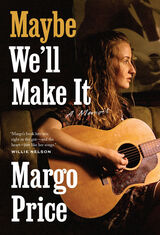 Maybe We'll Make It: A Memoir
Margo Price
University of Texas Press, 2022 An October 2022 IndieNext pick ”[An] engaging and beautifully narrated quest for personal fulfillment and musical recognition...This is a fast-paced tale in which music and love always take center stage...A truly gifted musician, Price writes about her journey with refreshing candor.”—Kirkus, starred review ”Brutally honest…a vivid and poignant memoir.”—The Guardian Country music star Margo Price shares the story of her struggle to make it in an industry that preys on its ingenues while trying to move on from devastating personal tragedies. When Margo Price was nineteen years old, she dropped out of college and moved to Nashville to become a musician. She busked on the street, played open mics, and even threw out her TV so that she would do nothing but write songs. She met Jeremy Ivey, a fellow musician who would become her closest collaborator and her husband. But after working on their craft for more than a decade, Price and Ivey had no label, no band, and plenty of heartache. Maybe We’ll Make It is a memoir of loss, motherhood, and the search for artistic freedom in the midst of the agony experienced by so many aspiring musicians: bad gigs and long tours, rejection and sexual harassment, too much drinking and barely enough money to live on. Price, though, refused to break, and turned her lowest moments into the classic country songs that eventually comprised the debut album that launched her career. In the authentic voice hailed by Pitchfork for tackling "Steinbeck-sized issues with no-bullshit humility," Price shares the stories that became songs, and the small acts of love and camaraderie it takes to survive in a music industry that is often unkind to women. Now an award-winning artist with a global fanbase, Price tells a love story of music, collaboration, and the struggle to build a career while trying to maintain her singular voice and style.
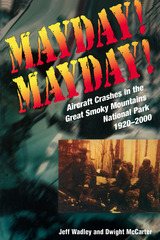 Mayday! Mayday!: Aircraft Crashes in the Great Smoky Mountains National Park, 1920-2000
Jeff Wadley
University of Tennessee Press, 2002 Mayday! Mayday!
Aircraft Crashes in the Great Smoky Mountains National Park, 1920–2000
Jeff Wadley and Dwight McCarter
Since the dawn of aviation, more than fifty aircraft have crashed in the Great Smoky Mountains. This book details all of those known incidents from 1920 to 2000, including those that occurred within the area before the establishment of the National Park in 1934. Jeff Wadley and Dwight McCarter, who have been involved in search-and-rescue missions in the Smokies for decades, have researched official documents and newspaper archives and conducted extensive interviews with survivors, family members, and eyewitnesses to record not only tragedies but also triumphs of survival.
The authors tell how the earliest known plane crashes in the Smokies were of the single-engine Curtis "Jenny" biplanes flown by young air aces during the World War I era. In the years since, the Smokies have claimed private planes, military jets, helicopters, and even a hot air balloon. These disasters arose from numerous causes—from fuel depletion and icing to "dare-deviling" or simply flying too low. Wadley and McCarter attest to the difficult duties of search-and-rescue teams in the most remote areas of the park. Of 127 persons involved in crashes, only 56 survived. Readers will be touched by these accounts—such as that of two small children who survived a December 1977 crash that killed their father and older sister.
Mayday! Mayday! offers both cautionary tales for pilots who fly above these ridges and seasoned advice to those who search for victims. The Smokies have been called by some another Bermuda Triangle; this book explains why and reminds us that no skies are entirely friendly.
The Authors: Jeff Wadley is a lieutenant colonel in the Tennessee Civil Air Patrol who serves as a mission coordinator and trainer in the Smokies.
Dwight McCarter served as a backcountry ranger in the park for over twenty years and is the author of Lost! A Ranger's Journal of Search and Rescue in the Great Smoky Mountains National Park.
 The Mayflies of North and Central America
George F. Edmunds Jr., Steven L. Jensen, and Lewis Berner
University of Minnesota Press, 1976
The Mayflies of North and Central America was first published in 1976. Minnesota Archive Editions uses digital technology to make long-unavailable books once again accessible, and are published unaltered from the original University of Minnesota Press editions.
Mayflies have fascinated man for centuries because of the brief span of their adult lives. These aquatic insects spend most of their lives as nymphs in water, then develop into winged stages and soon die, most species having an adult life of only two or three days. This brevity is implied in the very name of the order, Ephemeroptera.
The mayflies are almost worldwide in distribution, being found everywhere except in Antarctica, the extreme Arctic, and many small oceanic islands. All by three of the twenty families in the world occur in North or Central America, the regions covered in this volume. The book provides a modern, useful, and well-illustrated key to the adults and nymphs. Data on habitats, behavior, and life history are given for each genus. Characteristics of nymphs and adults are given for families, subfamilies, and genera, with brief accounts for extralimital families.
A discussion of methods of collecting and preserving specimens precedes the main portion of the text. The book is generously illustrated with drawings, photographs, and a map.
The role of aquatic insects as indicators of water pollution has received increasing attention, and in this connection this book will be of special interest to those concerned with pollution problems. Mayflies, besides indicating the presence of pollutants, also help remove such substances from the waters, the authors explain.
As a basic reference work, the book is essential for all biological science libraries. Many fly-fishermen are amateur students of mayflies, since the nymphs of larger species are used as bait. With the help of this volume the fisherman can acquire a greater knowledge of aquatic entomology and relate to his sport.
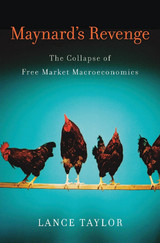 Maynard's Revenge: The Collapse of Free Market Macroeconomics
Lance Taylor
Harvard University Press, 2011 It is now widely agreed that mainstream macroeconomics is irrelevant and that there is need for a more useful and realistic economic analysis that can provide a better understanding of the ongoing global financial and economic crisis. Lance Taylor’s book exposes the unrealistic assumptions of the rational expectations and real business cycle approaches and of mainstream finance theory. It argues that in separating monetary and financial behavior from real behavior, they do not address the ways that consumption, accumulation, and the government play in the workings of the economy.
Taylor argues that the ideas of J. M. Keynes and others provide a more useful framework both for understanding the crisis and for dealing with it effectively. Keynes’s basic points were fundamental uncertainty and the absence of Say’s Law. He set up machinery to analyze the macro economy under such circumstances, including the principle of effective demand, liquidity preference, different rules for determining commodity and asset prices, distinct behavioral patterns of different collective actors, and the importance of thinking in terms of complete macro accounting schemes. Economists working in this tradition also worked out growth and cycle models.
Employing these ideas throughout Maynard’s Revenge, Taylor provides an analytical narrative about the causes of the crisis, and suggestions for dealing with it.
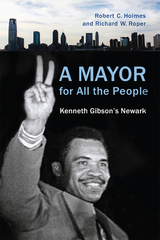 A Mayor for All the People: Kenneth Gibson's Newark
Robert C. Holmes
Rutgers University Press, 2020 2021 winner of Edited Works category: New Jersey Studies Academic Alliance
In 1970, Kenneth Gibson was elected as Newark, New Jersey’s first African-American mayor, a position he held for an impressive sixteen years. Yet even as Gibson served as a trailblazer for black politicians, he presided over a troubled time in the city’s history, as Newark’s industries declined and its crime and unemployment rates soared.
This book offers a balanced assessment of Gibson’s leadership and his legacy, from the perspectives of the people most deeply immersed in 1970s and 1980s Newark politics: city employees, politicians, activists, journalists, educators, and even fellow big-city mayors like David Dinkins. The contributors include many of Gibson’s harshest critics, as well as some of his closest supporters, friends, and family members—culminating in an exclusive interview with Gibson himself, reflecting on his time in office.
Together, these accounts provide readers with a compelling inside look at a city in crisis, a city that had been rocked by riots three years before Gibson took office and one that Harper’s magazine named “America’s worst city” at the start of his second term. At its heart, it raises a question that is still relevant today: how should we evaluate a leader who faced major structural and economic challenges, but never delivered all the hope and change he promised voters?
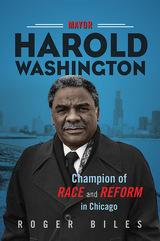 Mayor Harold Washington: Champion of Race and Reform in Chicago
Roger Biles
University of Illinois Press, 2020 Raised in a political family on Chicago's South Side, Harold Washington made history as the city's first African American mayor. His 1983 electoral triumph, fueled by overwhelming black support, represented victory over the Chicago Machine and business as usual. Yet the racially charged campaign heralded an era of bitter political divisiveness that obstructed his efforts to change city government. Roger Biles's sweeping biography provides a definitive account of Washington and his journey from the state legislature to the mayoralty. Once in City Hall, Washington confronted the back room deals, aldermanic thuggery, open corruption, and palm greasing that fueled the city's autocratic political regime. His alternative: a vision of fairness, transparency, neighborhood empowerment, and balanced economic growth at one with his emergence as a dynamic champion for African American uplift and a crusader for progressive causes. Biles charts the countless infamies of the Council Wars era and Washington's own growth through his winning of a second term—a promise of lasting reform left unfulfilled when the mayor died in 1987. Original and authoritative, Mayor Harold Washington redefines a pivotal era in Chicago's modern history.
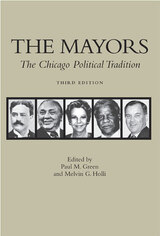 The Mayors, 3rd Edition: The Chicago Political Tradition
Edited by Paul M. Green and Melvin G. Holli
Southern Illinois University Press, 2005
The Mayors: The Chicago Political Tradition taps America’s most qualified observers to scrupulously assess the city’s mayors within the vigorous and tumultuous history of Chicago government. This revised and updated edition features extensive commentary on the enduring mayoral influence of Richard M. Daley.
“In the seventeen years since The Mayors was first published,” editors Paul M. Green and Melvin G. Holli write in the Preface to this edition, “Chicago politics has become more genteel, more docile, and more predictable. This dampening of the city’s once red-hot political coals is due to domination by one man: Mayor Richard M. Daley.” Also providing a political roadmap through the complex and fascinating labyrinth of Chicago politics are essays on other recent mayors: Richard J. Daley, Michael A. Bilandic, Jane M. Byrne, and Harold Washington.
Green and Holli’s popular study maintains that the key to the mayor’s office is power: the power to reward and the power to punish that comes with occupying the fifth floor of city hall in Chicago. Beginning with Joseph Medill, the Tribune publisher who guided the city in its rise from the ashes after the Great Fire of 1871, The Mayors takes readers through the terms of some of the city’s most colorful leaders: from the progressive Carter Harrison II and the radical Edward F. Dunne to the politically reticent Fred A. Busse and the loudmouth Big Bill Thompson. The essays collectively tell a riveting story of structures wherein aggressive power brokers surmount even massive corruption and scandal, and those who fail to seize the office’s inherent authority have short, uncomfortable tenures.
In addition to Green and Holli, contributors include David L. Protess, Edward R. Kantowicz, John D. Buenker, Maureen A. Flanagan, Douglas Bukowski, John R. Schmidt, Roger Biles, Arnold R. Hirsch, William J. Grimshaw, Monroe Anderson, Steve Neal, Steve Rhodes, and Laura S. Washington.
Mayors and Money: Fiscal Policy in New York and Chicago
Ester R. Fuchs
University of Chicago Press, 1992 Chicago and New York share similar backgrounds but have had strikingly different fates. Tracing their fortunes from the 1930s to the present day, Ester R. Fuchs examines key policy decisions which have influenced the political structures of these cities and guided them into, or clear of, periods of economic crisis.
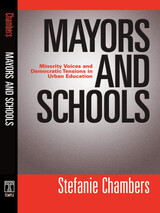 Mayors and Schools: Minority Voices and Democratic Tensions in Urban Education
Stefanie Chambers
Temple University Press, 2006 America's urban public schools are in crisis. Compared with their suburban counterparts, urban students have lower test scores and higher dropout rates. In an attempt to improve educational quality, responsibility for school governance has been handed over to mayors in several U.S. cities. Based on extensive research, including more than eighty in-depth interviews, Mayors and Schools examines whether mayoral control results in higher student achievement and considers the social costs of diminished community involvement. Using a comparative case study approach, Stefanie Chambers researches the impact of mayoral educational control in two big-city school districts, Chicago and Cleveland. On the whole, she finds, student test scores have improved since the takeovers but there are now fewer opportunities for grassroots participation in the educational system by minority community members. Chambers contends that these findings have important implications for democratic theory, arguing that urban schools cannot be successful in the long run without the active participation of local citizens.
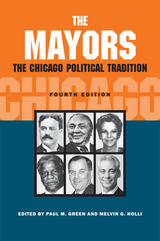 The Mayors: The Chicago Political Tradition, fourth edition
Edited by Paul M. Green and Melvin G. Holli
Southern Illinois University Press, 2013 Originally released in 1987, The Mayors: The Chicago Political Tradition gathered some of the finest minds in political thought to provide shrewd analysis of Chicago’s mayors and their administrations. Twenty-five years later, this fourth edition continues to illuminate the careers of some of Chicago’s most respected, forceful, and even notorious mayors, leaders whose lives were often as vibrant and eclectic as the city they served. In addition to chapters on the individual mayors—including a new chapter on Rahm Emanuel, enhanced by an expert explanation of the current state of the city’s budget by Laurence Msall, president of the Civic Federation—this new edition offers an insightful overview of the Chicago mayoral tradition throughout the city’s history; rankings of the mayors evaluated on their leadership and political qualities; an appendix of Chicago’s mayors and their years of service; and additional updated materials. Chicago’s mayoral history is one of corruption and reform, scandal and ambition. This well-researched volume, more relevant than ever twenty-five years after its first edition, presents an intriguing and informative glimpse into the fascinating lives and legacies of Chicago’s most influential leaders.
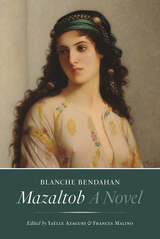 Mazaltob: A Novel
Blanche Bendahan
Brandeis University Press, 2024 A first-ever English translation of a compelling work by a forerunner of modern Sephardi feminist literature.
Raised in the Judería or Jewish quarter of Tetouan, Morocco, at the turn of the 20th-century, sixteen-year-old Mazaltob finds herself betrothed to José, an uncouth man from her own community who has returned from Argentina to take a wife. Mazaltob, however, is in love with Jean, who is French, half-Jewish, and a free spirit. In this classic of North African Jewish fiction, Blanche Bendahan evokes the two compelling forces tearing Mazaltob apart in her body and soul: her loyalty to the Judería and her powerful desire to follow her own voice and find true love. Bendahan’s nuanced and moving novel is a masterly exploration of the language, religion, and quotidian customs constraining North African Jewish women on the cusp of emancipation and decolonization. Yaëlle Azagury and Frances Malino provide the first English translation of this modern coming-of-age tale, awarded a prize by the Académie Française in 1930, and analyze the ways in which Mazaltob, with its disconcerting blend of ethnographic details and modernist experimentation, is the first of its genre—that of the feminist Sephardi novel. A historical introduction, a literary analysis, and annotations elucidate historical and cultural terms for readers, supplementing the author’s original notes.
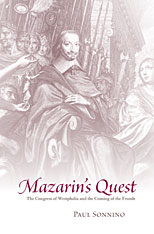 Mazarin’s Quest: The Congress of Westphalia and the Coming of the Fronde
Paul Sonnino
Harvard University Press, 2008 In a provocative study, Paul Sonnino examines the diplomatic negotiations that took place in Westphalia from 1643 to 1648, which brought an end to the agonizing civil and religious conflict of the Thirty Years’ War.
Sonnino steps back from myriad historical readings of Westphalia to take the diplomats’ intentions and interactions strictly on their own terms. He places the reader alongside the pivotal figure of French minister Jules Cardinal Mazarin as he maneuvers for gain. The narrative thus offers a firsthand experience of the negotiations as they played out, as well as a penetrating look into the character, personality, and ideas of the crafty cardinal. Although Mazarin acquired the province of Alsace—making him a hero to French nationalists—he had a much more successful peace within his grasp, but lost it when he insisted on annexing the Spanish Low Countries. Sonnino also offers a new interpretation of the origins of the Fronde, linking the French domestic revolt to foreign policy, in Mazarin’s failure to secure peace with Spain.
Based on unprecedented archival documentation, Mazarin’s Quest provides an original and illuminating look at one of the most complicated diplomatic gatherings of all time.
The Maze: A Desert Journey
Lucy Rees
University of Arizona Press, 1996 "Northern Arizona is vast and beautiful. Horizons are huge, for the dry air is so clear you can often see for eighty or a hundred miles. Mountains we would think to walk over in a day may be three days' hard ride away. There is space between each tuft of grass or cactus." With these words, Lucy Rees invites the reader to saddle up and travel with her across the desert to the Hopi Indian mesas. There, she and a companion are searching for an ancient stone carving similar to one in Cornwall, near their native Wales, that has long fascinated them. The intricate design of the stone, spiraling inward and then turning outward again, becomes a purpose for their trek as well as a metaphor for the journey itself. Humorous and wise, this book is both a bold adventure on horseback and a moving account of personal tragedy, courage, and hope.
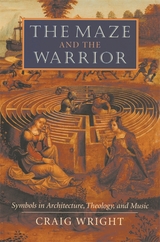 The Maze and the Warrior: Symbols in Architecture, Theology, and Music
Craig Wright
Harvard University Press, 2001 A tourist visiting the famous cathedral at Chartres might be surprised to discover an enormous labyrinth embedded in the thirteenth-century floor. Why is it there? In this fascinating book Craig Wright explores the complex symbolism of the labyrinth in architecture, religious thought, music, and dance from the Middle Ages to the present.
The mazes incorporated into church floors and illustrating religious books were symbolic of an epic journey through this sinful world to salvation. A savior figure typically led the way along this harrowing spiritual path. Wright looks at other meanings of the maze as well, from religious dancing on church labyrinths to pagan maze rituals outside the church. He demonstrates that the theme inherent in spiritual mazes is also present in medieval song, in the Armed Man Masses of the Renaissance, and in compositions of the Enlightenment, including the works of J. S. Bach. But the thread that binds the maze to the church, to music, and to dance also ties it to the therapeutic labyrinth that proliferates today. For as this richly interdisciplinary history reveals, the maze of the "new age" spiritualists also traces its lineage to the ancient myth of Theseus and the Minotaur. While the hero of the maze may change from one culture to the next, the symbol endures.
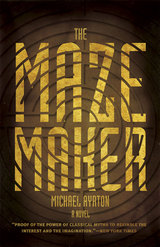 The Maze Maker: A Novel
Michael Ayrton
University of Chicago Press, 2015 “I address you across more than three thousand years, you who live at the conjunction of the Fish and the Water-carrier,” speaks Daedalus, an artisan, inventor, and designer born into an utterly alien family of heroes who value acts of war above all else, a world where his fellow Greeks seem driven only to destroy—an existence he feels compelled to escape.
In this fictional autobiography of the father of Icarus, “Apollo’s creature,” a brilliant but flawed man, writer and sculptor Michael Ayrton harnesses the tales of the past to mold a myth for our times. We learn of Daedalus’s increasingly ambitious artifacts and inventions; his fascination with Minoan culture, commerce, and religion, and his efforts to adapt to them; how he comes to design the maze of the horned Minotaur; and how, when he decides that he must flee yet again, he builds two sets of wax wings—wings that will be instruments of his descent into the underworld, a place of both purgatory and rebirth.
A compelling mix of history, fable, lore, and meditations on the enigma of art, The Maze Maker will ensnare classicists, artists, and all lovers of story in its convolutions of life and legend. “I never understood the pattern of my life,” writes Daedalus, “so that I have blundered through it in a maze.”
 The Maze of Urban Housing Markets: Theory, Evidence, and Policy
Jerome Rothenberg, George C. Galster, Richard V. Butler, and John R. Pitkin
University of Chicago Press, 1991 This powerful new theoretical approach to analyzing urban housing problems and the policies designed to rectify them will be a vital resource for urban planners, developers, policymakers, and economists. The search for the roots of serious urban housing problems such as homelessness, abandonment, rent burdens, slums, and gentrification has traditionally focused on the poorest sector of the housing market. The findings set forth in this volume show that the roots of such problems lie in the relationships among different parts of the market—not solely within the lower-quality portion—though that is where problems are most dramatically manifested and housing reforms are myopically focused.
The authors propose a new understanding of the market structure characterized by a closely interrelated array of quality submarkets. Their comprehensive models ground a unified theory that accounts for demand by both renters and owner occupants, supply by owners of existing dwellings, changes in the stock of housing due to conversions and new construction, and interactions across submarkets.
Mazel
Rebecca Goldstein
University of Wisconsin Press, 2002 Mazel means luck in Yiddish, and luck is the guiding force in this magical and mesmerizing novel that spans three generations. Sasha Saunders is the daughter of a Polish rabbi who abandons the shtetl and wins renown as a Yiddish actress in Warsaw and New York. Her daughter Chloe becomes a professor of classics at Columbia. Chloe’s daughter Phoebe grows up to become a mathematician who is drawn to traditional Judaism and the sort of domestic life her mother and grandmother rejected.
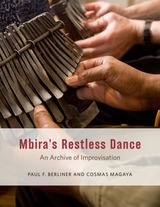 Mbira's Restless Dance: An Archive of Improvisation
Paul F. Berliner and Cosmas Magaya
University of Chicago Press, 2020 Growing out of the collaborative research of an American ethnomusicologist and Zimbabwean musician, Paul F. Berliner and Cosmas Magaya’s Mbira’s Restless Dance documents the repertory for a keyboard instrument known generally as mbira. At the heart of this work lies the analysis of the improvisatory processes that propel mbira music’s magnificent creativity.
Mbira’s Restless Dance is written to be played. This two-volume, spiral-bound set features musical transcriptions of thirty-nine compositions and variations, annotated with the master player’s advice on technique and performance, his notes and observations, and commentary by Berliner. Enhanced with extensive website audiovisuals, Mbira’s Restless Dance is in effect a series of masterclasses with Magaya, suitable for experienced mbira players and those learning the fundamentals.
Together with Berliner's The Art of Mbira, in which he provides an indispensable historical and cultural guide to mbira in a changing world, Mbira's Restless Dance breaks new ground in the depth and specificity of its exploration of an African musical tradition, and in the entwining of the authors’ collaborative voices. It is a testament to the powerful relationship between music and social life—and the rewards of lifelong musical study, performance, and friendship.
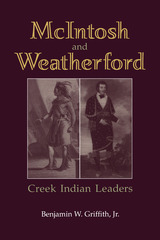 McIntosh and Weatherford: Creek Indian Leaders
Benjamin W. Griffith
University of Alabama Press, 1998 Explores the personal meaning of US Indian removal policy
About the time of the American Revolutionary war, when the Creek Indians owned land that is today approximately the lower two-thirds of Alabama and of Georgia west of the Oconee River, two sons were born to Indian mothers and Scots fathers in obscure towns in the territory of the Creek Nation. Both sons were named William, and both were to become leaders of their mothers’ people.
The two remarkable men lived during a period of war and turbulence along the frontier in Alabama and Georgia. More often the subjects of folk tale and legend than serious historical inquiry, McIntosh and Weatherford fought on opposing sides in the Creek War of 1813-1814. McIntosh allied himself with Andrew Jackson and the friendly Lower Creeks, while Weatherford joined with the hostile Red Stick and was the leader of a band of Upper Creeks in the massacre at Fort Mims. McIntosh, who was given the rank of brigadier general for his military feats, was involved in the machinations that led to the ceding of Creek lands to Georgia. As a result, he died in disgrace at the hands of his fellow Creeks. Weatherford, once hated and feared, died a planter and local hero in Alabama near the site of Fort Mims.
McKay's Bees: A Novel
Thomas McMahon
University of Chicago Press, 2003 Moving from Massachusetts to Kansas in 1855 with his new wife and a group of German carpenters, Gordon McKay is dead set on making his fortune raising bees—undaunted by Missouri border ruffians, newly-minted Darwinism, or the unsettled politics of a country on the brink of civil war.
|
|

